-
 Click here for biographical details and other works by the artist. Clifford and Rosemary Ellis were famous as a husband and wife team for their fascination with nature and their vibrant and charming depictions of animals. They were the natural artists to be commissioned by Collins for their ‘New Naturalists’ series of books, which have become famous and highly collectable more for the dust jackets designed by the Ellises than for the – otherwise excellent – content. This painting is from a recently discovered series of paintings and drawings, never before seen by the general public, dating from the 1940s and 1950s. If you are interested email info@manningfineart.co.uk or call us on 07929 749056. Condition: Generally very Good.
Click here for biographical details and other works by the artist. Clifford and Rosemary Ellis were famous as a husband and wife team for their fascination with nature and their vibrant and charming depictions of animals. They were the natural artists to be commissioned by Collins for their ‘New Naturalists’ series of books, which have become famous and highly collectable more for the dust jackets designed by the Ellises than for the – otherwise excellent – content. This painting is from a recently discovered series of paintings and drawings, never before seen by the general public, dating from the 1940s and 1950s. If you are interested email info@manningfineart.co.uk or call us on 07929 749056. Condition: Generally very Good. -
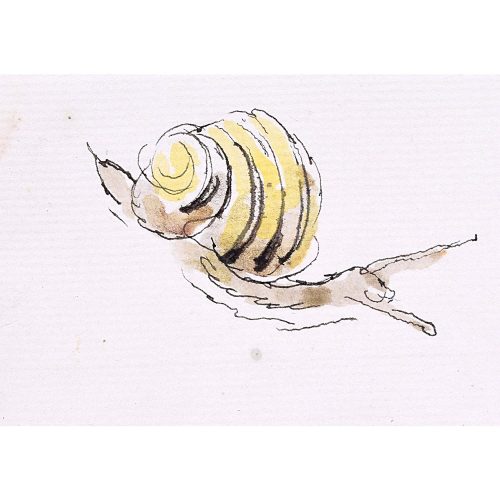
Rosemary Ellis (1910-1988) Snail XV
7.5x5.5cm Pen, ink and watercolour On antique laid paper, watermarked 'T Edmonds 1814' Provenance: the family of the artist, by descent.Click here for biographical details and other works by the artist. Clifford and Rosemary Ellis were famous as a husband and wife team for their fascination with nature and their vibrant and charming depictions of animals. They were the natural artists to be commissioned by Collins for their ‘New Naturalists’ series of books, which have become famous and highly collectable more for the dust jackets designed by the Ellises than for the – otherwise excellent – content. This painting is from a recently discovered series of paintings and drawings, never before seen by the general public, dating from the 1940s and 1950s. If you are interested email info@manningfineart.co.uk or call us on 07929 749056. Condition: Generally very Good. -
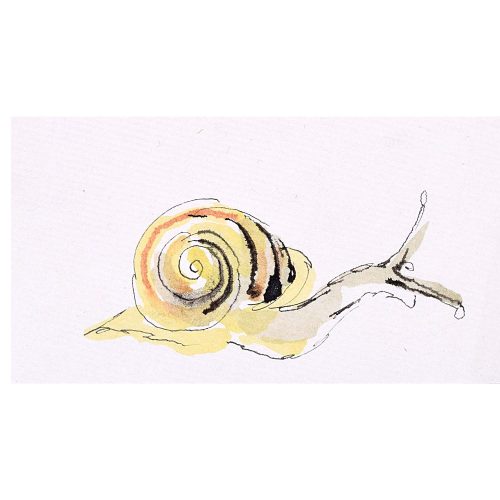
Rosemary Ellis (1910-1988) Snail XVI
4x7cm Pen, ink and watercolour On antique laid paper, watermarked 'T Edmonds 1814' Provenance: the family of the artist, by descent.Click here for biographical details and other works by the artist. Clifford and Rosemary Ellis were famous as a husband and wife team for their fascination with nature and their vibrant and charming depictions of animals. They were the natural artists to be commissioned by Collins for their ‘New Naturalists’ series of books, which have become famous and highly collectable more for the dust jackets designed by the Ellises than for the – otherwise excellent – content. This painting is from a recently discovered series of paintings and drawings, never before seen by the general public, dating from the 1940s and 1950s. If you are interested email info@manningfineart.co.uk or call us on 07929 749056. Condition: Generally very Good. -
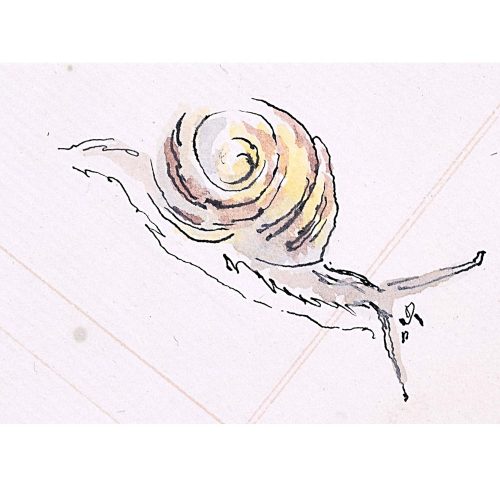
Rosemary Ellis (1910-1988) Snail XVII
5x7cm Pen, ink and watercolour On antique laid paper, watermarked 'T Edmonds 1814' Provenance: the family of the artist, by descent.Click here for biographical details and other works by the artist. Clifford and Rosemary Ellis were famous as a husband and wife team for their fascination with nature and their vibrant and charming depictions of animals. They were the natural artists to be commissioned by Collins for their ‘New Naturalists’ series of books, which have become famous and highly collectable more for the dust jackets designed by the Ellises than for the – otherwise excellent – content. This painting is from a recently discovered series of paintings and drawings, never before seen by the general public, dating from the 1940s and 1950s. If you are interested email info@manningfineart.co.uk or call us on 07929 749056. Condition: Generally very Good. -
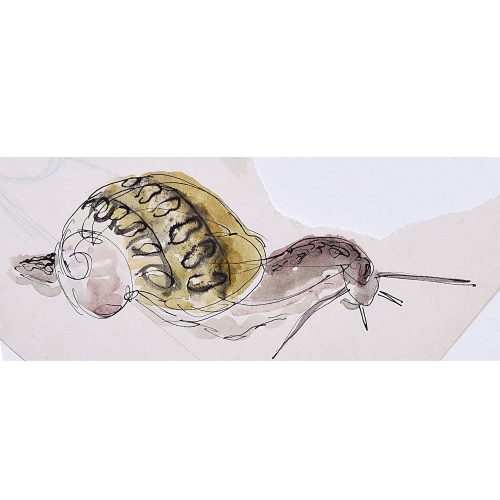
Rosemary Ellis (1910-1988) Snail XVIII
7.5x18cm Pen, ink and watercolour On antique laid paper, watermarked 'T Edmonds 1814' Provenance: the family of the artist, by descent.Click here for biographical details and other works by the artist. Clifford and Rosemary Ellis were famous as a husband and wife team for their fascination with nature and their vibrant and charming depictions of animals. They were the natural artists to be commissioned by Collins for their ‘New Naturalists’ series of books, which have become famous and highly collectable more for the dust jackets designed by the Ellises than for the – otherwise excellent – content. This painting is from a recently discovered series of paintings and drawings, never before seen by the general public, dating from the 1940s and 1950s. If you are interested email info@manningfineart.co.uk or call us on 07929 749056. Condition: Generally very Good. -
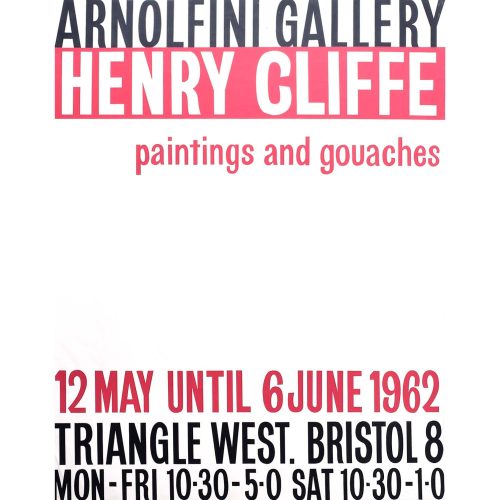
Henry Cliffe (1919-1983) Arnolfini Gallery Poster
Etching Mid 20th Century 63.5x51cm Click here for biographical details and other pictures by the artist. If you are interested email info@manningfineart.co.uk or call us on 07929 749056. Condition: Good, some faint spots at top. -
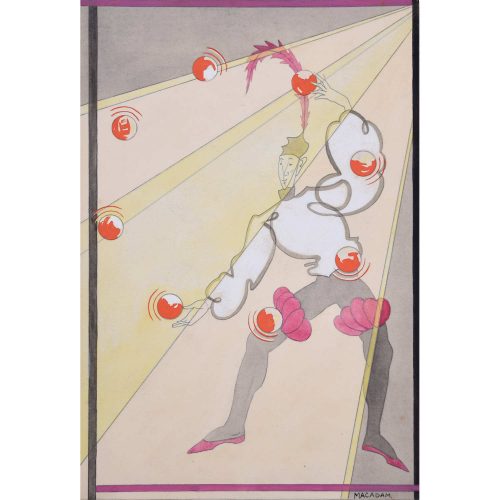
Margaret Macadam (1902-1991)
Juggler
Watercolour drawing, signed lower right 26cm x 18cm In The Barbarians (1935), set in Paris and on the Riviera in 1922, Virginia Faulkner sets out her account of the Bohemian life of expats and war veterans. The Barbarians, a loose cluster of creative types, comprised painters, a sculptor, a writer, a pianist, and a gigolo. Faulker was only 22 when she wrote the book. Margaret Macadam was a British illustrator active in the 1920s and 1930s. She won a scholarship to the Royal Academy schoos in 1925. Amongst her commercial works are several dust wrapper designs for London-based publishers, including the dust-jacket design for the first edition of Agatha Christie’s first straight novel ‘Giant’s Bread’. Following the discovery of an archive of Macadam’s work in 2016, it was possible to connect her work on Giant’s Bread to other known designs. Condition: Excellent. If you’d like to know more, please email info@manningfineart.co.uk or call us on 07929 749056. -
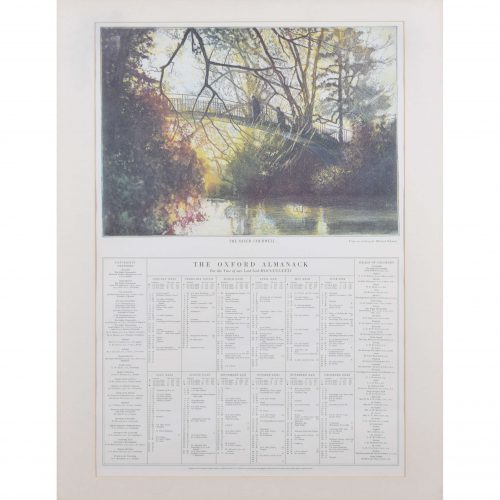
after Michael Oelman (born 1941)
The River Cherwell, The Oxford Almanac 1981
Lithograph 71 x 47 cm A lithograph featuring Oxford's wondrous River Cherwell in University Parks, after an etching by Michael Oelman. A setting sun casts its gold light over the glassy surface of the river and its surrounding trees; two figures cross the Cherwell via the famous Rainbow Bridge. The curved footbridge was built in the early 1920s by the University a project for the unemployed. Oelman's etching was reproduced as a lithograph in 1981, to be published in the "Oxford Almanack". The Oxford Almanack was an annual almanac published by the Oxford University Press for the University of Oxford from 1674 through 2019 (when printing sadly ceased due to "dwindling interest"). The almanac traditionally included engravings or lithographs of the University and information about the upcoming year. Other almanac artists have included James Basire, Michael Burghers, J. M. W. Turner, and John Piper. Michael Oelman was born in Llandudno, Wales, in 1941. He studied fine art at Reading University and then etching and lithography at the Central and Slade Schools of Art. In the 1960s he studied with S. W. Hayter in Paris, and then became a lecturer in Printmaking at Doncaster College of Art, Yorkshire. His studio is in Suffolk. Condition: very good. If you are interested, please email info@manningfineart.co.uk or call us on 07929 749056. Click here for other general views of Oxford. -
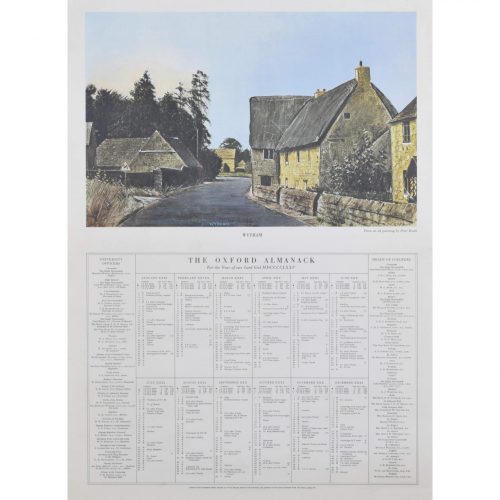
after Peter Brook (1927 - 2009)
Wytham - Oxford Almanack 1975
Lithograph 70 x 48 cm A lithograph of Wytham, a characterful and historic village north-west of Oxford. The original painting hangs in the Ashmolean Museum. Brook's painting was reproduced as a lithograph in 1975 to be published in the "Oxford Almanack". The Oxford Almanack was an annual almanack published by the Oxford University Press for the University of Oxford from 1674 through 2019 (when printing sadly ceased due to "dwindling interest"). The almanack traditionally included engravings or lithographs of the University and information about the upcoming year. Other almanack artists have included James Basire, Michael Burghers, J. M. W. Turner, and Michael Oelman. Peter Brook RBA was an English artist best known for his landscape paintings; he was nicknamed "The Pennine Landscape Painter". He was elected to the Royal Society of British Artists in 1962. Condition: very good. If you are interested, please email info@manningfineart.co.uk or call us on 07929 749056. Click here for other general views of Oxford. -
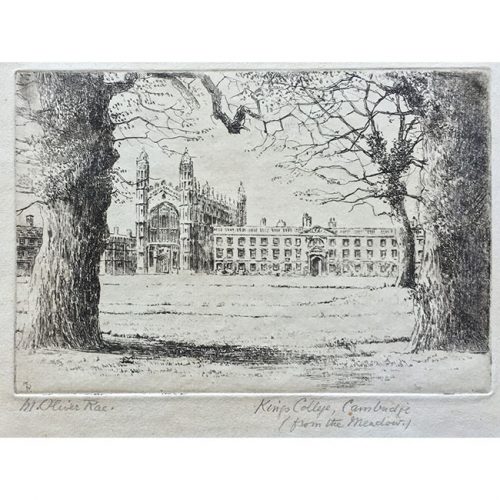
Mabel Oliver Rae (1868-1956)
King's College Chapel from the Meadows
Engraving 12x17.5cm Click here for biographical details and other pictures by the artist. If you are interested email info@manningfineart.co.ukor call us on 07929 749056. -

M Oliver Rae
All Souls, Oxford
Engraving 22.5x15cm Click here for biographical details and other pictures by the artist. If you are interested email info@manningfineart.co.uk or call us on 07929 749056. -
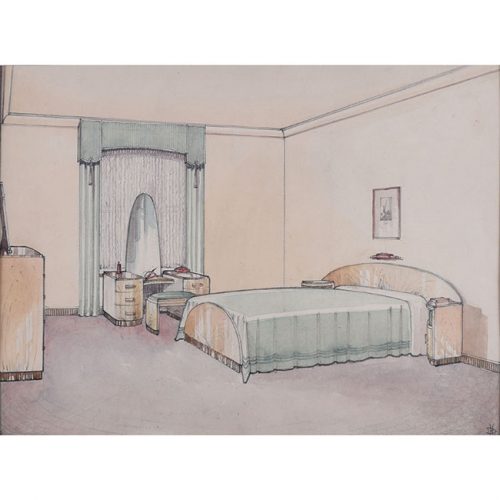
D L Hadden
Bedroom Interior
Pencil and watercolour 23x31.5cm For biographical details and other works by the artist click here. If you are interested email info@manningfineart.co.uk or call us on 07929 749056. -
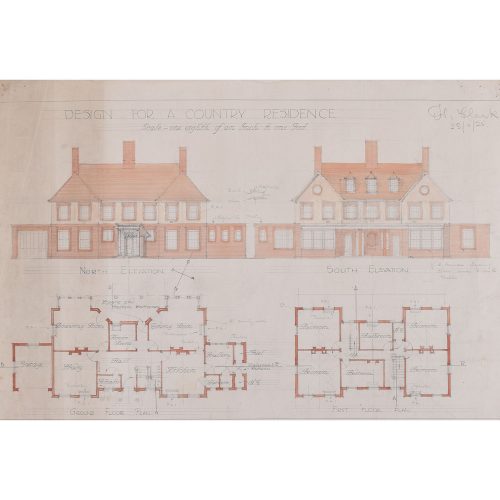
Hubert H. Clark
Design for a Country House (1947)
Watercolour and pencil 33x53cm If you are interested email info@manningfineart.co.uk or call us on 07929 749056. -
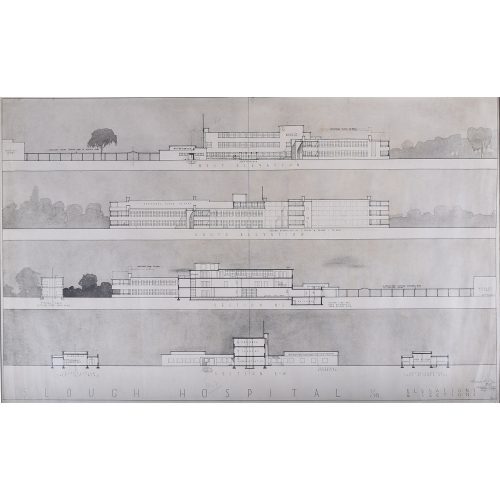
Hubert H. Clark
Design for Slough Hospital
Original print 33x53cm If you are interested email info@manningfineart.co.uk or call us on 07929 749056. -
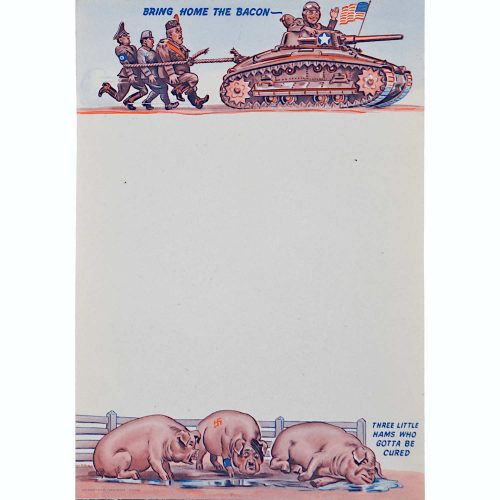
Porto-Service, Chicago Bring Home the Bacon - three little hams who gotta be cured!
Lithograph 26.5x18cm 1942 What better writing paper to send to a serving serviceman than that encouraging him to fight. Porto-Service of Chicago published a series of illustrated writing resources for sweethearts and friends to write to their brave servicemen, in this case teasing the three Axis dictators. Lavishly produced and printed, the Americans brought some much-needed colour and glamour to dull war-torn Britain. If you are interested email info@manningfineart.co.uk or call us on 07929 749056. -
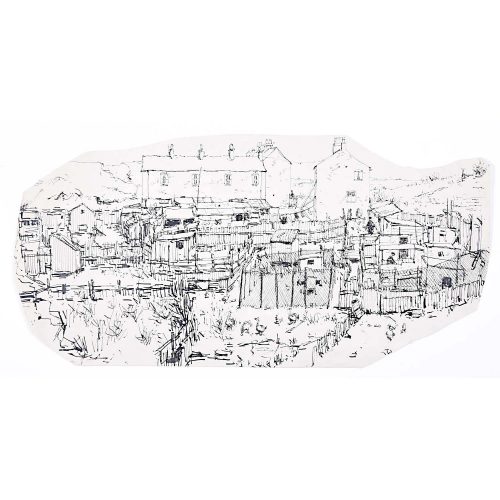
Peter Collins ARCA (1923-2001) Town scene
Pen and ink 21x44cm (irregular) Provenance: The Artist's Studio As a graphic designer, Collins produced many drawings such as these and we invite you to look at our other drawings and sketches by him. If you are interested email info@manningfineart.co.uk or call us on 07929 749056. Condition: Good, size is irregular. Click here for other items by the artist and for biographical details. -
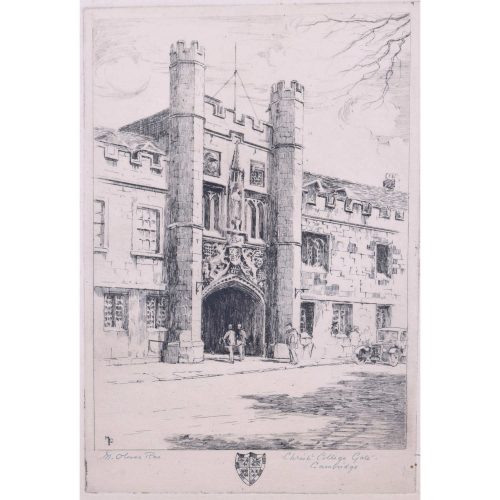
Mabel Oliver Rae (1868-1956) Christ's College Cambridge Great Gate
Etching 27x18cm Click here for biographical details and other pictures by the artist. If you are interested email info@manningfineart.co.uk or call us on 07929 749056. Condition: Good. -
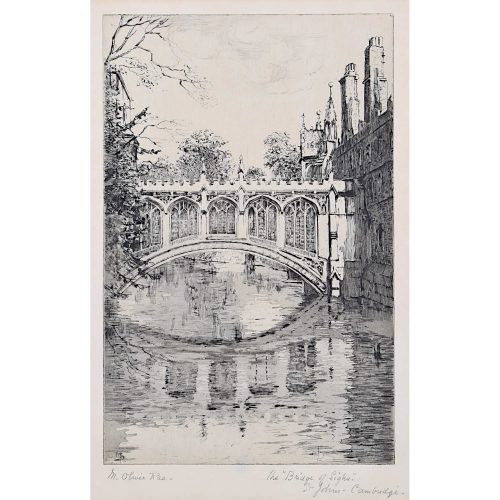
Mabel Oliver Rae (1868-1956) Bridge of Sighs St John's College Cambridge
Etching 30x19 cm Click here for biographical details and other pictures by the artist. If you are interested email info@manningfineart.co.uk or call us on 07929 749056. Condition: Good. -
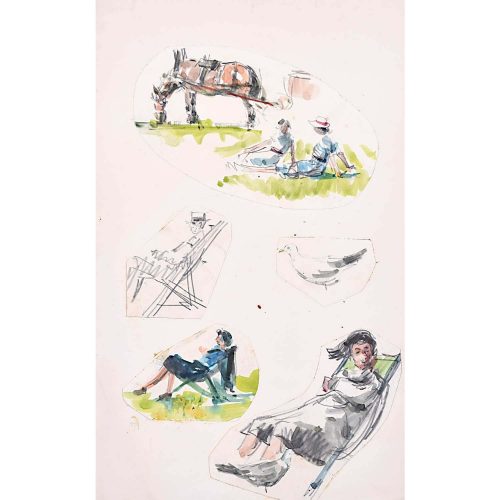
Peter Collins ARCA (1923-200 Elegant Figures in Deckchairs with Boaters and Hats
Mixed Media, Collage, Watercolour, Pencil etc. 29x18cm Provenance: The Artist's Studio As a graphic designer, Collins produced many drawings such as these and we invite you to look at our other drawings and sketches by him. Click here for other items by the artist and for biographical details. If you are interested email info@manningfineart.co.uk or call us on 07929 749056. -
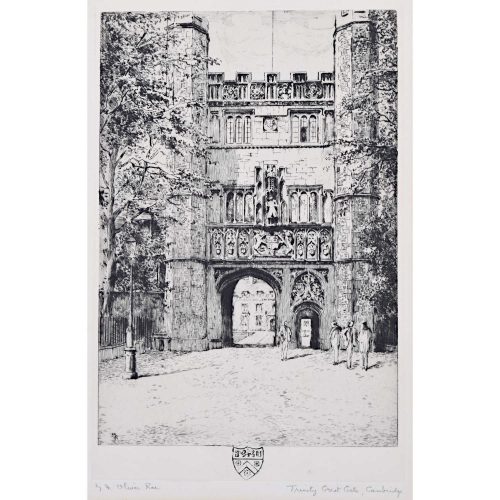
Mabel Oliver Rae ((1868-1956) Trinity College Cambridge Great Gate
Etching 28x18 cm The rich tones of the etchings make them as popular today as when they were first made. Click here for biographical details and other pictures by the artist. If you are interested email info@manningfineart.co.uk or call us on 07929 749056. Condition: Generally very good. -
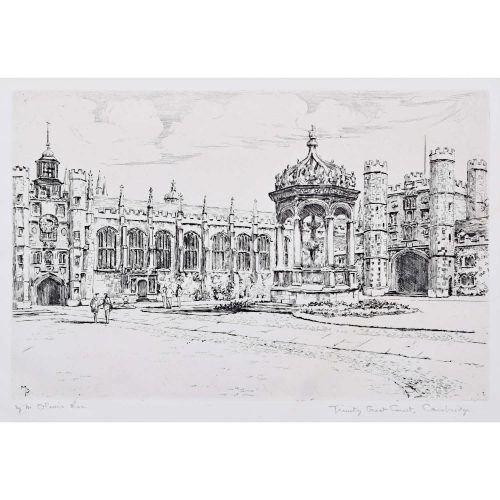
Mabel Oliver Rae ((1868-1956) Trinity College Cambridge Great Court
Etching 20x27 cm The rich tones of the etchings make them as popular today as when they were first made. Click here for biographical details and other pictures by the artist. If you are interested email info@manningfineart.co.uk or call us on 07929 749056. Condition: Generally very good. -
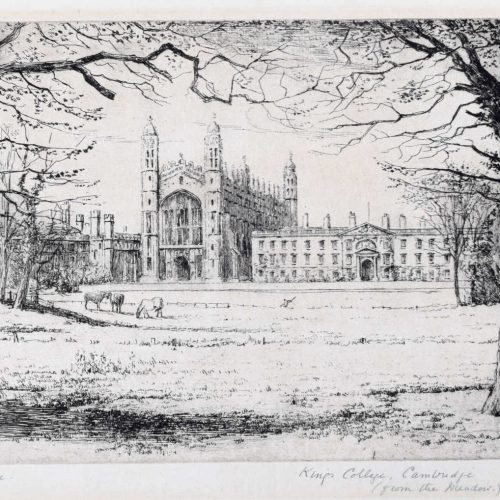
Mabel Oliver Rae (1868-1956)
Kings College Cambridge from the Meadow (c.1920)
27 x 39.5 cm Etching Unmounted Mabel Oliver Rae was born in Cambridge, Cambridgeshire, and trained at the Slade School of Fine Art between 1888 and 1890. Rae is known for her skilled etchings of various rural scenes and townscapes, particularly those of the colleges of Oxford and Cambridge. She signed works with the pseudonym 'M.Oliver Rae', a ruse to conceal the fact she was a female artist, so as not to reduce her chances with commercial dealers and agents. Condition: Generally very good. Mount burn to edges which will be hidden under a new mount. Tiny spot to bottom right margin below tree as visible. -

Laurence Dunn (1910-2006)
Port of London Authority 'PLA' Monstrosity Boat Drawing (c.1950s)
17 x 22.5 cm Signed Pencil drawing of PLA ship before industrial plant, inscribed 'PLA Monstrosity.' Dunn was a well known marine artist and writer. The World Ship Society published the following obituary for Dunn. DUNN, Laurence. [December 15 2006 — Lloyds List] Many readers will be saddened by the death of well-known marine artist and writer Laurence Dunn in his 97th year. A man of encyclopaedic knowledge, he began his lifelong love of ships in Brixham, where he meticulously recorded passing traffic with the exquisitely accurate line drawings which later became something of a trademark. While studying at London’s Central School of Art his work was noticed by the Southern Railway, which commissioned profiles of its fleet, and this in turn led to work for Orient Line, where he also designed the well-known corn-coloured hull, and later Thorneycroft, where he helped with shaping draft plans for a new royal yacht. During the second world was he worked for naval intelligence at the Admiralty, where his technique did much to improve recognition standards, and greatly expanded his shipping clientele, becoming personally known to many chairmen. As well as the shipping press he worked for mainstream publications such as Everybody’s, Sphere and the upmarket comic Eagle. Through his many contacts he enjoyed going to sea in a great variety of ships from aircraft carriers to colliers. Laurence wrote several books, starting with ship recognition titles which introduced new standards of layout, but his best known work was probably Passenger Liners, which was widely taken up by the travel trade. His love of Greece, where he was an early publicist of island cruising, let to involvement in reshaping various passenger liners beginning with Greek Line’s OLYMPIA. In later life he designed several sets of shipping stamps for the Crown Agents, produced photographic volumes on Thames and Mediterranean shipping and still found time to enjoy the passing Thames traffic. Our sympathies go to his wife Jennifer, who provided succour to the many ship lovers who beat a path to the welcoming door of their Gravesend home. -
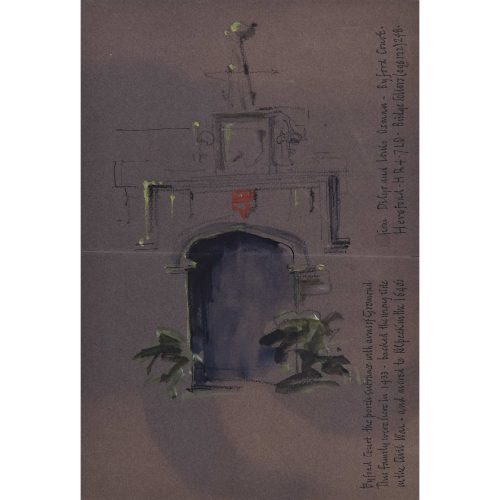 Louis Osman (1914-1996) Christmas Card, Byford Court, 1985 22 x 31cm Gouache and ink on paper This characterful card was sent by Louis Osman and his wife Dilys, whom he had married in 1940. Written and painted in 1985, it features an ink sketch and gouache painting of the porch entrance to Byford Court, with handwritten notes about the house's significance. Osman moved to Byford Court in 1976, following a brief brush with bankruptcy. Osman attended the Bartlett School of Architecture and the Slade School of Art, and became a Donaldson Medallist of RIBA in 1935. In the late 1930s he took part in the British Museum and British School of Archaeology expeditions to Syria. After war service he worked in London designing buildings, furniture, tapestries, and glass including work in Westminster Abbey, Lincoln, Ely, Exeter and Lichfield Cathedrals. He also did work for the National Trust at Staunton Harold Church in Ashby de la Zouch. Before moving to Byford Court, Osman and his wife lived at Canons Ashby House in Northamptonshire. Whilst there, they made the crown used at the investiture of Charles, Prince of Wales. In 1976, they also made the gold enamelled casket holding the Magna Carta on view in the United States Capitol, Washington, DC for the United States Bicentennial. Some discolouration to paper.
Louis Osman (1914-1996) Christmas Card, Byford Court, 1985 22 x 31cm Gouache and ink on paper This characterful card was sent by Louis Osman and his wife Dilys, whom he had married in 1940. Written and painted in 1985, it features an ink sketch and gouache painting of the porch entrance to Byford Court, with handwritten notes about the house's significance. Osman moved to Byford Court in 1976, following a brief brush with bankruptcy. Osman attended the Bartlett School of Architecture and the Slade School of Art, and became a Donaldson Medallist of RIBA in 1935. In the late 1930s he took part in the British Museum and British School of Archaeology expeditions to Syria. After war service he worked in London designing buildings, furniture, tapestries, and glass including work in Westminster Abbey, Lincoln, Ely, Exeter and Lichfield Cathedrals. He also did work for the National Trust at Staunton Harold Church in Ashby de la Zouch. Before moving to Byford Court, Osman and his wife lived at Canons Ashby House in Northamptonshire. Whilst there, they made the crown used at the investiture of Charles, Prince of Wales. In 1976, they also made the gold enamelled casket holding the Magna Carta on view in the United States Capitol, Washington, DC for the United States Bicentennial. Some discolouration to paper. -
Out of stock
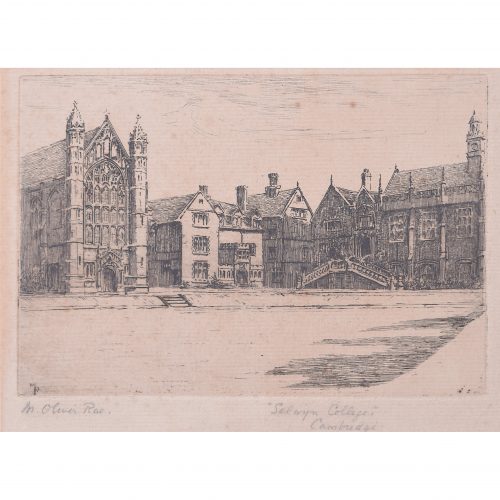
Mabel Oliver Rae
Selwyn College, Cambridge
Etching, circa 1920 19 x 29 cm Hand-signed in pencil lower left, and titled in pencil lower right. Initialled 'MR' in plate. Mabel Oliver Rae was born in Cambridge, Cambridgeshire, and trained at the Slade School of Fine Art between 1888 and 1890. Rae is known for her skilled etchings of various rural scenes and townscapes, particularly those of the colleges of Oxford and Cambridge. She signed works with the pseudonym 'M.Oliver Rae', a ruse to conceal the fact she was a female artist, so as not to reduce her chances with commercial dealers and agents. Condition: Good. Even age toning, a little spotting, generally good. -
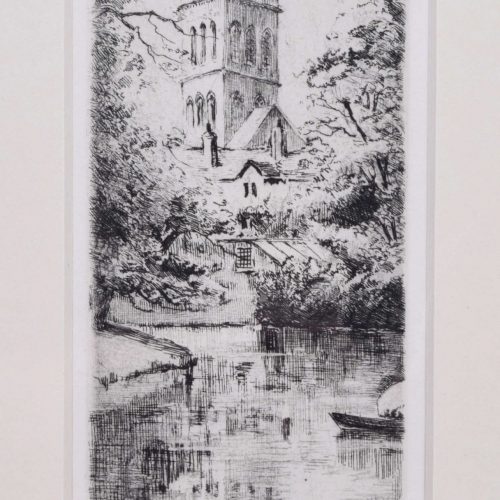
Mabel Oliver Rae
Chapel Tower of St John's College, Cambridge
Etching, circa 1920 19 x 7 cm Hand-signed in pencil lower left, and titled in pencil lower right. Signed "MR" in plate. Mabel Oliver Rae was born in Cambridge, Cambridgeshire, and trained at the Slade School of Fine Art between 1888 and 1890. Rae is known for her skilled etchings of various rural scenes and townscapes, particularly those of the colleges of Oxford and Cambridge. She signed works with the pseudonym 'M.Oliver Rae', a ruse to conceal the fact she was a female artist, so as not to reduce her chances with commercial dealers and agents. Condition: Generally very good. -
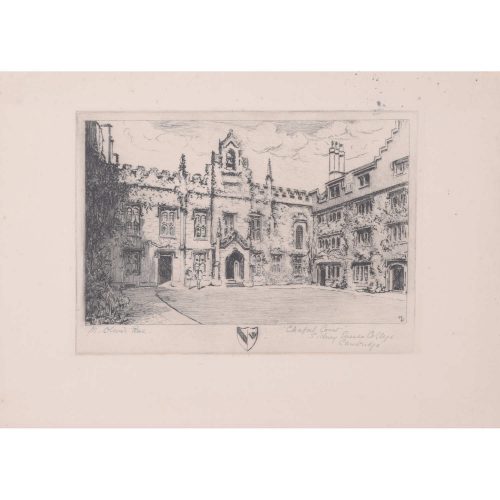
Mabel Oliver Rae
Chapel Court, Sidney Sussex College, Cambridge
Etching, circa 1920 12 x 17 cm Hand-signed in pencil lower left, and titled in pencil lower right. Signed "MR" in plate. Mabel Oliver Rae was born in Cambridge, Cambridgeshire, and trained at the Slade School of Fine Art between 1888 and 1890. Rae is known for her skilled etchings of various rural scenes and townscapes, particularly those of the colleges of Oxford and Cambridge. She signed works with the pseudonym 'M.Oliver Rae', a ruse to conceal the fact she was a female artist, so as not to reduce her chances with commercial dealers and agents. Condition: Generally very good. -
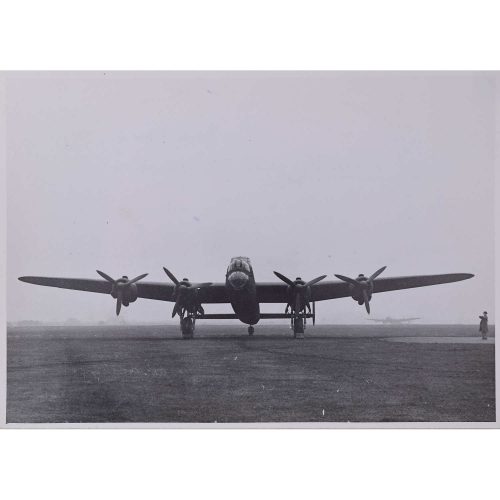
An Avro Lancaster II at its dispersal point
Silver gelatin print 12 x 16 cm Stamped to reverse 'This photograph has been passed by censor' 'Copyright. The TP copyright illustration from 'The Aeroplane' must not be reproduced without the written permission of Temple Press Ltd.' December 1943 The Avro Lancaster II was fitted with the rotary Bristol Hercules engine. There was a fear that there would be a shortage of Rolls-Royce Merlin engines, therefore 300 were produced by Armstrong Whitworth in Coventry with an alternative engine. Here it is pictured at an airfield, coming out of the mist. Somewhere probably in East Anglia, an area prone to fog, this atmospheric shot is enhanced by the second Lancaster bomber that is just about visible in the background and the human figure, dwarfed by the aeroplane, standing on concrete to the right. Condition: good. Provenance: from the collection of Philip J R Moyes, author of many books on the RAF, most notably The Pictorial History which ran to several volumes. -
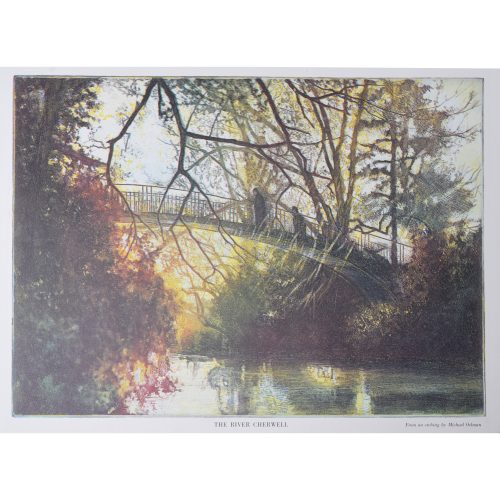
Michael Oelman (born 1941)
The River Cherwell
Lithograph 33 x 46 cm A lithograph of Oxford's wondrous River Cherwell in University Parks, from an etching by Michael Oelman. A setting sun casts its gold light over the glassy surface of the river and its surrounding trees; two figures cross the Cherwell via the famous Rainbow Bridge. The curved footbridge was built in the early 1920s by the University a project for the unemployed. Oelman's etching was reproduced as a lithograph in 1981, to be published in the "Oxford Almanack". The Oxford Almanack was an annual almanac published by the Oxford University Press for the University of Oxford from 1674 through 2019 (when printing sadly ceased due to "dwindling interest"). The almanac traditionally included engravings or lithographs of the University and information about the upcoming year. Other almanac artists have included James Basire, Michael Burghers, J. M. W. Turner, and John Piper. Michael Oelman was born in Llandudno, Wales, in 1941. He studied fine art at Reading University and then etching and lithography at the Central and Slade Schools of Art. In the 1960s he studied with S. W. Hayter in Paris, and then became a lecturer in Printmaking at Doncaster College of Art, Yorkshire. His studio is in Suffolk. Condition: very good. If you’d like to know more, please email info@manningfineart.co.uk or call us on 07929 749056. -
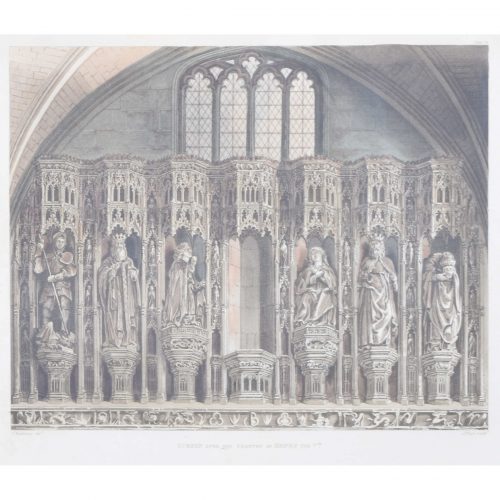
J Black (early 19th century) after Frederick Mackenzie (1788 - 1854)
Screen Over the Chantry of Henry V, Westminster Abbey (1812)
Hand-coloured aquatint 26 x 31 cm Published by Rudolph Ackermann (1764 - 1834). An engraving of the gothic screen of the elaborately carved chantry chapel dedicated to Henry V, and below which lies his tomb, in Westminster Abbey. Mackenzie's drawing was engraved by Black and published by Ackermann in his 1812 "History of Westminster Abbey". The Abbey is an historic, mainly Gothic church in the City of Westminster, London, just to the west of the Palace of Westminster. It is one of the United Kingdom''s most notable religious buildings and since Edward the Confessor, a burial site for English and, later, British monarchs. Since the coronation of William the Conqueror in 1066, all coronations of English and British monarchs have occurred in Westminster Abbey. Sixteen royal weddings have occurred at the abbey since 1100. According to a tradition first reported circa 1080, a church was founded at the site (then known as Thorney Island) in the seventh century, in the time of Mellitus, Bishop of London. Construction of the present church began in 1245 on the orders of Henry III. Frederick Mackenzie (1788 - 1854) was a British watercolourist and architectural draughtsman. He first exhibited at the Royal Academy in 1804, and contributed eleven drawings between that year and 1828. He contributed to the Society of Painters in Water Colours exhibitions from 1813, becoming an associate in 1822, and a full member the following year. From 30 November 1831 till his death he was treasurer to the society. In later life Mackenzie was no longer commissioned to illustrate books. Rudolph Ackermann was an Anglo-German bookseller, inventor, lithographer, publisher and businessman. In 1795 he established a print-shop and drawing-school at 96 Strand. Here Ackermann set up a lithographic press and began a trade in prints. He later began to manufacture colours and thick carton paper for landscape and miniature painters. Within three years the premises had become too small and he moved to 101 Strand, in his own words "four doors nearer to Somerset House", the seat of the Royal Academy of Arts. Between 1797 and 1800 Ackermann rapidly developed his print and book publishing business, encompassing many different genres including topography, caricature, portraits, transparencies and decorative prints. Condition: good. Some age toning. If you’d like to know more, please email info@manningfineart.co.uk or call us on 07929 749056. -
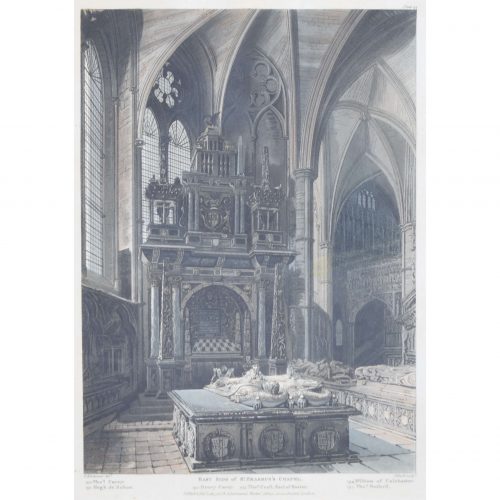
J Black (early 19th century) after Frederick Mackenzie (1788 - 1854)
East Side of St Erasmus' Chapel, Westminster Abbey (1812)
Hand-coloured aquatint 28 x 19 cm Published by Rudolph Ackermann (1764 - 1834). An engraving of the east side of the chapel of St Erasmus in Westminster Abbey. Mackenzie's drawing was engraved by Black and published by Ackermann in his 1812 "History of Westminster Abbey". The chapel was built in the late 15th century by order of Edward IV's wife, Elizabeth Woodville. It would have been used to worship St Erasmus, also known as St Elmo (a Christian saint and martyr venerated as the patron saint of sailors and abdominal pain). The Abbey is an historic, mainly Gothic church in the City of Westminster, London, just to the west of the Palace of Westminster. It is one of the United Kingdom's most notable religious buildings and since Edward the Confessor, a burial site for English and, later, British monarchs. Since the coronation of William the Conqueror in 1066, all coronations of English and British monarchs have occurred in Westminster Abbey. Sixteen royal weddings have occurred at the abbey since 1100. According to a tradition first reported circa 1080, a church was founded at the site (then known as Thorney Island) in the seventh century, in the time of Mellitus, Bishop of London. Construction of the present church began in 1245 on the orders of Henry III. Frederick Mackenzie (1788 - 1854) was a British watercolourist and architectural draughtsman. He first exhibited at the Royal Academy in 1804, and contributed eleven drawings between that year and 1828. He contributed to the Society of Painters in Water Colours exhibitions from 1813, becoming an associate in 1822, and a full member the following year. From 30 November 1831 till his death he was treasurer to the society. In later life Mackenzie was no longer commissioned to illustrate books. Rudolph Ackermann was an Anglo-German bookseller, inventor, lithographer, publisher and businessman. In 1795 he established a print-shop and drawing-school at 96 Strand. Here Ackermann set up a lithographic press and began a trade in prints. He later began to manufacture colours and thick carton paper for landscape and miniature painters. Within three years the premises had become too small and he moved to 101 Strand, in his own words "four doors nearer to Somerset House", the seat of the Royal Academy of Arts. Between 1797 and 1800 Ackermann rapidly developed his print and book publishing business, encompassing many different genres including topography, caricature, portraits, transparencies and decorative prints. Condition: good. Some age toning. If you’d like to know more, please email info@manningfineart.co.uk or call us on 07929 749056. -
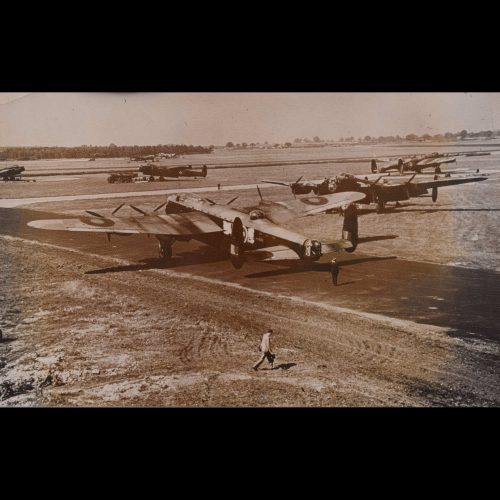
Lancaster Bomber VN-N R5689
Original Silver Gelatin photograph 11 x 16 cm Stamped to reverse 'This TP Copyright illustration from 'The Aeroplane' must not be reproduced without the written permission of Temple Press.' The photograph - and several others of the Swinderby based R5689 of 50 Sqn - was taken on the base open day in June 1942, a week or so after the aerodrome had reopened having been improved with concrete - rather than grass - runways. R5689 was destroyed on the night of 18/19 September that year. It had been on a sea mining mission and crashed on landing when both port engines failed. Four crew members were killed and three further were injured. It is also proposed that R5689 be imortalised by the Bomber Gateway Trust with a lifesize replica spraying poppies across the country, just a short distance from its crash site in Lincolnshire. Further funding is required before the project can be completed. They have 'colourised' a copy of this photograph on their website, see here. Condition: the photograph has discoloured and taken on a sepia hue as may be seen in the image. Provenance: from the collection of Philip J R Moyes, author of many books on the RAF, most notably The Pictorial History which ran to several volumes. -
Out of stock
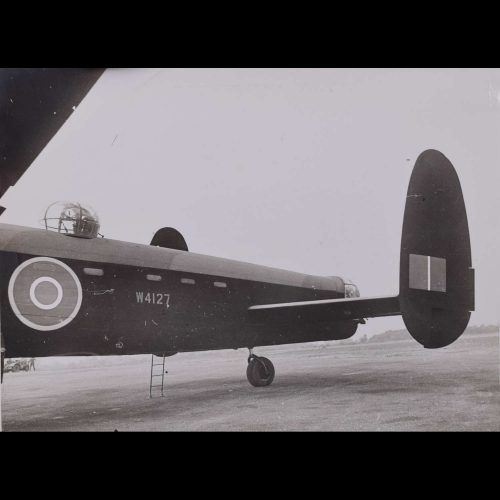
Lancaster Bomber W4127
Original Silver Gelatin photograph 16 x 21 cm Stamped to reverse 'Copyright this photograph must not be reproduced without the written permission of The Aeroplane.' W4127, of Sqn 419 (RCAF) was lost on the night of 20/21 April 1944 whilst returning from a mission to bomb the railway yards at La Chappelle. Having taken off from Dunholme Lodge at 22.07 and completed its bombing raid, it was attacked by a night fighter, suffering a fire in one wing, crashing north of Paris. The yards were badly damaged by the bombing, the mission a success. Six of the crew were killed and are buried in Poix de la Somme churchyard, whilst one, Bob Hortie, evaded escape. The Comet line - the escape line that took downed airmen to Spain whereby they could return to England - found it hard to operate with the destruction of rail and road infrastructure in the period leading up to D-Day and the invasion of Europe. Airey Neave of MI9 therefore set up three camps in isolated forests in Northern France where downed airmen could await the invading allied forces. The camps were supplied - and manned - by the allies through parachute drops. Hortie was one of 152 allied airmen to be in the camp at Fréteval - codenamed 'Sherwood Camp'. Neave went to France in the middle of August, to Le Mans which was controlled by the Americans and was 75 miles from Sherwood Camp. The Americans distrusted Neave and refused to provide him with transport. He managed to come up with some trucks and buses, which - decked out with flowers and French flags and guarded by a civilians armed with rifles and a handful of SAS men - set out to Fréteval on 14 August 1944 returning the same day with 132 airmen. A further 20 were recovered the following day. Most returned to active service and 38 died before the end of the war. A souvenir from the camp is published here on the internet. The camps were due to be set up by a team that included Belgian resistance member Michelle Dumon, who at the age of 22 (with an identity card that showed she was 16) had exfiltrated 250 airmen by this point. However she unmasked a German infiltrator into the Comet line just as the camps were being set up and was therefore sought by the Gestapo and had to flee to England. That seemingly simple journey of course meant a perilous journey across France to Spain, crossing the Pyrenees on foot, and being rescued by the RAF. In this photograph L4127 is without its squadron letters, suggesting that it is fresh out of the factory at the time of the photograph. -
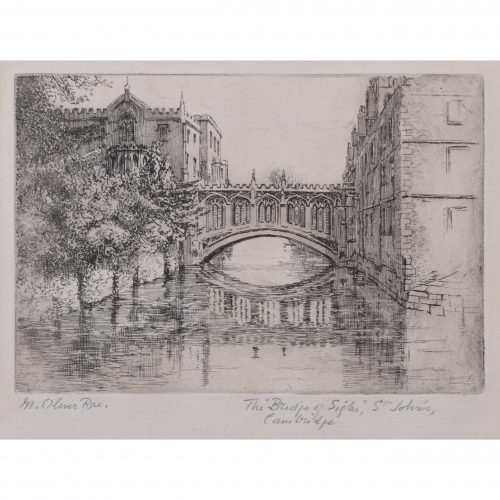
Mabel Oliver Rae (1868 - 1956)
The Bridge of Sighs, St John's College, Cambridge (circa 1920)
Etching 13 x 18 cm Hand-signed in pencil lower left, and titled in pencil lower right. Initialled 'MR' in plate lower left. The Bridge of Sighs is an iconic feature of St John’s College, and one of the most recognisable pieces of architecture in Cambridge. It was built in 1831 by the architect Henry Hutchinson and crosses the River Cam between the college's Third Court and New Court. It is the only covered bridge to cross the River Cam, and the only College bridge built in the Victorian Gothic style. Mabel Oliver Rae was born in Cambridge, Cambridgeshire, and trained at the Slade School of Fine Art between 1888 and 1890. Rae is known for her skilled etchings of various rural scenes and townscapes, particularly those of the colleges of Oxford and Cambridge. She signed works with the pseudonym 'M.Oliver Rae', a ruse to conceal the fact she was a female artist, so as not to reduce her chances with commercial dealers and agents. Condition: even age toning, a little spotting, generally good. If you’d like to know more, please email info@manningfineart.co.uk or call us on 07929 749056. -
Out of stock
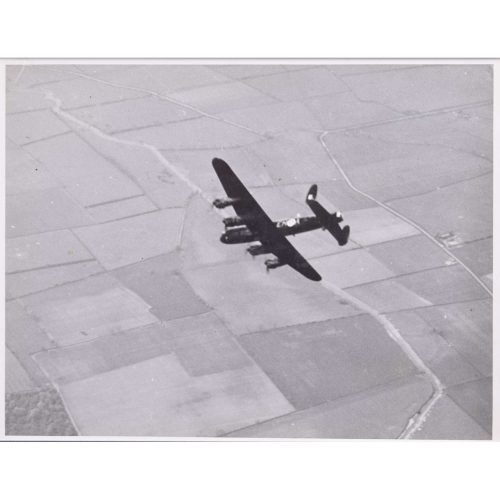
AVRO Lancaster EN-A in Flight
Original Silver Gelatin photograph, 1940s An aircraft of No. 27 Operational Training Unit which was based at RAF Lichfield. The OTUs were the last stage of aircrew training prior to transfer to an operational unit. Crews had already been formed up, and were trained to fly as a crew in the aircraft type they were to fly in combat. Occasionally the OTUs provided aircraft and crews for offensive operations, for example in the first 'Thousand Bomber Raid' on Cologne in May 1942. Loss rates in OTUs were high owing to the combination of the British weather, the crowded airspace, inexperienced crews - and even enemy action. 16 x 21 cm Provenance: from the collection of Philip J R Moyes, author of many books on the RAF, most notably The Pictorial History which ran to several volumes. Condition: Very good. -
Out of stock
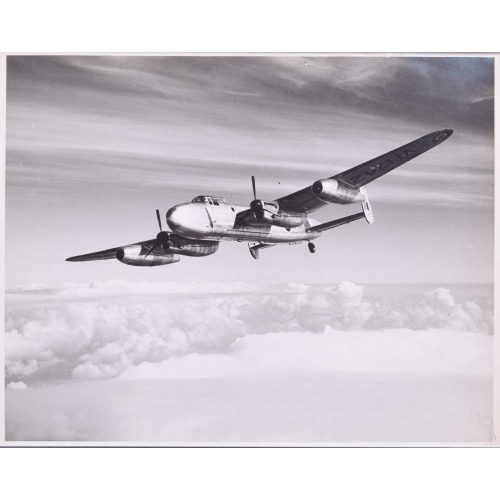
Charles E Brown (1896-1982)
Lancastrian VH742 - The first Jet Airliner
Original Silver Gelatin photograph, 1940s 19 x 24 cm Stamped to reverse 'Charles E Brown' with address and 6140-2 reference number, together with press release reading: "THE FIRST JET LINER "Captain R T Shepherd, Rolls Royce chief test pilot, demonstrating the remarkable performance of the 62,500 lb Avro LANCASTRIAN on the two NENE jets alone. With the two Merlins and their propellors stopped one is struck by the entire absence of visible moving parts. Even more noticeable is the reduced noise and complete lack of vibration." The Lancastrian was developed from the Lancaster bomber with armaments and armour removed, and a new - streamlined - nose. The first batch were made by converting Lancaster bombers, latter batches made from scratch. The Lancaster had been designed to carry bombs rather than passengers, and so the space available meant that whilst the Lancastrian was not suitable for large numbers of passengers it was admirably suited to carrying mail and other perishable goods.First to fly was Lancastrian VH742, delivered to the Rolls-Royce flight development airfield at Hucknall in October 1945. Its outer Merlin engines were removed and the nacelles were also taken away, while the fuel system was completely rebuilt to carry both gasoline for the inner engines and kerosine for the new jets. In the outer positions were added completely new nacelles housing Nene turbojets, then the most powerful jet engines in the world. It flew again on August 14, 1946 with two Merlins and two Nenes.
On September 19, 1946 this aircraft acted as the world's first jet airliner by making three passenger flights carrying representatives of the Press as well as Ministry officials and other passengers (who were all most impressed and suggested that an airline that could offer jet travel would be the talk of the world). Rolls-Royce also flew a second Nene-Lancastrian, VH737, and two Avon-Lancastrians, VM732 and VL970. The latter The first flight of a jet airliner was reported as follows:
"The Nene-Lanc, Flies to Paris "THE flight of the Nene Lancaster from London to Paris last Monday, to play its part in connection with the exhibition, may be said to have marked a historic part in British aircraft development, for it constituted the first time that any jet-powered airliner had flown from one country to another. Moreover, since this particular aircraft has been flying fairly regularly since round about the time of the Radlett exhibition, the flight to Paris was no special performance, but merely one more public demonstration of its inherent reliability. "In the hands of Capt. R. T. Shepherd, chief test pilot for Rolls-Royce, the “Nene-Lanc” landed at Le Bourget at 10.58 a.m., G.M.T., after a 50-minute flight from London Airport, giving an average speed of 247.5 m.p.h. [398.3 kilometers per hour] Two passengers were carried in addition to the crew; they were Mr. Roy Chadwick, the Avro designer, and Mr. R. B. William Thompson, Chief Information Officer of the Ministry of Supply. "Capt. Shepherd said that he was very pleased with the aircraft’s performance and added that, but for having to circle Le Bourget Airport Twice before landing, the flight would have been completed in 43 minutes." FLIGHT and AIRCRAFT ENGINEER, No. 1978. Vol. L., Thursday, November 21st, 1946 at Page 561, Column 2. Charles E Brown was a famous photographer of aircraft whose father was a butcher in Wimbledon, London. Young Charles was given a camera for his 14th birthday and in 1911 photographed an Edwardian gentleman in trouble landing his balloon in neighbouring Southfields. This photograph was published in the Daily Mirror – the fee being half a crown – and Brown was encouraged to join the Daily Mirror’s photography department upon leaving school at 16. Towards the end of the First World War he served with the Royal Air Force at their official London Photographic Centre. Following the war, he took to photographing trains, and captured a famous photograph of a Southern Railway locomotive that was used for the following ten years in railway posters. The income from this allowed him to pursue his passion of aviation photography in the 1920s and 1930s, from which commissions from the Air Ministry and Fleet Air Arm followed. During the war his work included commissions for Aeronautics magazine. Provenance: from the collection of Philip J R Moyes, author of many books on the RAF, most notably The Pictorial History which ran to several volumes. Condition: Generally very good. -
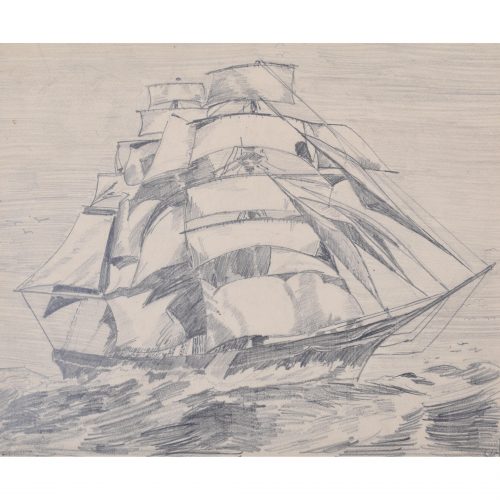
Gerald Mac Spink (flourished 1920 - 1940)
Sailing ship
Pencil 31 x 38 cm A stormy sea and the wind in her sails. Spink was a skilled artist, illustrator, and designer who produced a series of posters in the inter-war period for companies including the London Underground, Southern Railways, LNER, Hawker Engineering, and British Steel. He won a prize in 1933 from the Imperial Institute for his poster artwork. He also worked as an aeronautical engineer in Kingston-on-Thames for Hawker Engineering; his greatest achievement was the creation of the 'Squanderbug', a 500cc racing car which he built in 1947, and which races even to this day. Provenance: the artist's estate. Condition: generally very good. If you are interested, please email info@manningfineart.co.uk or call us on 07929 749056. Click here for other works by the artist. -
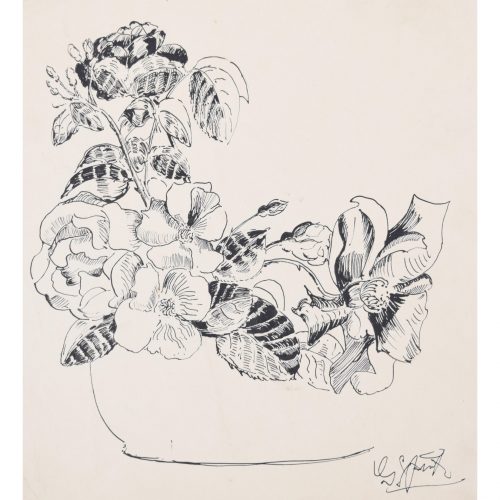
Gerald Mac Spink (flourished 1920 - 1940)
Flowers
Pen and ink 15 x 23 cm Signed 'G Spink' lower right. Spink was a skilled artist, illustrator, and designer who produced a series of posters in the inter-war period for companies including the London Underground, Southern Railways, LNER, Hawker Engineering, and British Steel. He won a prize in 1933 from the Imperial Institute for his poster artwork. He also worked as an aeronautical engineer in Kingston-on-Thames for Hawker Engineering; his greatest achievement was the creation of the 'Squanderbug', a 500cc racing car which he built in 1947, and which races even to this day. Provenance: the artist's estate. Condition: generally very good. If you are interested, please email info@manningfineart.co.uk or call us on 07929 749056. Click here for other works by the artist. -
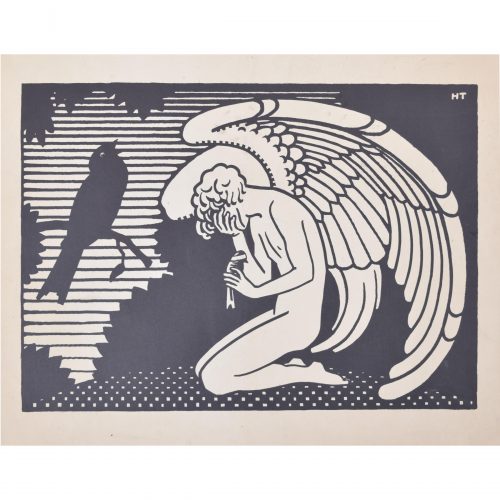
"HT"
Raven and Angel
Block print 28 x 41 cm Signed 'HT' upper right in the plate. A monochrome print of an angel holding a bird - usually a symbol of peace or prophecy. The birds here are black, however, rather than the more typical white dove, and the bird held by the weeping angel seems to be injured. Condition: generally very good; vertical crease to centre; even overall slight toning to paper. If you are interested, please email info@manningfineart.co.uk or call us on 07929 749056. -
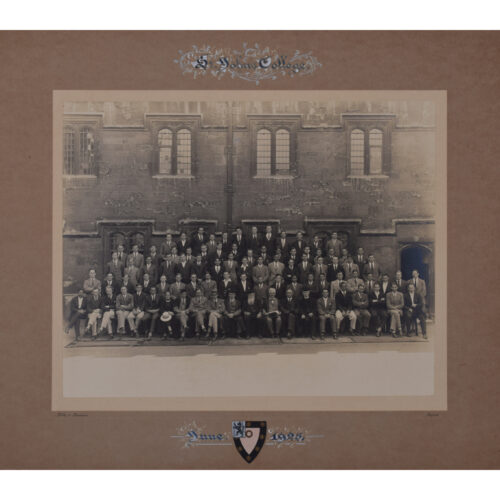
Hills and Saunders
St John's College, Oxford (1925)
Silver gelatin photograph with extensive hand-decoration of mount 43 x 49 cm A photograph taken of St John's College students and tutors in 1925. Hills & Saunders was one of the leading Victorian social photography firms. Robert Hills and Henry Saunders started the firm together in 1860 and had studios in Oxford, Cambridge, and London during the course of their partnership, as well as near certain army bases and public schools. They were given a Royal Warrant in 1867. Condition: generally very good. If you are interested, please email info@manningfineart.co.uk or call us on 07929 749056. Click here for more St John's pictures. -
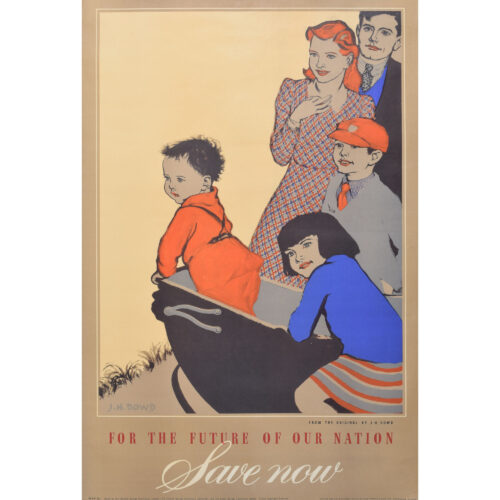
For the Future of our Nation - Save Now
Original vintage poster 73 x 49 cm Issued by the National Savings Committee, London, the Scottish Savings Committee, Edinburgh, and the Ulster Savings Committee, Belfast. An original vintage WW2 poster encouraging Britons to save via the National Savings scheme; by saving, the couple in the picture can ensure a good future for their three children. James Henry Dowd was born in 1884. He worked as a draughtsman, etcher and painter. Dowd was a regular contributor to the The Daily Graphic and in 1906 began to have his work published in Punch Magazine. Condition: generally very good. Not backed. If you are interested, please email info@manningfineart.co.uk or call us on 07929 749056. Click here for other original vintage National Savings posters. -
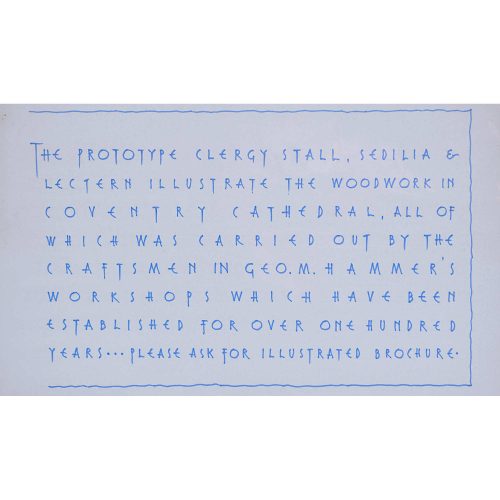
D L Hadden
Calligraphy for George M Hammer Coventry Cathedral Fittings
Pen and ink 20x35cm c. 1950 Hadden was a senior designer for Geo M Hammer, designers and retailers of school and ecclesiastical furniture. Their lift-top school desks are particularly well regarded, and always carried their brass name plate. Hammer were renowned for their interior woodwork, they were commissioned to undertake the choir stalls in Sir Basil Spence’s ground-breaking Coventry Cathedral. Dick Russell (brother of Gordon Russell and who worked for his brother before World War Two) famously designed the chairs to be used by the congregation; as all-wood stacking chairs they were innovative at the time. As senior designer, Hadden was at the heart of the Coventry project. Coventry's great place in the world of calligraphy comes from the Ralph Beyer typeface (or font) which surely has had an influence on Hadden's calligraphy here - see our matching card that refers to London Churches. For biographical details and other works by the artist click here. If you are interested email info@manningfineart.co.uk or call us on 07929 749056. -
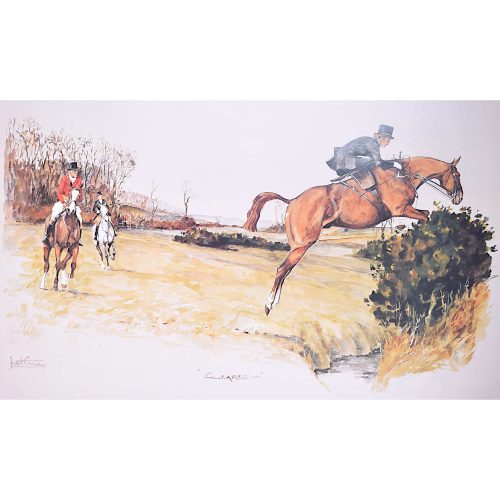
Daniel Crane (b. 1969) 'Cleared'
Limited edition print Signed in pencil and numbered 168/250 40x60cm One of the UK's leading sporting artists, Crane was born in Norfolk and is the youngest son of a hunting family. He grew up with a love of animals, the countryside and fieldsports, acquiring a particular passion for fox hunting in his late teens. He has been whipper-in, Master and Field Master and therefore understands the whole hunting process, allowing his paintings to reflect his knowledge and love of the sport. He is artist in residence for the Household Cavalry, and has many prestigious commissions to his name including Frankel - the greatest racehorse of all time - and Valegro the World and Olympic Champion. In this print, Crane captures the thrill and exhilaration that comes from clearing a hedge in fine style. If you are interested email info@manningfineart.co.uk or call us on 07929 749056. Condition: Never previously framed and in excellent condition. -
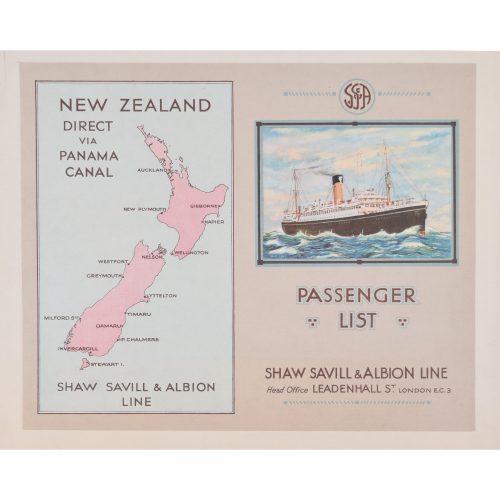
A E Agar (artist) Original passenger list brochure for Shaw Savill Albion Line, c. 1940s or 1950s.
24x34cm (approx) Provenance: the artist's estate As new, unissued printer's proof. Could be trimmed to the brochure size if desired. Fine image of ocean liner to front cover, map - via Panama Canal - to back cover. From the great age of Ocean Liners. If you are interested email info@manningfineart.co.uk or call us on 07929 749056. Condition: Excellent. -

Emery Walker (1851 - 1933) after Edmund Hort New (1871 - 1931)
Wadham College, Oxford
Photogravure 27 x 41 cm New produced a series of pen-and-ink drawings of Oxford colleges, of which this is one. They paid homage to the artist David Loggan, often using the same aerial viewpoint as him, but showing the colleges two hundred years later. Emery Walker turned New's drawings into photoengravings in the early 20th century. Probably no more than two hundred prints of each engraving were produced, and the plates were destroyed in the blitz. Edmund Hort New was an English artist. He was a member of the Birmingham Group of Arts and Crafts-associated painters and craftsmen, and is known as a leading illustrator of his period. He specialised in pen and ink drawings of rural and urban landscapes, old buildings and their interiors, architectural features, and also designed bookplates. He provided illustrations for the English Illustrated Magazine and was commissioned by Bodley Head publishers to illustrate critically acclaimed editions of books, such as Walton's The Compleat Angler. In 1895, New met William Morris and began designing for the Kelmscott Press. He also taught drawing to T E Lawrence. In 1905, he began his drawings of the Oxford colleges, and spent the rest of his life working on the (sadly unfinished) project. In 1921 he exhibited at the first exhibition of the Society of Graphic Art. Sir Emery Walker FSA was an English engraver, photographer, and printer. He was very involved with the Arts and Crafts movement, a Master of the Art Workers' Guild, President of the Arts and Crafts Exhibition Society, a Trustee of the Wallace Collection, and a Fellow of the Society of Antiquaries. He was also a close friend of William Morris. Walker's expertise and his collection of 16th-century typefaces inspired Morris to create the Kelmscott Press. In 1910, Walker photographed the notable Rice portrait of Jane Austen. He was knighted in 1930. Condition: very good; modern printing. If you’d like to know more, please email info@manningfineart.co.uk or call us on 07929 749056. Click here for other views of Wadham. -
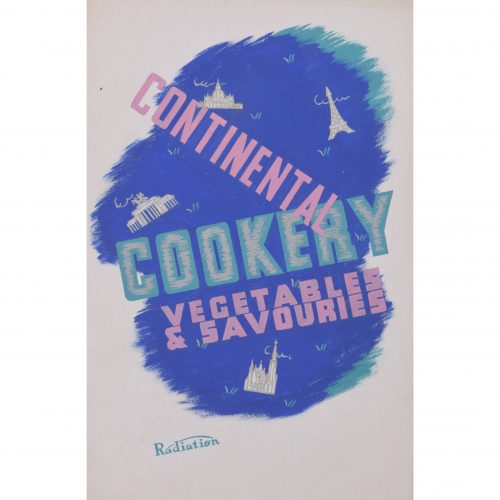
Brownbridge (flourished 1930s - 1940s)
Continental Cookery Radiation cooker brochure design
Gouache 21.5 x 14 cm From a small archive of works by Brownbridge, a member of the Society of Industrial Artists. A beautiful original gouache design for a brochure of continental recipes, created to advertise Radiation cookers (innovative gas cookers which were sold in Britain in the 1920s and 1930s). Brownbridge's brightly-coloured design includes boldly slanted text in pink and turquoise, set over a deep blue background; he also highlights architectural gems of Europe, such as the Eiffel Tower. By cooking with a Radiation cooker, the cover suggests, you too can experience the cultural and culinary delights of Europe from the comfort of your own home. Society of Industrial Artists correspondance (photographed above) is not included; please enquire separately. Condition: generally very good. If you are interested, please email info@manningfineart.co.uk or call us on 07929 749056. Click here for other designs by Brownbridge. -
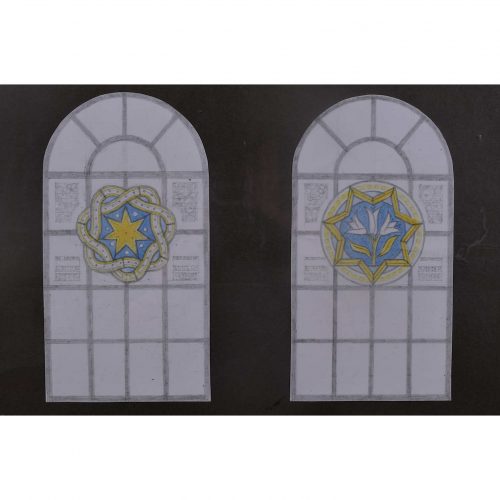
Jane Gray (b.1931)
St Mary’s Church, Twickenham, Middlesex, Design for Stained Glass Memorial Windows (1988)
Watercolour 15.5 x 17 cmSigned, dated and studio stamp verso.
St Mary’s Church stands on the site of an earlier church in Twickenham, a short distance from York House and the banks of the River Thames, and incorporates a 15th-century, medieval tower. St Mary's has an impressive and illustrious history of notable parishioners including the painter Godfrey Kneller who, after the collapse of the ancient church's 14th-century nave in 1714, took active involvement in redesigning the church in the Neo-classical style alongside local architect John James, as well as Henry Fielding and Alfred Lord Tennyson whose sons were both baptised here. Gray had a personal connection to St Mary’s, her great grandfather having been the vicar some years before. These windows held especial personal meaning for Gray as they commemorated the death of her parents in 1982 and 1985 respectively. The windows were installed in 1989.
Provenance: the artist’s studio sale. Literature: Jane Gray, Playing with Rainbows. (Shropshire: Ellingham Press, 2011), pp.42-3, 80. Condition: very good. If you are interested, please email info@manningfineart.co.uk or call us on 07929 749056. For other works by Jane Gray and more information about her, please click here. -

Jane Gray (b.1931)
St John’s Church, Pool Quay, Design for Stained Glass Roundel (2005)
Watercolour D.14 cmSigned and studio stamp verso.
St John's Church was built in 1861 under the patronage of the third Earl of Powys to provide for the religious needs of the largely industrial population of Pool Quay. The church was originally designed in the Early English style but was extensively restored first in 1956 and again in 2003/4. Despite this, it still retains its unique charm, built in the instantly recognisable red Sweeney Mountain sandstone, and features stained glass windows by Winfield of Birmingham (1891) and Camm of Smethwick (1899). This design by Gray features eight lights containing attributes of St John and other Christian symbols.
Provenance: the artist’s studio sale. Literature: Jane Gray, Playing with Rainbows. (Shropshire: Ellingham Press, 2011), p.89. Condition: very good. If you are interested, please email info@manningfineart.co.uk or call us on 07929 749056. For other works by Jane Gray and more information about her, please click here. -
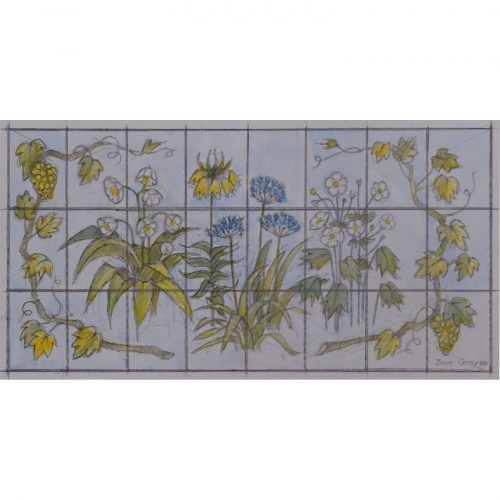
Jane Gray (b.1931)
Saling Hall, Essex, Design for Stained Glass Window (1980)
Watercolour 11 x 20 cmSigned and dated.
Saling Hall, in Essex, has a long and rich history, dating back to the early 12th century when Sir Baldwin Wiscart was the first recorded Lord of the Manor. After his his son, the house passed to the knightly family of Bibbesworth, who lived there for four generations. Sir Walter de Bibbesworth was a crusader and a poet (in French). Nothing remains of the first Saling Hall which was rebuilt around 1590 by the Maxey family who had bought the hall in 1487. The house faced further remodelling by its 17th century owner, Martin Carter, a lawyer. He ornamented the new facade with Dutch gables, which are the latest example of their kind in Essex, and the house has changed little since. The hall passed through many more hands before it was bought, in 1935, by Lady Isabella Carlyle (née Barton) who was a passionate gardener and gave the Hall its first modern gardens. Lady Carlyle sold the Hall in 1971 to Hugh Johnson, a well known garden writer, who continued Lady Carlyle’s work on the gardens. This design is a final drawing for a stained glass window commissioned by Johnson for a fanlight in Saling Hall. Johnson wished the design to include the plants he grew in his own garden to symbolise the seasons. Gray designed the panel using Corsican Hellebore for winter, the Crown Imperial Fritillary for spring, Agapanthas for summer, and Japanese Anemones for autumn. Gray also included vines to frame the design and nod to Johnson’s oenological interests.
Provenance: the artist’s studio sale. Literature: Jane Gray, Playing with Rainbows. (Shropshire: Ellingham Press, 2011), p.40. Condition: very good. If you are interested, please email info@manningfineart.co.uk or call us on 07929 749056. For other works by Jane Gray and more information about her, please click here. -
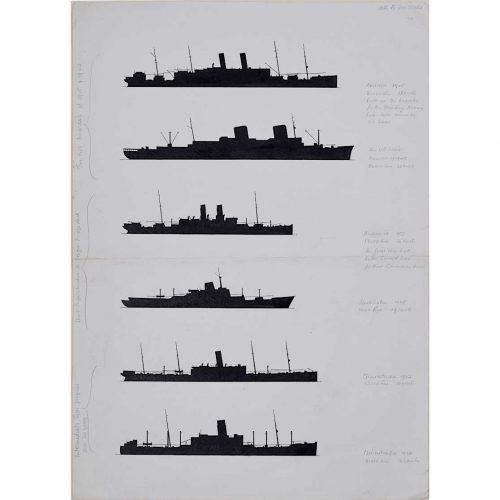
Laurence Dunn (1910-2006)
A Series of Coastal Tramp Silhouettes
34.5 x 24 cm Bodycolour on paper Dunn’s depictions of coastal tramps are early works, likely captured from the side of the Thames estuary near his home. This work contains extensive notes on the featured ships.Laurence Dunn (1910-2006) was a well-known British marine artist and writer known for his depictions of ships. He grew up in Devon, where he practised drawing passing ships, and went on to study at the Central School of Art. He then worked for shipbuilding firm John I. Thornycroft & Company Limited, where he contributed to the design of the Royal Yacht. During the Second World War, Dunn worked in naval intelligence. In the early 1960s, he created many line drawings of Atlantic ocean liners.
Upon his death in 2006, the World Ship Society published the following obituary:
DUNN, Laurence. [December 15 2006 — Lloyds List] Many readers will be saddened by the death of well-known marine artist and writer Laurence Dunn in his 97th year. A man of encyclopaedic knowledge, he began his lifelong love of ships in Brixham, where he meticulously recorded passing traffic with the exquisitely accurate line drawings which later became something of a trademark. While studying at London’s Central School of Art his work was noticed by the Southern Railway, which commissioned profiles of its fleet, and this in turn led to work for Orient Line, where he also designed the well-known corn-coloured hull, and later Thorneycroft, where he helped with shaping draft plans for a new royal yacht. During the second world was he worked for naval intelligence at the Admiralty, where his technique did much to improve recognition standards, and greatly expanded his shipping clientele, becoming personally known to many chairmen. As well as the shipping press he worked for mainstream publications such as Everybody’s, Sphere and the upmarket comic Eagle. Through his many contacts he enjoyed going to sea in a great variety of ships from aircraft carriers to colliers. Laurence wrote several books, starting with ship recognition titles which introduced new standards of layout, but his best known work was probably Passenger Liners, which was widely taken up by the travel trade. His love of Greece, where he was an early publicist of island cruising, let to involvement in reshaping various passenger liners beginning with Greek Line’s OLYMPIA. In later life he designed several sets of shipping stamps for the Crown Agents, produced photographic volumes on Thames and Mediterranean shipping and still found time to enjoy the passing Thames traffic. Our sympathies go to his wife Jennifer, who provided succour to the many ship lovers who beat a path to the welcoming door of their Gravesend home.
-
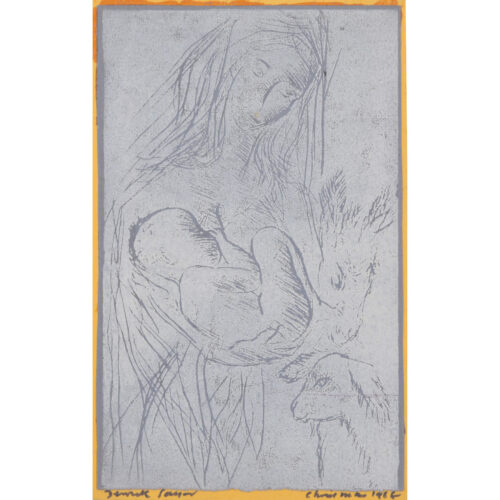
Derrick Latimer Sayer (1917 - 1992)
Madonna and Child (Christmas Card)
Linocut 21 x 13.5 cm Mounted to card, signed 'Derrick Sayer' and dated Christmas 1968. Sayer's linocut of the Virgin Mary and baby Jesus is hauntingly emotive; his spare use of line shows Mary, eyes closed, cradling her newborn son. Two animals from the stable in Bethlehem look on. Sayer studied at the Chelsea School of Art under Graham Sutherland and Henry Moore, and then in Paris in Ben Nicholson's studio. In the late 1930s he was in Cornwall, founding the Mousehole Group Art School. He was well known for his work as a poster artist and book illustrator. Condition: very good. If you are interested, please email info@manningfineart.co.uk or call us on 07929 749056. -
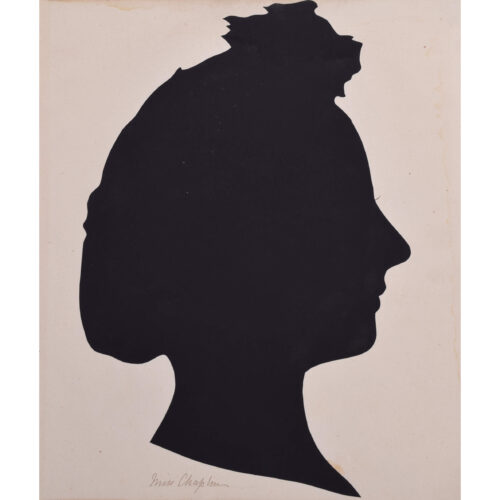
Silhouette (circa 1870)
Miss Chaplin
Gouache, pen, and ink 52 x 44 cm Prior to photography, silhouettes were the easiest way of recording a person's appearance. This set might record the group present at a country house party, a wedding, or other similar convivial occasion. Condition: good. Some staining at upper and right edges. If you are interested, please email info@manningfineart.co.uk or call us on 07929 749056. Click here for other silhouettes. -
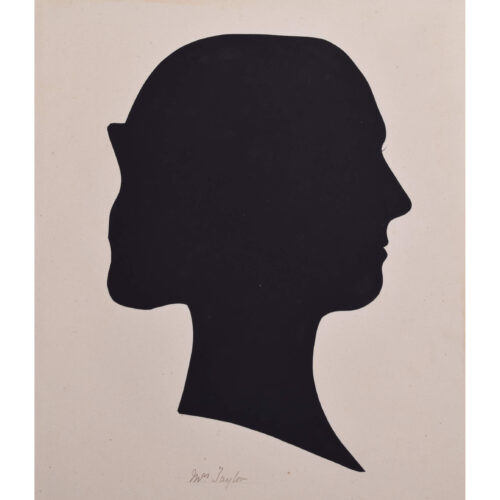
Silhouette (circa 1870)
Mrs Taylor
Gouache, pen, and ink 52 x 44 cm Prior to photography, silhouettes were the easiest way of recording a person's appearance. This set might record the group present at a country house party, a wedding, or other similar convivial occasion. Condition: generally very good. If you are interested, please email info@manningfineart.co.uk or call us on 07929 749056. Click here for other silhouettes. -

Silhouette (circa 1870)
Mrs Warburton
Gouache, pen, and ink 52 x 44 cm Prior to photography, silhouettes were the easiest way of recording a person's appearance. This set might record the group present at a country house party, a wedding, or other similar convivial occasion. Condition: generally very good; some light staining at upper edge. If you are interested, please email info@manningfineart.co.uk or call us on 07929 749056. Click here for other silhouettes. -
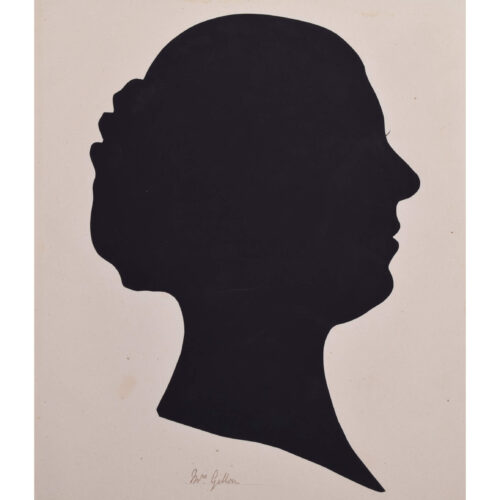
Silhouette (circa 1870)
Mrs Gillon
Gouache, pen, and ink 52 x 44 cm Prior to photography, silhouettes were the easiest way of recording a person's appearance. This set might record the group present at a country house party, a wedding, or other similar convivial occasion. Condition: generally very good; some light staining. If you are interested, please email info@manningfineart.co.uk or call us on 07929 749056. Click here for other silhouettes. -
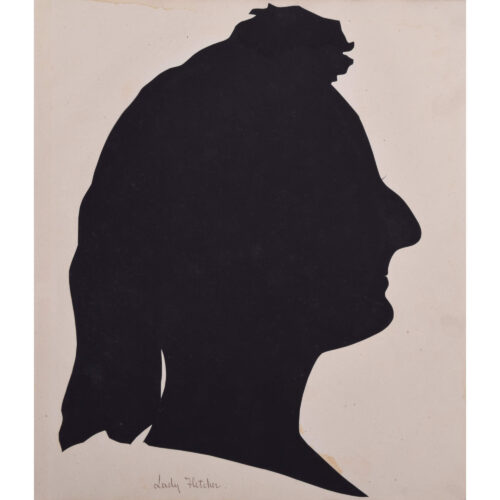
Silhouette (circa 1870)
Lady Fletcher
Gouache, pen, and ink 52 x 44 cm Prior to photography, silhouettes were the easiest way of recording a person's appearance. This set might record the group present at a country house party, a wedding, or other similar convivial occasion. Condition: generally very good; some light staining to right edge. If you are interested, please email info@manningfineart.co.uk or call us on 07929 749056. Click here for other silhouettes. -
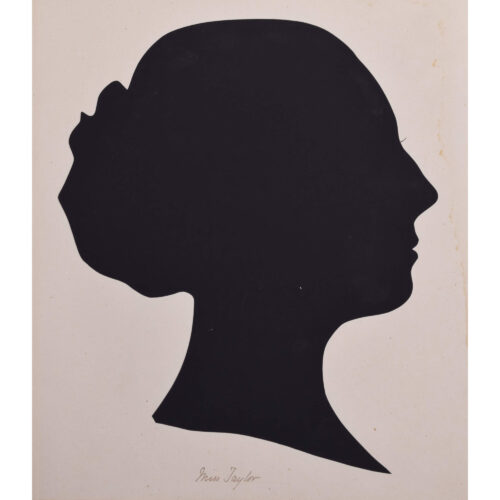
Silhouette (circa 1870)
Miss Taylor
Gouache, pen, and ink 52 x 44 cm Prior to photography, silhouettes were the easiest way of recording a person's appearance. This set might record the group present at a country house party, a wedding, or other similar convivial occasion. Condition: good; some staining to right edge. If you are interested, please email info@manningfineart.co.uk or call us on 07929 749056. Click here for other silhouettes. -
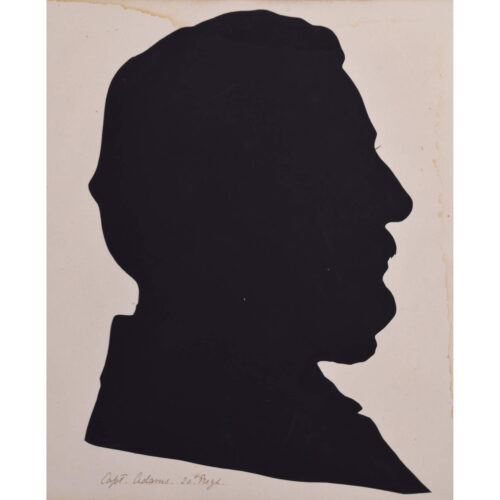
Silhouette (circa 1870)
Captain Adams, 20th Regt
Gouache, pen, and ink 52 x 44 cm Prior to photography, silhouettes were the easiest way of recording a person's appearance. This set might record the group present at a country house party, a wedding, or other similar convivial occasion. Condition: generally good; some staining to upper and right margins. If you are interested, please email info@manningfineart.co.uk or call us on 07929 749056. Click here for other silhouettes. -
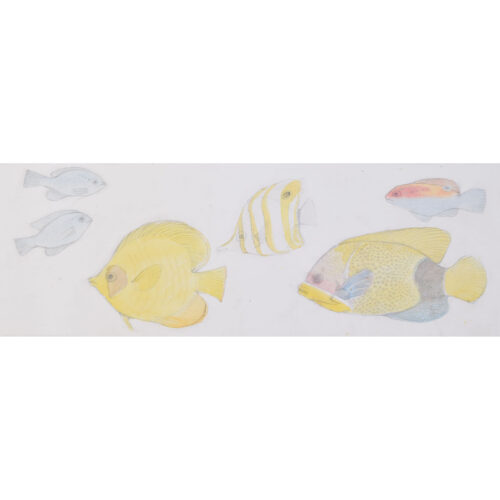
Jane Gray (born 1931)
Fish (1960)
Pencil and watercolour 19 x 54 cm Provenance: the artist's studio sale. Jane Gray A.R.C.A. (b.1931) is a British stained glass artist. She studied stained glass at the Kingston School of Arts (1949 - 1951) and later at the Royal College of Art (1951 - 1955) under Lawrence Lee. Lee was so impressed with Gray’s work that he asked her to work alongside him on the design of ten nave windows for Coventry Cathedral. This six-year-long design project culminated in their final installation in 1962 after the cathedral’s consecration. Gray was the first woman to become a liveryman of the Worshipful Company of Glaziers and has designed more than a hundred windows in private and public buildings, chapels and over forty churches across the country, including St Peter’s, Martindale, Shrewsbury Abbey, St Oswald, Oswestry and St Mary, Chirk. Gray’s designs mark a crucial turning point in the history of stained glass art as the Victorian style gave way to a modern, aesthetic. In her work, Gray navigates this shift with a style that, whilst distinctly modern, retains a deep rooted sense of the medieval. Despite many of her commissions being for church windows, stained glass design was not simply about religious depiction for Gray, but more about ‘colour, shapes, luminosity, [and] playing with rainbows’. Condition: generally very good. If you are interested, please email info@manningfineart.co.uk or call us on 07929 749056. For other works by Jane Gray and more information about her, please click here. -
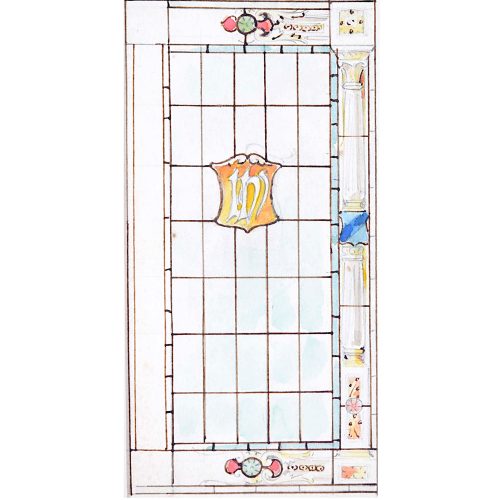
Florence Camm (1874-1960) Design for church stained glass window with 'IHS' roundel
Watercolour 17x9 cm Design for TW Camm & Co., Smethwick, Birmingham With 'IHS' Roundel - 'Iesus Hominum Salvator' ('Jesus Saviour of Mankind') The Camms were stained glass designers who exhibited 48 times at the Royal Academy and also exhibited at The Walker Art Gallery in Liverpool, The Royal Scottish Academy and Royal Birmingham Society of Artists. Following the death of her father, Florence Camm became chief designer at TW Camm with many commissions both nationally and internationally. Florence Camm was the daughter of Thomas William Camm (1839-1912) who founded the stained glass business T W Camm in High Street Smethwick. From 1892-1911 she studied at The Birmingham Municipal School of Art which, unusually for the time, encouraged girls to attend the life drawing classes – drawing fully nude female models and partially draped male models – thus explaining Camm’s skill with the human figure. Students were encouraged to execute their drawings for designs, thus giving them the skills to set up as manufacturers in Birmingham’s Jewellery Quarter. The arts and crafts designer Henry Payne was an influential tutor for Camm, being one of the most influential teachers at the BMSA who was working as a stained glass designer at the time; one of his most notable commissions was a painted mural illustrating Tudor History for the Houses of Parliament in 1908. Following the death of TW Camm, Florence and her brothers – Walter and Robert – took over the business and Florence did most of the designing. If you are interested email info@manningfineart.co.uk or call us on 07929 749056. Condition: In conservation mount and in plastic sleeve for protection. -
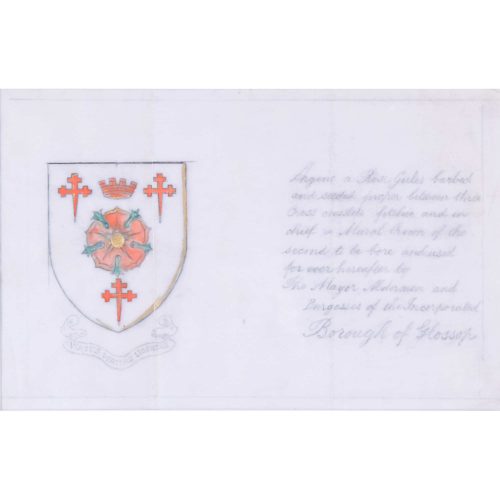
Florence Camm (1874-1960) Design for stained glass window for the Arms of the Borough of Glossop
Watercolour on tracing paper 18x28 cm Design for TW Camm & Co., Smethwick, Birmingham The Camms were stained glass designers who exhibited 48 times at the Royal Academy and also exhibited at The Walker Art Gallery in Liverpool, The Royal Scottish Academy and Royal Birmingham Society of Artists. Following the death of her father, Florence Camm became chief designer at TW Camm with many commissions both nationally and internationally. Florence Camm was the daughter of Thomas William Camm (1839-1912) who founded the stained glass business T W Camm in High Street Smethwick. From 1892-1911 she studied at The Birmingham Municipal School of Art which, unusually for the time, encouraged girls to attend the life drawing classes – drawing fully nude female models and partially draped male models – thus explaining Camm’s skill with the human figure. Students were encouraged to execute their drawings for designs, thus giving them the skills to set up as manufacturers in Birmingham’s Jewellery Quarter. The arts and crafts designer Henry Payne was an influential tutor for Camm, being one of the most influential teachers at the BMSA who was working as a stained glass designer at the time; one of his most notable commissions was a painted mural illustrating Tudor History for the Houses of Parliament in 1908. Following the death of TW Camm, Florence and her brothers – Walter and Robert – took over the business and Florence did most of the designing. If you are interested email info@manningfineart.co.uk or call us on 07929 749056. Condition: In conservation mount and in plastic sleeve for protection. -
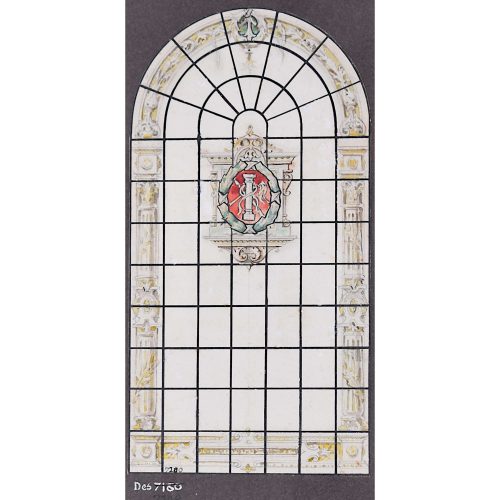
Florence Camm (1874-1960) Design for stained glass window 'The Instruments of the Passion'
Watercolour 20x10 cm Design for TW Camm & Co., Smethwick, Birmingham embossed with their stamp to bottom Numbered 7180/7200 The Camms were stained glass designers who exhibited 48 times at the Royal Academy and also exhibited at The Walker Art Gallery in Liverpool, The Royal Scottish Academy and Royal Birmingham Society of Artists. Following the death of her father, Florence Camm became chief designer at TW Camm with many commissions both nationally and internationally. Florence Camm was the daughter of Thomas William Camm (1839-1912) who founded the stained glass business T W Camm in High Street Smethwick. From 1892-1911 she studied at The Birmingham Municipal School of Art which, unusually for the time, encouraged girls to attend the life drawing classes – drawing fully nude female models and partially draped male models – thus explaining Camm’s skill with the human figure. Students were encouraged to execute their drawings for designs, thus giving them the skills to set up as manufacturers in Birmingham’s Jewellery Quarter. The arts and crafts designer Henry Payne was an influential tutor for Camm, being one of the most influential teachers at the BMSA who was working as a stained glass designer at the time; one of his most notable commissions was a painted mural illustrating Tudor History for the Houses of Parliament in 1908. Following the death of TW Camm, Florence and her brothers – Walter and Robert – took over the business and Florence did most of the designing. If you are interested email info@manningfineart.co.uk or call us on 07929 749056. Conditon: Good. In plastic sleeve for protection. -

Eric Gill
Initial Letter 'H' for The Canterbury Tales (1929) - The Doctor's Tale
Woodblock Print Published Hague & Gill 1934 in an unnumbered edition of 300 23x21cm Following Chichester Technical and Art School, Gill moved to London in 1900 to train with the ecclesiastical architects W D Caroe. Finding architecture somewhat pedestrian he took stonemasonry lessons at Westminster Technical Institute and calligraphy lessons at the Central School of Arts and Crafts, coming under the influence of Edward Johnson, the designer of the London Underground's own typeface. In 1903 he ceased his attempts to become an architect, instead becoming a monumental mason, letter-cutter and calligrapher. Based in Ditchling, he began direct carving of stone figures, the semi-abstract figures taking their influence from mediaeval statuary, mixed with influences from Classical statuary from the Greeks and Romans, with a little post-Impressionism added in. With major commissions from Westminster Cathedral for its Stations of the Cross (1914), a series of War Memorials including the Grade II* memorial in Trumpington, and three of the sculptures for Charles Holden's 1928 headquarters of London Underground at 55 Broadway, St James's, and a series of sculptures for the new 1932 Broadcasting House. The list continues. Never one to rest on his laurels, he was at the same time engaged in typographical adventures. He had collaborated with Edward Johnson on the latter's initial thoughts on his London Transport typeface, but in 1925 designed Perpetua on his own, and Gill Sans between 1927-30. For the Golden Cockerel Press he created, in 1929, a bolder typeface to complement wood engravings. And of course Gill was publishing decorated books. His 1929 Canterbury Tales was an epic work, with a whole series of beautiful wood engravings such as this one. The present print is from the 1934 edition for Faber & Faber ('Engravings 1928-1933 by Eric Gill') he printed with his son-in-law, Rene Hague, produced with the original engraved wood blocks. In Chaucer's Tales, the Summoner's Tale tells the story of the man who summonsed people to the ecclesiastical courts. It satirises the friar, considering him to be corrupt. Philip Hofer was a curator and collector, and commissioned this fine Ex Libris plate from Gill. If you are interested email info@manningfineart.co.uk or call us on 07929 749056. Condition: Generally very good condition. -
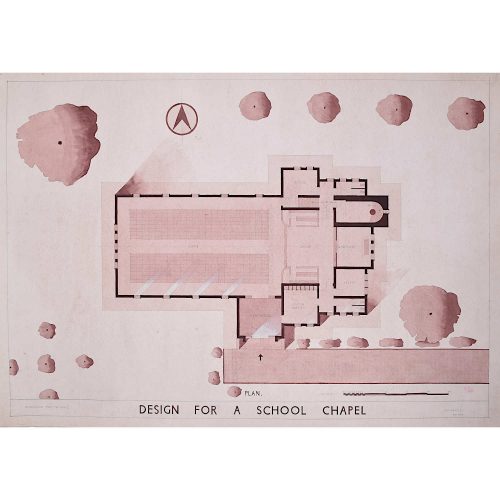
V A Hards (British, c. 1930-c. 2012) Design for Modernist School Chapel
Watercolour on wove Signed and dated November 1948 and marked 35/40 55x77cm Hards was educated at Brixton School of Building and Woolwich Polytechnic between 1948 and 1956, during which period he produced some very competent work including this rather fun modernist design for a riverside tearoom. Brixton School of Building was incorporated into the Polytechnic of the South Bank - now London South Bank University. If you are interested email info@manningfineart.co.uk or call us on 07929 749056. Condition: Some edge wear and isolated spots. -
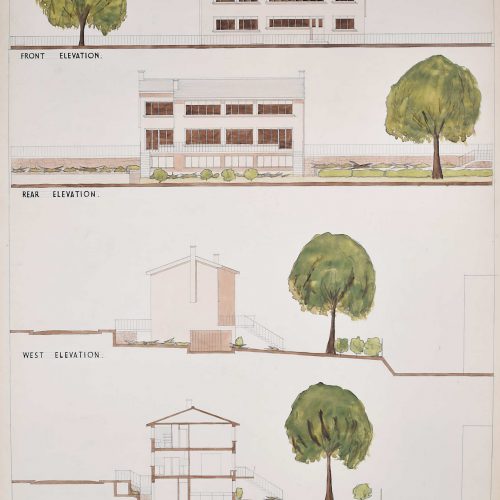
V A Hards (British, c. 1930-c. 2012) Design for Modernist Town House
Watercolour on wove Signed and dated October 1949 and inscribed Woolwich Polytechnic. 77x55cm Hards was educated at Brixton School of Building and Woolwich Polytechnic between 1948 and 1956, during which period he produced some very competent work including this rather fun modernist brutalist design for a town house. Brixton School of Building was incorporated into the Polytechnic of the South Bank - now London South Bank University. If you are interested email info@manningfineart.co.uk or call us on 07929 749056. Condition: Some edge wear and isolated spots. -

V A Hards (British, c. 1930-c. 2012) Design for Monumental Fountain
Watercolour on wove Signed and dated 1955 55x77cm Hards was educated at Brixton School of Building and Woolwich Polytechnic between 1948 and 1956, during which period he produced some very competent work including this rather fun modernist design for a monumental fountain in a grand park. Brixton School of Building was incorporated into the Polytechnic of the South Bank - now London South Bank University. If you are interested email info@manningfineart.co.uk or call us on 07929 749056. Condition: Some edge wear and isolated spots. -
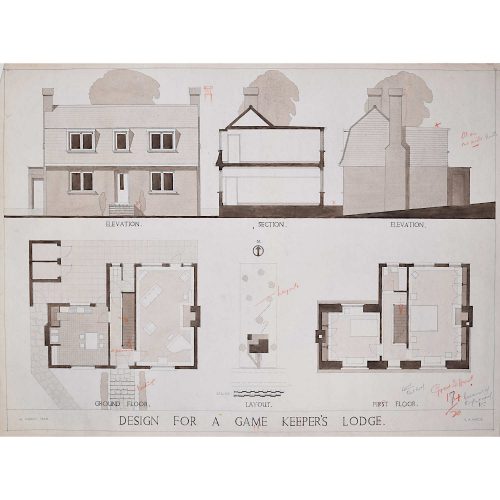
V A Hards (British, c. 1930-c. 2012) Design for Modernist Game Keeper Lodge
Watercolour on wove Signed and dated March 1948 55x77cm Hards was educated at Brixton School of Building and Woolwich Polytechnic between 1948 and 1956, during which period he produced some very competent work including this rather fun modernist design for a monumental fountain in a grand park. Brixton School of Building was incorporated into the Polytechnic of the South Bank - now London South Bank University. If you are interested email info@manningfineart.co.uk or call us on 07929 749056. Condition: Some edge wear and isolated spots . -

V A Hards (British, c. 1930-c. 2012) Design for Modernist Town House
Watercolour on wove Signed and dated October 1949 and inscribed Woolwich Polytechnic. 77x55cm Hards was educated at Brixton School of Building and Woolwich Polytechnic between 1948 and 1956, during which period he produced some very competent work including this rather fun modernist brutalist design for a town house. Brixton School of Building was incorporated into the Polytechnic of the South Bank - now London South Bank University. If you are interested email info@manningfineart.co.uk or call us on 07929 749056. Condition: Some edge wear and isolated spots. -

V A Hards (British, c. 1930-c. 2012) Design for Modernist Fisherman's Hut
Watercolour on wove Signed and dated March 1956 and stamped for Brixton School of Building. 77x55cm Hards was educated at Brixton School of Building and Woolwich Polytechnic between 1948 and 1956, during which period he produced some very competent work including this rather fun modernist brutalist design for a fisherman's hut, not designed to blend in with the scenery. Brixton School of Building was incorporated into the Polytechnic of the South Bank - now London South Bank University. To view more of his work we have listed, scroll down to 'View more from this seller' and click on 'View all from this seller' and then search for 'Hards'. If you are interested email info@manningfineart.co.uk or call us on 07929 749056. Condition: Good. Some edge wear and isolated spots. -
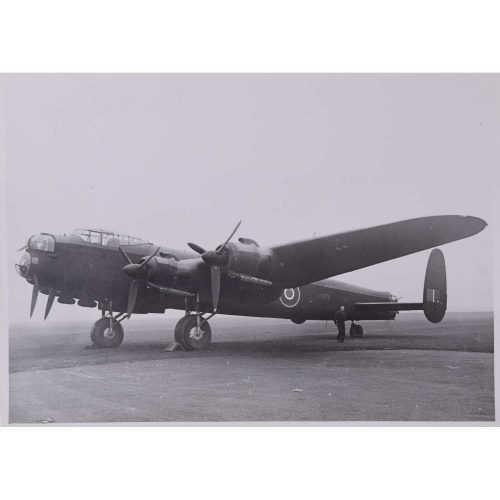
Lancaster LL678 'Lily Mars' - 1
Silver Gelatin photograph, December 1943 12 x 16 cm Stamped to reverse 'The Photograph has been passed by Censor' 'Copyright This TP copyright illustration from "The Aeroplane" must not be reproduced without the written permission of Temple Press Ltd'. 'A general view of an Avro Lancaster II with Hercules radial motors.' 300 Lancaster II aeroplanes were made, fitted with Bristol Hercules radial engines, as there was a worry that there would be a shortage of Merlin engines, reserved for the Spitfire and Hurricane. Lily Mars was named after the 1943 American musical starring Judy Garland and was based at RAF Waterbeach, in Cambridgeshire. An excellent podcast (click) gives details of the final flight on 13 June 1944 which was to be the final raid of the crew's tour. The bombing raid was of 303 Lancasters against the Nordstern synthetic oil plant at Gelsenkichen in the Ruhr, deep inside Germany and the aircraft took off at 23.12 hrs. On the home run LL678 was intercepted and shot down by a night fighter capitained by Oberleutnant Schmidt in a Bf 110 at 01.24 hrs at Zuidloo, a small hamlet, where five of the eight crew are buried; the other three crew members baled out and escaped. A memorial plaque was laid on 4 May 2016 and a Lancaster flypast was arranged. Owing to technical problems a Dakota from the BBMF was sent instead. On 4 May 2022 the Lancaster of the BBMF undertook a flypast which can be seen here. Dietrich Schmidt (1919-?) had 29 confirmed night kills by the time of LL678, achieving 41 kills by the end of the war off 171 missions and was awarded the Ritterkreuz - Knight's Cross. In 1999 the living crewmembers, Dutch resistance and Schmidt and his wireless operator met in the Netherlands. -
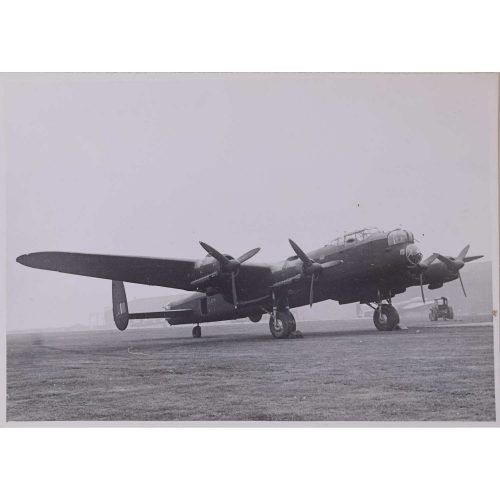
Lancaster LL678 'Lily Mars' - 2
Original Silver Gelatin photograph, December 1943 12 x 16 cm Stamped to reverse 'The Photograph has been passed by Censor' 'Copyright This TP copyright illustration from "The Aeroplane" must not be reproduced without the written permission of Temple Press Ltd'. 'Lancaster II heavy bombers are now flying with RAF BOMBER COMMAND.' 300 Lancaster II aeroplanes were made, fitted with Bristol Hercules radial engines, as there was a worry that there would be a shortage of Merlin engines, reserved for the Spitfire and Hurricane. Lily Mars was named after the 1943 American musical starring Judy Garland and was based at RAF Waterbeach, in Cambridgeshire. A podcast (click) gives details of the final flight on 13 June 1944 which was to be the final raid of the crew's tour. The bombing raid was of 303 Lancasters against the Nordstern synthetic oil plant at Gelsenkichen in the Ruhr, deep inside Germany and the aircraft took off at 23.12 hrs. On the home run LL678 was intercepted and shot down by a night fighter capitained by Oberleutnant Schmidt in a Bf 110 at 01.24 hrs at Zuidloo, a small hamlet, where five of the eight crew are buried; the other three crew members baled out and escaped. A memorial plaque was laid on 4 May 2016 and a Lancaster flypast was arranged. Owing to technical problems a Dakota from the BBMF was sent instead. On 4 May 2022 the Lancaster of the BBMF undertook a flypast which can be seen here. Dietrich Schmidt (1919-?) had 29 confirmed night kills by the time of LL678, achieving 41 kills by the end of the war off 171 missions and was awarded the Ritterkreuz - Knight's Cross. In 1999 the living crewmembers, Dutch resistance, and Schmidt and his wireless operator met in the Netherlands. Provenance: from the collection of Philip J R Moyes, author of many books on the RAF, most notably The Pictorial History which ran to several volumes. -
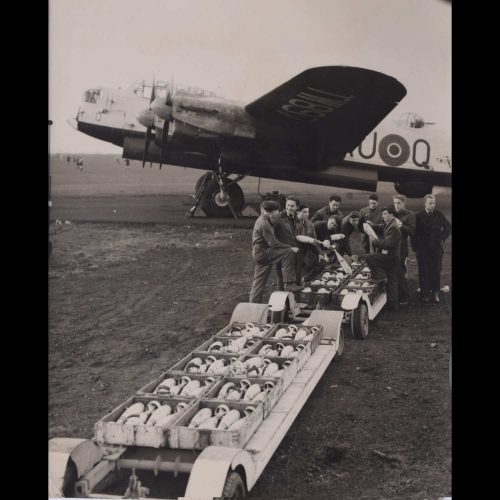
Lancaster Bomber AU-Q loading bombs
Original Silver Gelatin photograph 25 x 20 cm Stamped to reverse 'Copyright Associated Press Photograph' Press release states:LAST MINUTE PREPARATIONS FOR TOMORROW'S ATTACK ON THE FLEET At RAF Station Upwood, Hunts, today, Dec 8th last minute preparations were being carried out for tomorrow's attack on the fleet. Photo shows airmen of 148 Squadron no 3 Bomber Command look over smoke bombs with a Lancaster in background. WOR 339888 Provenance: from the collection of Philip J R Moyes, author of many books on the RAF, most notably The Pictorial History which ran to several volumes. Condition: generally good. -
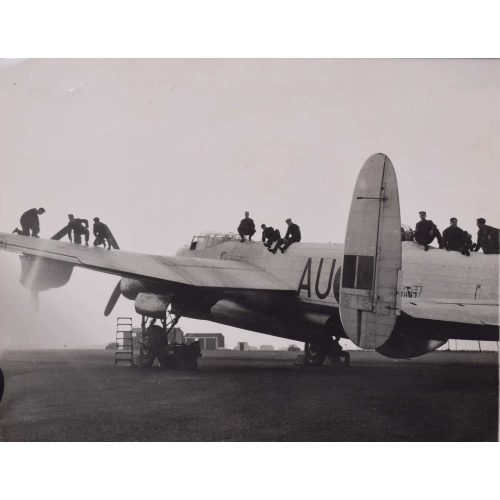
Lancaster Bomber AU-Q loading bombs
Original Silver Gelatin photograph 21 x 25 cm Stamped to reverse 'Copyright Associated Press Photograph' Press release states:LAST MINUTE PREPARATIONS FOR TOMORROW'S ATTACK ON THE FLEET At RAF Station Upwood, Hunts, today, Dec 8th last minute preparations were being carried out for tomorrow's attack on the fleet. Photo shows a Lancaster being made ready for a dawn take off tomorrow photographed this evening against the setting sun. WOR 339889 Associated Press Photo Provenance: from the collection of Philip J R Moyes, author of many books on the RAF, most notably The Pictorial History which ran to several volumes. -
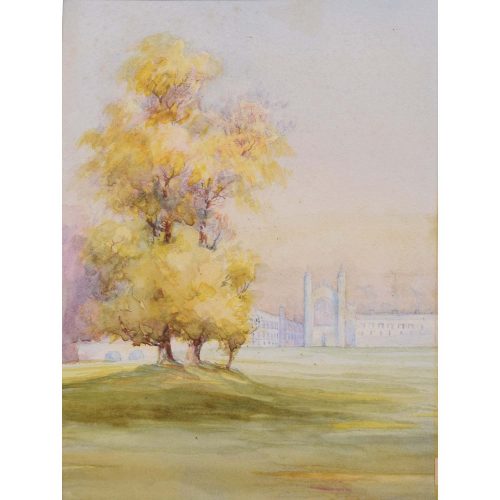
King’s College Cambridge from The Backs
Watercolour 24×16.5cm If you are interested email info@manningfineart.co.ukor call us on 07929 749056. -
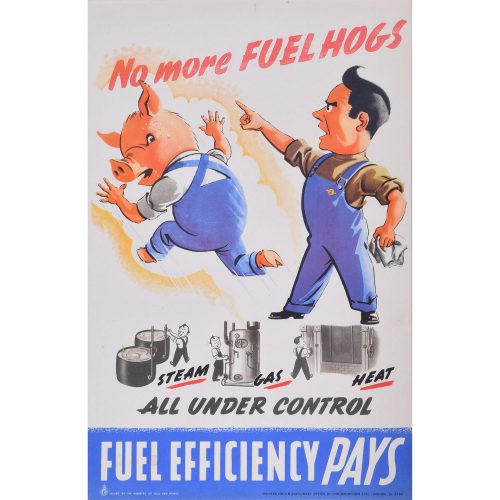
No more Fuel Hogs
Steam, Gas, Heat, all under control. Fuel Efficiency Pays Lithographic poster c. 1940 Printed for HMSO by Chromoworks Limited and issued by the Ministry of Fuel and Power 37x24cm If you are interested email info@manningfineart.co.uk or call us on 07929 749056. -

Don't leave it all to your fuel watcher
Keep on helping him to save HEAT STEAM POWER LIGHT Lithographic poster c. 1940 for HMSO by W R Royle & Son and issued by the Ministry of Fuel and Power 38x25cm If you are interested email info@manningfineart.co.uk or call us on 07929 749056. -
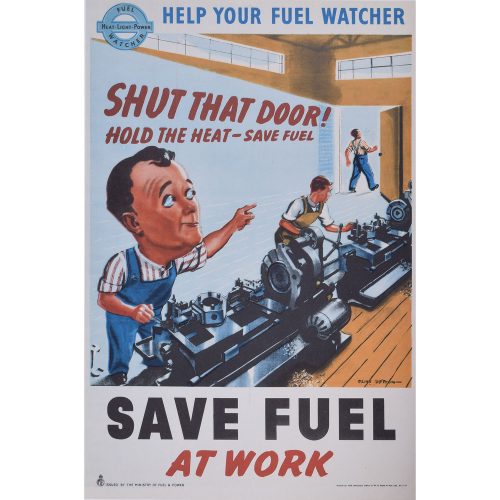
Clive Uppton (1911-2006)
Save Fuel at Work: Shut that Door! Hold the Heat - Save Fuel
Lithographic poster c. 1940 37x25cm Uptton was a widely-published artist, political cartoonist of the Daily Sketch and Sunday Graphic from 1940-42. If you are interested email info@manningfineart.co.ukor call us on 07929 749056. -

Save Fuel in the Kitchens
Lithographic poster c. 1940 37x25cm Printed for HMSO by Nathaniel Lloyd and Co for the Ministry of Fuel and Power Energy was urgently needed to make bombs and fuel the vehicles of war. Britons were endlessly exhorted to save fuel; a message that has no less resonance today. If you are interested email info@manningfineart.co.ukor call us on 07929 749056. -
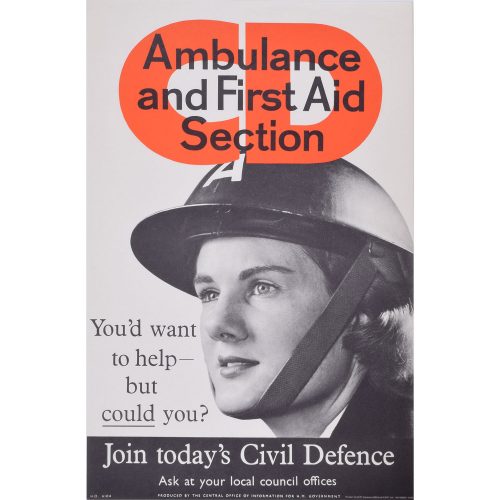
Ambulance and First Aid Section
Lithographic poster probably c. 1940s 36x23cm First established in 1935 the Civil Defence Department was essential for maintaining order during air raids. Here a glamorous young lady - presumably unable to join the army - is volunteering to 'do her bit' by driving an ambulance. If you are interested email info@manningfineart.co.ukor call us on 07929 749056. -
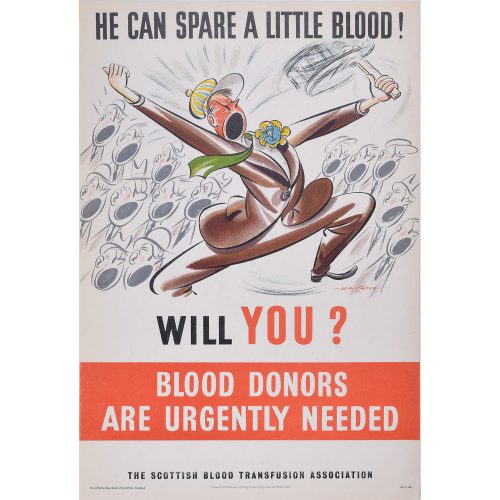
Allan Carter
He can spare a little blood - Blood Donors are Urgently Needed
Lithographic poster c. 1940s 38x25cm Printed for HMSO by Sanders Phillips & Co. The Scottish Blood Transfusion Association If you are interested email info@manningfineart.co.ukor call us on 07929 749056. -
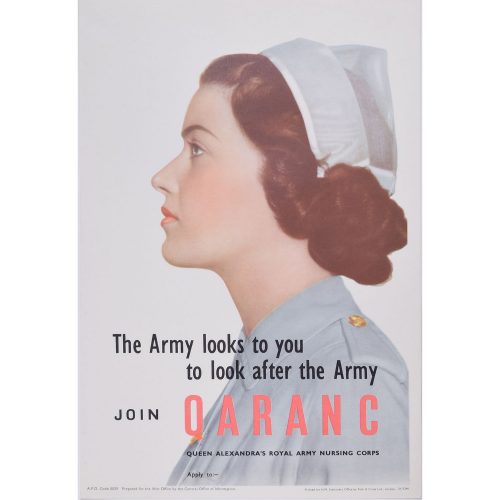
Join QARANC - Queen Alexandra's Royal Army Nursing Corps
The Army looks to you to look after the Army
Lithographic poster c. 1940s 38x25cm Printed for HMSO by Fosh & Kosh Limited, London and prepared for the War Office by the Central Office of Information. If you are interested email info@manningfineart.co.ukor call us on 07929 749056. -
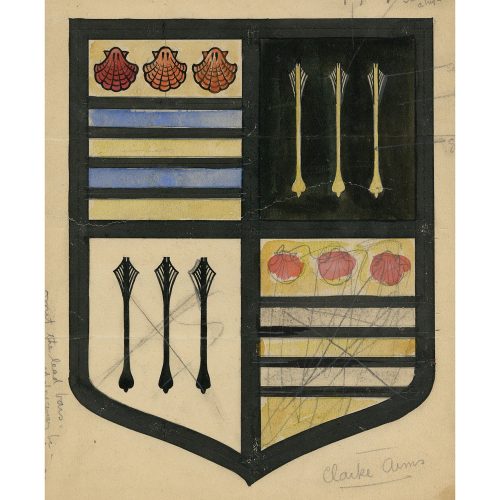
Florence Camm (1874-1960)
Clarke Arms Design
Watercolour and pencil 22x17cm Design for TW Camm & Co. If you are interested email info@manningfineart.co.uk or call us on 07929 749056. -

Peter Collins ARCA (1923-2001) Design for BEA Holiday Brochure 1966 BEA Panorama Holidays
Mixed media on paper 30x21cm Provenance: The Artist's Studio As a graphic designer, Collins produced many brochures such as these. With his fondness for life drawing, he was perhaps a natural choice for the bikini-clad inhabitants of the pages of a holiday brochure. Click here for other items by the artist and for biographical details. If you are interested email info@manningfineart.co.uk or call us on 07929 749056. -
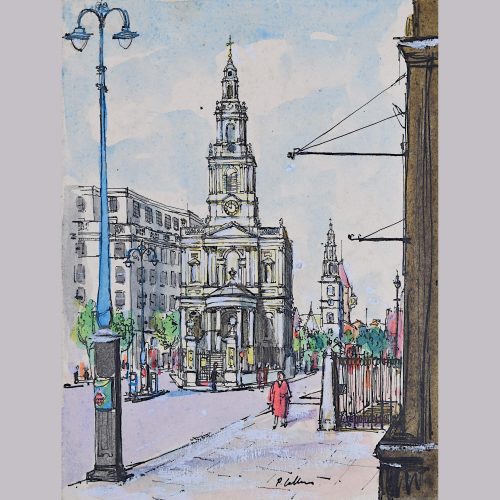
Peter Collins ARCA (1923-2001) St Mary le Strand Church
Watercolour 17 x 21 cm Signed lower right. Provenance: The artist's studio. Typical Collins, with his bright colours and captivating scene, reminiscent of his travel posters, here a passerby in red walks purposely towards the foreground. Click here for other items by the artist and for biographical details. If you are interested email info@manningfineart.co.uk or call us on 07929 749056. -
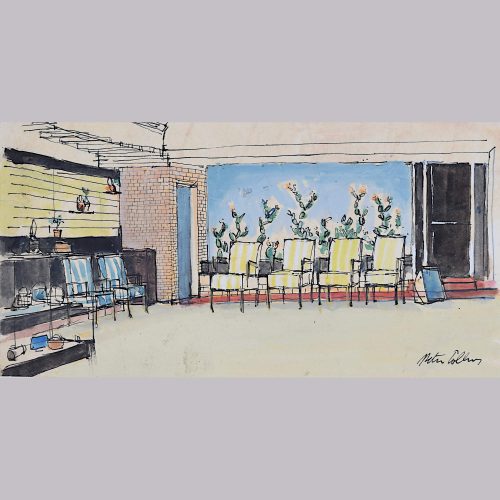
Peter Collins ARCA (1923-2001) Mid Century Modern Lounge Interior
Pen, ink and watercolour 10.5x20.5cm Signed Peter Collins lower right Provenance: The Artist's Studio A stongly-painted image, with a wonderful sense of the light and brightness of a modernist interior. Whether the scene on the back wall is intended to be an extraordinary wallpaper, or whether the view to the garden, we do not know. But the viewer is encouraged to take a seat in an interior that at the time will have felt modern yet comfortable. Click here for other items by the artist and for biographical details. If you are interested email info@manningfineart.co.uk or call us on 07929 749056. -
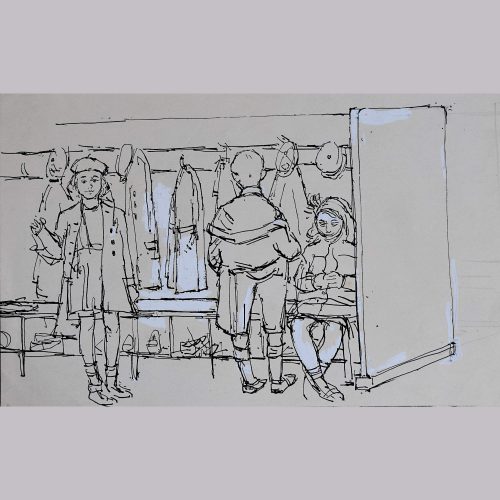
Peter Collins ARCA (1923-2001) School Children in a Cloakroom
Pen, ink and whitening 15x24cm Provenance: The Artist's Studio A stongly-painted image, ensuite with Collins' schoolroom scene that we have listed with a wonderful sense of the light available in a new, post-war school. The schoolboy wears short trousers and - together with schoolgirls - is engaged in the task of time immemorial of waiting in the cloakroom. Shoes are stacked under the benches and coats hang from the hooks. Click here for other items by the artist and for biographical details. If you are interested email info@manningfineart.co.uk or call us on 07929 749056. -
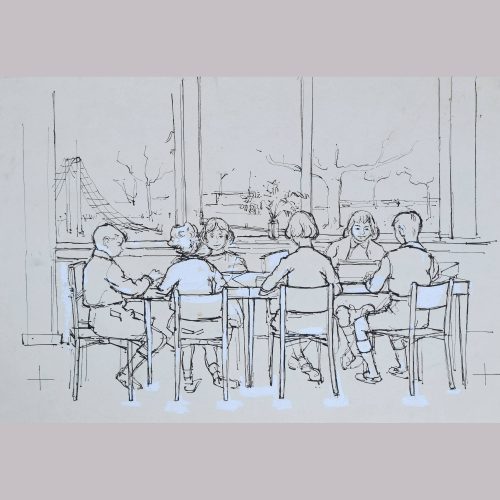
Peter Collins ARCA (1923-2001) The Schoolroom
Pen, ink and whitening 19x27cm Provenance: The Artist's Studio A stongly-painted image, with a wonderful sense of the light available in a new, post-war classroom. The schoolboys wear short trousers and - together with schoolgirls - are engrossed in a task. Click here for other items by the artist and for biographical details. If you are interested email info@manningfineart.co.uk or call us on 07929 749056. -
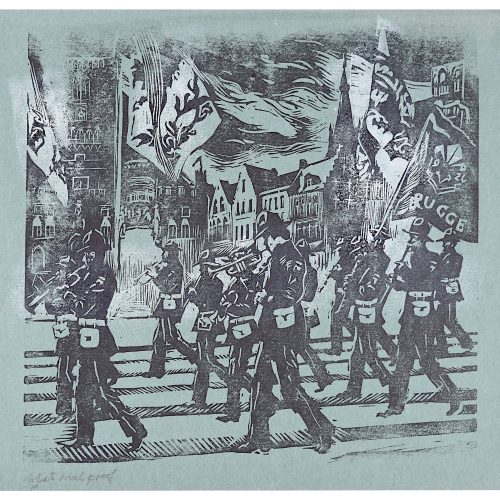
Percy Drake Brookshaw (1907-1993) Marching Band
Linocut c. 1930s 30x30 cm Inscribed 'Artist's trial proof 1A' Provenance: the family of the artist, by descent. Brookshaw was born in Southwark, in London, and educated at the Central School of Arts and Crafts. He was a particularly accomplished lithographer, skilled also as a painter in both oil and watercolour. Identifying the former talent, F Gregory Brown - the poster and textile designer - encouraged him to become an illustrator and poster designer. Producing posters for London Transport and Shell, inter alia, between 1928 and 1958, many of his posters depict sporting events. His two posters for the annual University Boat Race are well known and highly sought after, and his wonderful posters often evoke a feeling of movement, whether rowers straining on their oars, or horses or greyhounds racing. In this carefully executed linocut, Brookshaw brings the band members to life with the same skill and enthusiasm he brings to his posters. If you are interested email info@manningfineart.co.uk or call us on 07929 749056. Condition: Generally very good, some spotting to external margins outside image area. -
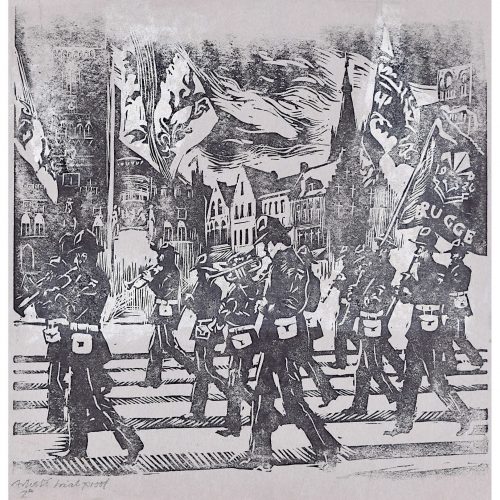
Percy Drake Brookshaw (1907-1993) Marching Band
Linocut c. 1930s 30x30 cm Inscribed 'Artist's trial proof 1A' Provenance: the family of the artist, by descent. Brookshaw was born in Southwark, in London, and educated at the Central School of Arts and Crafts. He was a particularly accomplished lithographer, skilled also as a painter in both oil and watercolour. Identifying the former talent, F Gregory Brown - the poster and textile designer - encouraged him to become an illustrator and poster designer. Producing posters for London Transport and Shell, inter alia, between 1928 and 1958, many of his posters depict sporting events. His two posters for the annual University Boat Race are well known and highly sought after, and his wonderful posters often evoke a feeling of movement, whether rowers straining on their oars, or horses or greyhounds racing. In this carefully executed linocut, Brookshaw brings the band members to life with the same skill and enthusiasm he brings to his posters. If you are interested email info@manningfineart.co.uk or call us on 07929 749056. Condition: Generally very good, some spotting to external margins outside image area. -
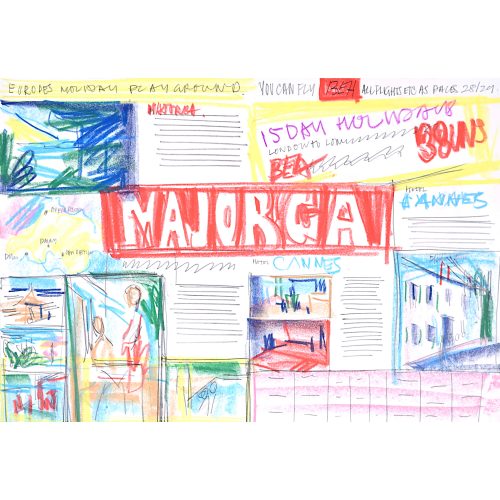
Peter Collins ARCA (1923-2001) Design for Holiday Brochure for Majorca 3 (for BEA Panorama Holidays)
Mixed media 30x45cm Provenance: The Artist's Studio As a graphic designer, Collins produced many brochures such as these. With his fondness for life drawing, he was perhaps a natural choice for the bikini-clad inhabitants of the pages of a holiday brochure. Collins's first job was at an advertising agency, in the commercial studio, whilst he attended evening art classes. World War II interrupted his career and he joined the Royal Artillery (of the British Army), teaching painting and drawing in the Education Corps - whilst simultaneously teaching at St Martin's School of Art, part time. Following the war Collins studied at the Royal College of Art, winning a scholarship. Leaving in 1950 he then worked as a commercial artist producing some well-known posters for clients including British Railways and British European Airways. He was the Art Director at Odhams Press and spent time designing for both ICI and Shell. With his wife Georgette he created the 'Bacombe Galleries' in Sussex, converting a group of buildings. In 1975 they again converted buildings, this time Stanley Studios in Chelsea which were scheduled for redevelopment; many artists had worked there, probably the most famous being Elizabeth Frink. Combining an artist's studio and a single residence at Stanley Studios the Collinses were immersed in Chelsea's art scene and proceeded to fill the place with art, antiques, sculpture and curios. If you are interested email info@manningfineart.co.uk or call us on 07929 749056. Condition: Generally very good. -
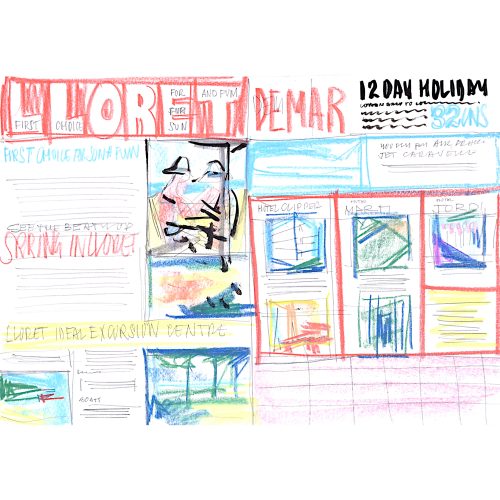
Peter Collins ARCA (1923-2001) Lloret, Spain 2 - Design for Holiday Brochure (for BEA Panorama Holidays)
Mixed media 30x45cm Provenance: The Artist's Studio As a graphic designer, Collins produced many brochures such as these. With his fondness for life drawing, he was perhaps a natural choice for the bikini-clad inhabitants of the pages of a holiday brochure. Collins's first job was at an advertising agency, in the commercial studio, whilst he attended evening art classes. World War II interrupted his career and he joined the Royal Artillery (of the British Army), teaching painting and drawing in the Education Corps - whilst simultaneously teaching at St Martin's School of Art, part time. Following the war Collins studied at the Royal College of Art, winning a scholarship. Leaving in 1950 he then worked as a commercial artist producing some well-known posters for clients including British Railways and British European Airways. He was the Art Director at Odhams Press and spent time designing for both ICI and Shell. With his wife Georgette he created the 'Bacombe Galleries' in Sussex, converting a group of buildings. In 1975 they again converted buildings, this time Stanley Studios in Chelsea which were scheduled for redevelopment; many artists had worked there, probably the most famous being Elizabeth Frink. Combining an artist's studio and a single residence at Stanley Studios the Collinses were immersed in Chelsea's art scene and proceeded to fill the place with art, antiques, scupture and curios. If you are interested email info@manningfineart.co.uk or call us on 07929 749056. Condition: Generally very good. -
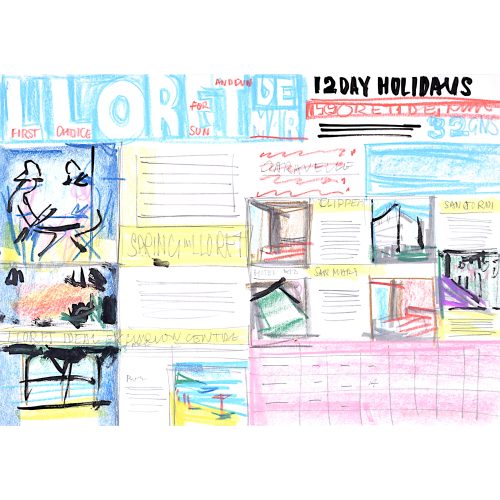
Peter Collins ARCA (1923-2001) Lloret, Spain - Design for Holiday Brochure (for BEA Panorama Holidays)
Mixed media 30x45cm Provenance: The Artist's Studio As a graphic designer, Collins produced many brochures such as these. With his fondness for life drawing, he was perhaps a natural choice for the bikini-clad inhabitants of the pages of a holiday brochure. Collins's first job was at an advertising agency, in the commercial studio, whilst he attended evening art classes. World War II interrupted his career and he joined the Royal Artillery (of the British Army), teaching painting and drawing in the Education Corps - whilst simultaneously teaching at St Martin's School of Art, part time. Following the war Collins studied at the Royal College of Art, winning a scholarship. Leaving in 1950 he then worked as a commercial artist producing some well-known posters for clients including British Railways and British European Airways. He was the Art Director at Odhams Press and spent time designing for both ICI and Shell. With his wife Georgette he created the 'Bacombe Galleries' in Sussex, converting a group of buildings. In 1975 they again converted buildings, this time Stanley Studios in Chelsea which were scheduled for redevelopment; many artists had worked there, probably the most famous being Elizabeth Frink. Combining an artist's studio and a single residence at Stanley Studios the Collinses were immersed in Chelsea's art scene and proceeded to fill the place with art, antiques, scupture and curios. If you are interested email info@manningfineart.co.uk or call us on 07929 749056. Condition: Generally very good. -
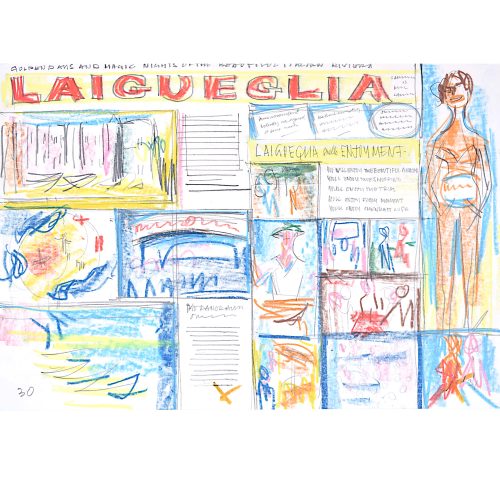
Peter Collins ARCA (1923-2001) Design for Holiday Brochure for Laigueglia Italy (for BEA Panorama Holidays) 3
Mixed media 30x45cm Provenance: The Artist's Studio As a graphic designer, Collins produced many brochures such as these. With his fondness for life drawing, he was perhaps a natural choice for the bikini-clad inhabitants of the pages of a holiday brochure. Collins's first job was at an advertising agency, in the commercial studio, whilst he attended evening art classes. World War II interrupted his career and he joined the Royal Artillery (of the British Army), teaching painting and drawing in the Education Corps - whilst simultaneously teaching at St Martin's School of Art, part time. Following the war Collins studied at the Royal College of Art, winning a scholarship. Leaving in 1950 he then worked as a commercial artist producing some well-known posters for clients including British Railways and British European Airways. He was the Art Director at Odhams Press and spent time designing for both ICI and Shell. With his wife Georgette he created the 'Bacombe Galleries' in Sussex, converting a group of buildings. In 1975 they again converted buildings, this time Stanley Studios in Chelsea which were scheduled for redevelopment; many artists had worked there, probably the most famous being Elizabeth Frink. Combining an artist's studio and a single residence at Stanley Studios the Collinses were immersed in Chelsea's art scene and proceeded to fill the place with art, antiques, scupture and curios. If you are interested email info@manningfineart.co.uk or call us on 07929 749056. Condition: Generally very good. -
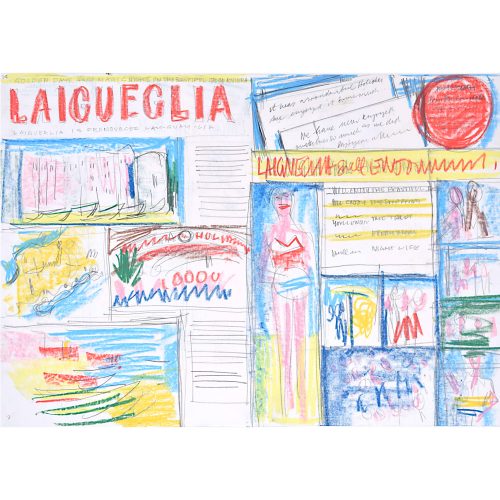
Peter Collins ARCA (1923-2001) Design for Holiday Brochure for Laigueglia Italy (for BEA Panorama Holidays) 4
Mixed media 30x45cm Provenance: The Artist's Studio As a graphic designer, Collins produced many brochures such as these. With his fondness for life drawing, he was perhaps a natural choice for the bikini-clad inhabitants of the pages of a holiday brochure. Collins's first job was at an advertising agency, in the commercial studio, whilst he attended evening art classes. World War II interrupted his career and he joined the Royal Artillery (of the British Army), teaching painting and drawing in the Education Corps - whilst simultaneously teaching at St Martin's School of Art, part time. Following the war Collins studied at the Royal College of Art, winning a scholarship. Leaving in 1950 he then worked as a commercial artist producing some well-known posters for clients including British Railways and British European Airways. He was the Art Director at Odhams Press and spent time designing for both ICI and Shell. With his wife Georgette he created the 'Bacombe Galleries' in Sussex, converting a group of buildings. In 1975 they again converted buildings, this time Stanley Studios in Chelsea which were scheduled for redevelopment; many artists had worked there, probably the most famous being Elizabeth Frink. Combining an artist's studio and a single residence at Stanley Studios the Collinses were immersed in Chelsea's art scene and proceeded to fill the place with art, antiques, scupture and curios. If you are interested email info@manningfineart.co.uk or call us on 07929 749056. Condition: Generally very good. -

Peter Collins ARCA (1923-2001) Design for Holiday Brochure for Laigueglia Italy (for BEA Panorama Holidays) 2
Mixed media 30x45cm Provenance: The Artist's Studio As a graphic designer, Collins produced many brochures such as these. With his fondness for life drawing, he was perhaps a natural choice for the bikini-clad inhabitants of the pages of a holiday brochure. Collins's first job was at an advertising agency, in the commercial studio, whilst he attended evening art classes. World War II interrupted his career and he joined the Royal Artillery (of the British Army), teaching painting and drawing in the Education Corps - whilst simultaneously teaching at St Martin's School of Art, part time. Following the war Collins studied at the Royal College of Art, winning a scholarship. Leaving in 1950 he then worked as a commercial artist producing some well-known posters for clients including British Railways and British European Airways. He was the Art Director at Odhams Press and spent time designing for both ICI and Shell. With his wife Georgette he created the 'Bacombe Galleries' in Sussex, converting a group of buildings. In 1975 they again converted buildings, this time Stanley Studios in Chelsea which were scheduled for redevelopment; many artists had worked there, probably the most famous being Elizabeth Frink. Combining an artist's studio and a single residence at Stanley Studios the Collinses were immersed in Chelsea's art scene and proceeded to fill the place with art, antiques, scupture and curios. If you are interested email info@manningfineart.co.uk or call us on 07929 749056. Condition: Generally very good. -
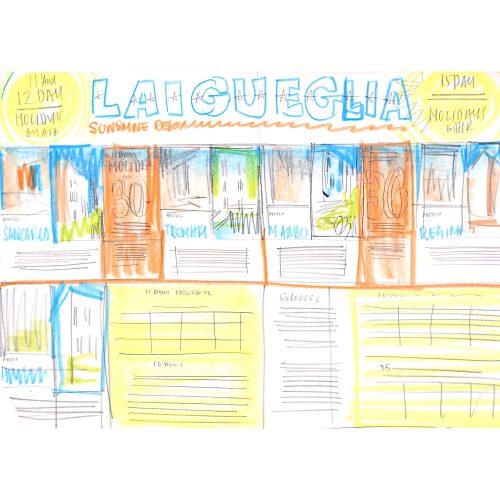
Peter Collins ARCA (1923-2001) Design for Holiday Brochure for Laigueglia Italy (for BEA Panorama Holidays)
Mixed media 30x45cm Provenance: The Artist's Studio As a graphic designer, Collins produced many brochures such as these. With his fondness for life drawing, he was perhaps a natural choice for the bikini-clad inhabitants of the pages of a holiday brochure. Collins's first job was at an advertising agency, in the commercial studio, whilst he attended evening art classes. World War II interrupted his career and he joined the Royal Artillery (of the British Army), teaching painting and drawing in the Education Corps - whilst simultaneously teaching at St Martin's School of Art, part time. Following the war Collins studied at the Royal College of Art, winning a scholarship. Leaving in 1950 he then worked as a commercial artist producing some well-known posters for clients including British Railways and British European Airways. He was the Art Director at Odhams Press and spent time designing for both ICI and Shell. With his wife Georgette he created the 'Bacombe Galleries' in Sussex, converting a group of buildings. In 1975 they again converted buildings, this time Stanley Studios in Chelsea which were scheduled for redevelopment; many artists had worked there, probably the most famous being Elizabeth Frink. Combining an artist's studio and a single residence at Stanley Studios the Collinses were immersed in Chelsea's art scene and proceeded to fill the place with art, antiques, scupture and curios. If you are interested email info@manningfineart.co.uk or call us on 07929 749056. Condition: Generally very good. -
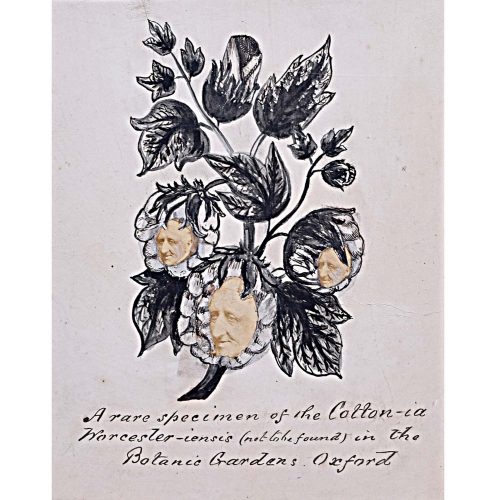
Provost Richard Lynch Cotton Caricature
A rare specimen of the Cotton-ia Worcester-iensis (not to be found) in the Botanic Gardens Oxford
Pen ink watercolour and photographic collage 19.5 x 16 cm By repute, found in the rooms of Keble at the Hermitage Hotel in Eastbourne after his death, together with another watercolour of a ‘Ritualistic Priest’ also for sale. Please contact us for further information. If you are interested email info@manningfineart.co.ukor call us on 07929 749056. Condition: Good. -
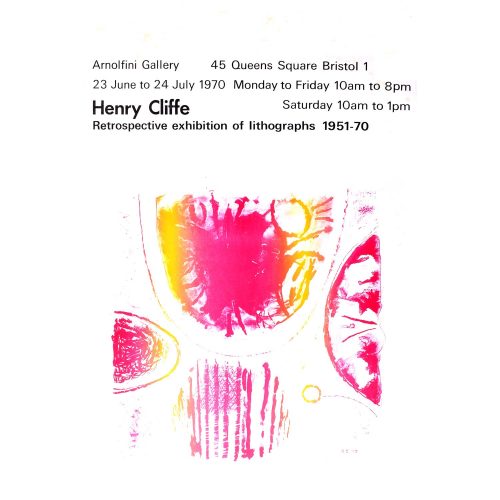
Henry Cliffe (1919-1983) Arnolfini Gallery Exhibition of Lithographs
Etching Mid 20th Century 76x50cm Click here for biographical details and other pictures by the artist. If you are interested email info@manningfineart.co.uk or call us on 07929 749056. Condition: Good, some faint spots at top. -
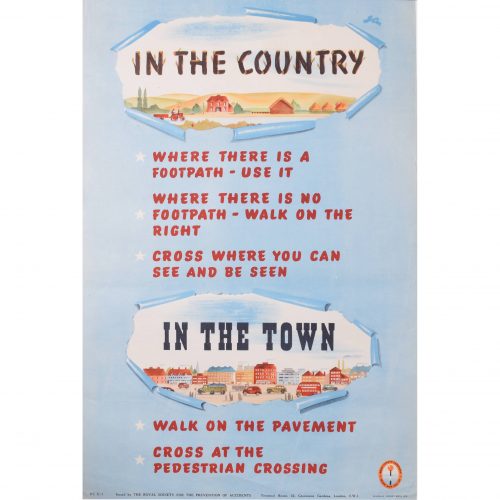
In the Country, In the Town (c. 1960)
Original vintage poster 76 x 50 cm A delightfully quaint vintage poster with a series of important and relevant pedestrian safety messages. From its foundation in 1916 onwards, the Royal Society for the Prevention of Accidents published dozens of highly artistic posters encouraging people to take precautions and prevent injuries (for example, telling factory workers to wear goggles and inspect their tools, or advising drivers to watch out for children in the road). This poster advises those visiting the country to use footpaths and cross roads carefully, and suggests that city-dwellers walk on pavements and only cross at pedestrian crossings. Condition: generally very good. If you are interested, please email info@manningfineart.co.uk or call us on 07929 749056. Click here for other views of St John’s College, Cambridge. -
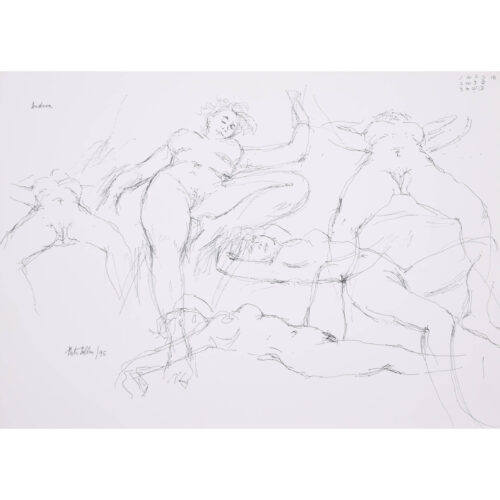
Peter Collins ARCA (1923 - 2001)
Reclining Nude Studies - Andrea (1995)
Ink and wash 32 x 45 cm Signed and dated lower left. Artist's notes upper right. Provenance: the artist's studio sale. Five studies of one of Collins' models, Andrea, reclining. Each study runs into the next, with different perspectives of the model's body folding together. Collins's first job was at an advertising agency, in the commercial studio. World War II interrupted his career and he joined the Royal Artillery (of the British Army), teaching painting and drawing in the Education Corps - whilst simultaneously teaching at St Martin's School of Art, part time. Following the war, Collins studied at the Royal College of Art, winning a scholarship. He then worked as a commercial artist, producing some well-known posters for clients including British Railways and British European Airways. He was the Art Director at Odhams Press and spent time designing for both ICI and Shell. With his wife Georgette, he created the 'Bacombe Galleries' in Sussex, converting a group of buildings into a gallery space. In 1975 they developed the Stanley Studios in Chelsea, which were scheduled for redevelopment, into a combined artists' studio and residence. Moving into the Stanley Studios allowed the Collinses to immerse themselves in Chelsea's art scene, and they proceeded to fill the studios with art, antiques, sculpture, and other curios. Condition: generally very good. If you are interested, please email info@manningfineart.co.uk or call us on 07929 749056. Click here for other works by Peter Collins. -
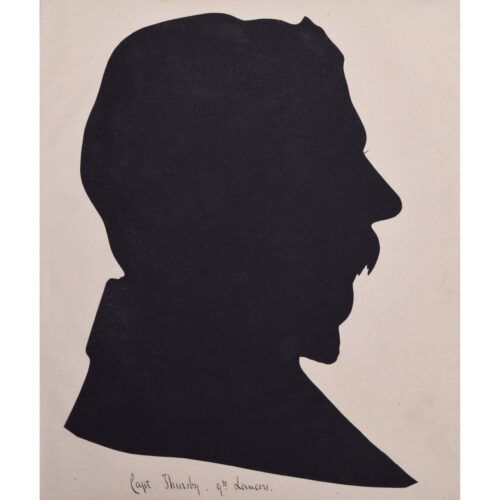
Silhouette (circa 1870)
Captain Thursby, 9th Lancers
Gouache, pen, and ink 52 x 44 cm Captain Piers Thursby was born in 1834 and served in the 9th Queen's Royal Lancers, a cavalry regiment of the British Army, with whom he served during the Indian Mutiny of the 1850s. He was the son of Revd. W. Thursby of Ormerod House and died in 1904. Prior to photography, silhouettes were the easiest way of recording a person's appearance. This set might record the group present at a country house party, a wedding, or other similar convivial occasion. Condition: generally very good; some staining to right edge. If you are interested, please email info@manningfineart.co.uk or call us on 07929 749056. Click here for other silhouettes. -
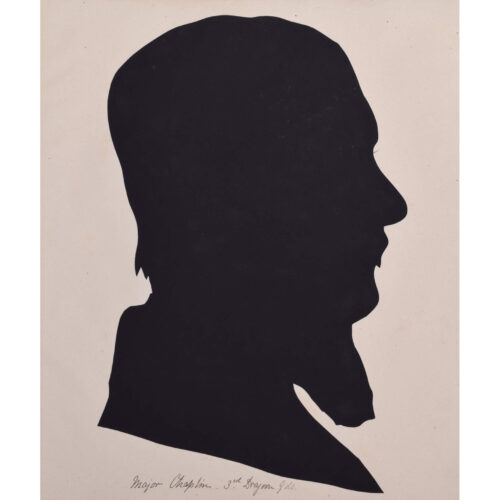
Silhouette (circa 1870)
Major Chaplin, 3rd Dragoon Guards
Gouache, pen, and ink 52 x 44 cm Silhouettes of Mrs F Chaplin and Miss Chaplain, likely the Major's wife and daughter, are also available. Prior to photography, silhouettes were the easiest way of recording a person's appearance. This set might record the group present at a country house party, a wedding, or other similar convivial occasion. Condition: generally very good; some staining to right edge. If you are interested, please email info@manningfineart.co.uk or call us on 07929 749056. Click here for other silhouettes. -
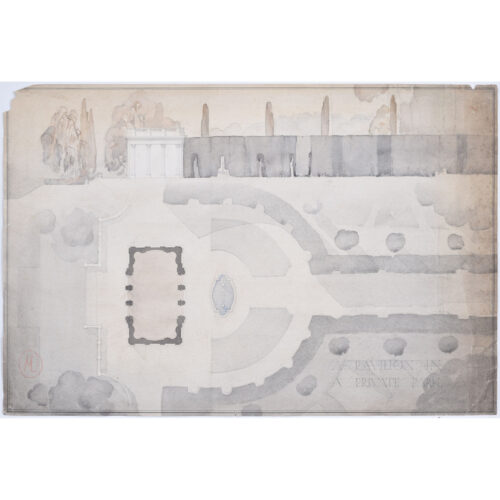
Louis Osman FRIBA (1914 - 1996)
A Pavilion in a Private Park
Pen, ink and wash 67 x 100 cm Provenance: the family of the artist. Signed lower right. Osman was as much an artist as an architect. This is likely a portfolio piece from his time studying at the Bartlett School of Architecture, and is as such a piece of architectural history as well as a beautiful Osman design. Osman was awarded a First Class degree and the Donaldson Medal of the RIBA (for the best result in his year group) by the Bartlett, and then went on to the Slade School of Art. He subsequently trained with Sir Albert Richardson – we also have several Richardson works in our collection. After the war, Osman busied himself as an architect. His work included contributions to Westminster Abbey, and Lincoln, Exeter, Ely, and Lichfield Cathedrals, Staunton Harold Church in Ashby de la Zouch for the National Trust, and of course his folly: the Grade I listed Elizabethan manor house, Canons Ashby in Northamptonshire, now a National Trust property. At Canons Ashby he established a workshop and had a team of silversmiths and goldsmiths working for him. In 1976 he made the gold enamelled coffin that holds the copy of the Magna Carta on view in the United States Capitol, Washington, DC. Condition: generally very good to main central area; loss to top left, creasing, soiling, and edge tears to right (10cm at most). If you’d like to know more, please email info@manningfineart.co.uk or call us on 07929 749056. Click here for other works by Louis Osman. -
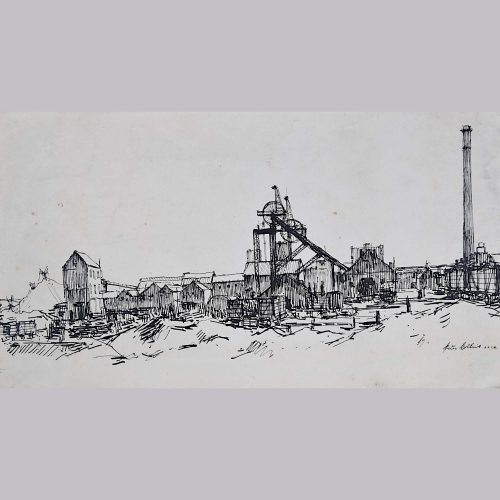
Peter Collins ARCA (1923-2001) Colliery Mining Scene
Pen, ink 20x35cm Provenance: The Artist's Studio The use of pen ank ink creates a powerful image, emphasising the stark nature of the colliery. Yet the scene is softened by the presence of figures, dwarfed against the mighty machinery. The strong vertical lines on the timber-clad buildings emphasise the vertical lines of the pit machinery, and suggest the depths of the earth to which the mine reaches; yet at the same time the horizontal nature of the drawing provides a contrast. Click here for other items by the artist and for biographical details. If you are interested email info@manningfineart.co.uk or call us on 07929 749056. -
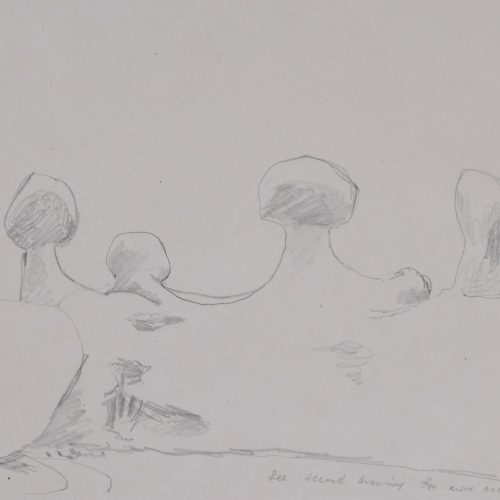
Clifford Ellis (1907-1985) Broad Chalke, Wiltshire
20x33cm Carbon pencil Provenance: the family of the artist, by descent. Born in Bognor in Sussex and trained at St Martin’s School of Art and Regent Street Polytechnic, Ellis was a graphic artist and illustrator who is best known for the posters he produced for London Transport during the 1930s. He generally collaborated with his wife Rosemary – whom he married in 1931 – on their posters. The General Post Office, Shell, and The Empire Marketing Board were also clients for their posters. They signed their posters C&RE, their initials being in alphabetical order and they are readily recognisable by their ebullient use of colour and form. Employed during the war as a camoufleur, along with so many other artists, Clifford was also an official war artist, serving with the Grenadier Guards. Rosemary, meanwhile, was an artist for the Recording Britain project. Following the war they trained art teachers at Bath Academy of Art. They also designed a series of nearly one hundred book jackets for Collins New Naturalist series, published between 1945 and 1982 and were always fascinated by animals and natural history, as with this sketch. If you are interested email info@manningfineart.co.uk or call us on 07929 749056. Condition: Generally very good. -
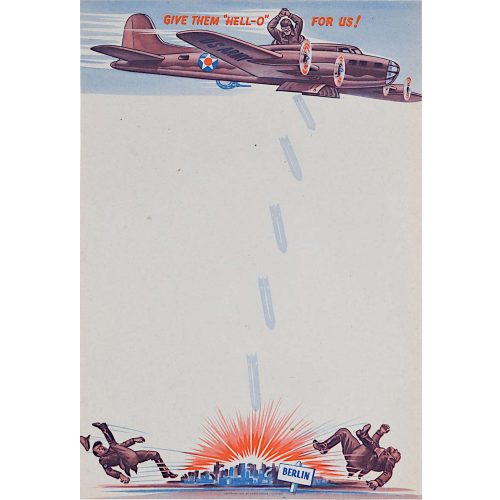
Porto-Service, Chicago Keep 'em Running Right off the Map!
Lithograph 26.5x18cm 1942 What better writing paper to send to a serving serviceman than that encouraging him to fight. Porto-Service of Chicago published a series of illustrated writing resources for sweethearts and friends to write to their brave servicemen, in this case teasing the three Axis dictators. Lavishly produced and printed, the Americans brought some much-needed colour and glamour to dull war-torn Britain. If you are interested email info@manningfineart.co.uk or call us on 07929 749056. Condition: Very good. -
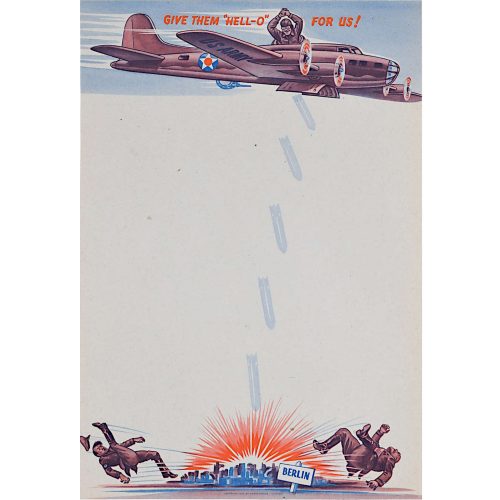
Porto-Service, Chicago Give them "Hell-o from us!"
Lithograph 26.5x18cm 1942 What better writing paper to send to a serving serviceman than one encouraging him to fight. Porto-Service of Chicago published a series of illustrated writing resources for sweethearts and friends to write to their brave servicemen, in this case in a four-engined bomber over Berlin. Lavishly produced and printed, the Americans brought some much-needed colour and glamour to dull war-torn Britain. If you are interested email info@manningfineart.co.uk or call us on 07929 749056. Condition: Very good. -
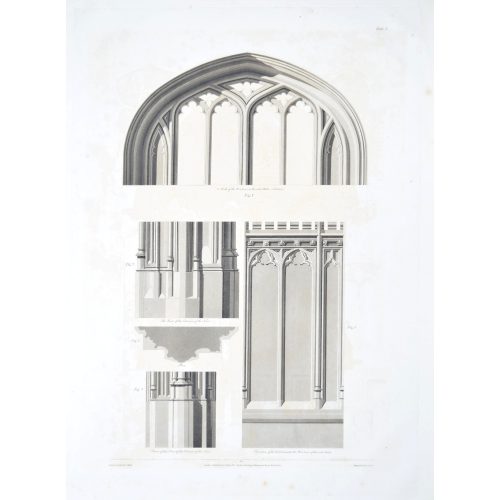
Frederick Nash (1782-1856) Drawn and etched Engraved by F C Lewis Arches and Columns
London Published by F Nash, No 6 Asylum Buildings, Westminster Road July 12 1804 55x39cm Frederick Nash was born in Lambeth. Initially studying architectural drawing under Thomas Malton he subsequently enrolled at the Royal Academy of Arts. From 1801 to 1809 he worked with the antiquarians John Britton and Edward Wedlake Brayley, subsequently becoming a member of the Society of Painters in Watercolours - a group of painters who had left the Royal Academy following complaints of under-recognition of their works. Latterly primarily a landscape painter he toured the rivers of Germany. If you are interested email info@manningfineart.co.uk or call us on 07929 749056. Condition: In generally good condition, some offsetting of ink from adjacent print as visible in image, occasional spotting. Not trimmed. -
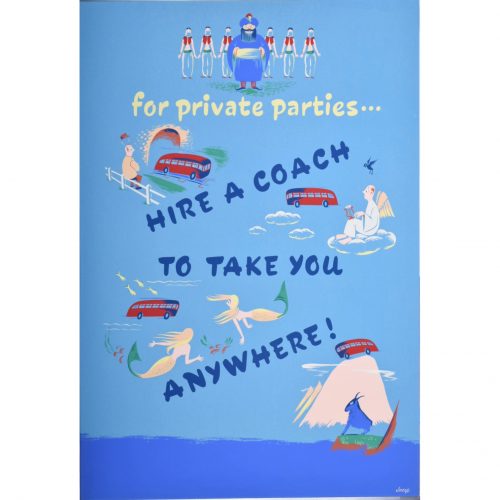
"Jacqs" (British, 20th century) For Private Parties... Hire a Coach to Take You Anywhere
Original Poster c. 1960s 75x50cm If you are interested email info@manningfineart.co.uk or call us on 07929 749056. Condition: Excellent. -
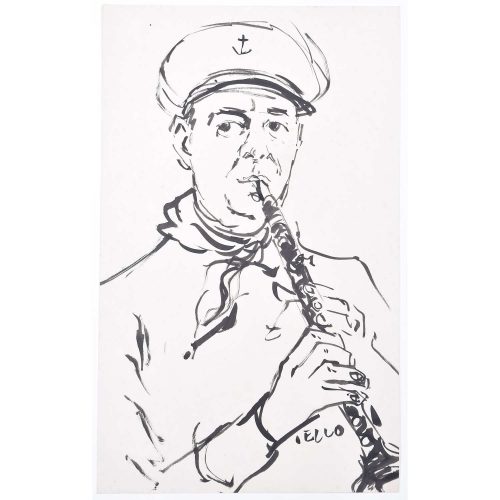
Peter Collins ARCA (1923-200 Royal Naval Bandsman
Black paint 44x27cm Provenance: The Artist's Studio If you are interested email info@manningfineart.co.uk or call us on 07929 749056. Condition: Generally good, a little gentle spotting. Click here for other items by the artist and for biographical details. -
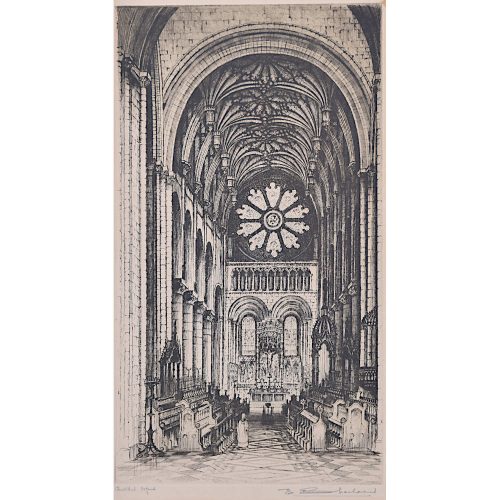
Edward W Sharland (1884-1967) - British Christ Church Cathedral Oxford interior
Etching 32x18cm Sharland was a Bristol-based artist who specialised in architectural views such as this, the interiors of cathedrals being a particular speciality. The British Museum holds copies of his cathedral interior etchings. -
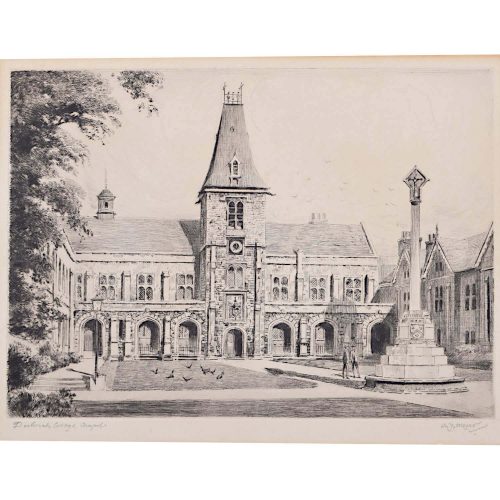
A J Meyer (British, fl 1900-1930) Dulwich College
Etching 22x30cm Sadly little is known of Meyer, an accomplished artist and particularly producer of etchings. He was one of many artists to join the craze for etchings started by Whistler and that died out after the 1929 Wall Street crash. If you are interested email info@manningfineart.co.uk or call us on 07929 749056. Condition: Mounted to board; generally good to very good. -
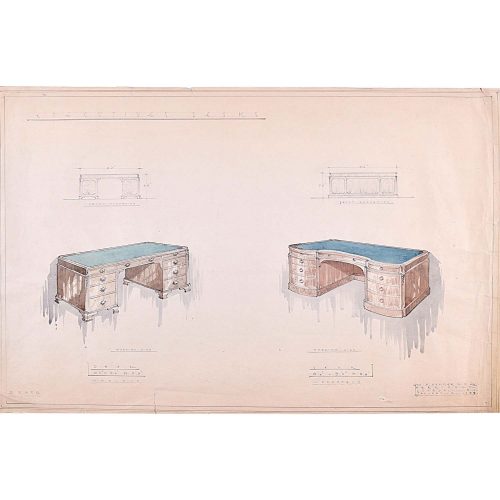
D.L Hadden
Design for Executive Desks Geo.M.Hammer
Watercolour and pencil 41x51cm Signed and dated 1959 Two beautifully detailed executive desks designs with sketches front elevations. Hadden's flair with woodwork design is evident in this masterful drawing. For biographical details and other works by the artist click here. If you are interested email info@manningfineart.co.uk or call us on 07929 749056. Condition: Generally good, some soft creases round the margins. -
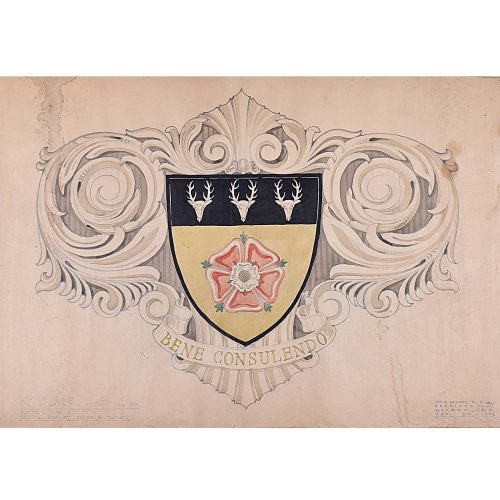
D.L Hadden
Design for Coat of Arms for Council Chambers
Watercolour and pencil 52x74.5cm Signed and dated 1959 A traditional coat of arms design for the city council chambers with directions by the artist that it is to be carved in lime and coloured as depicted. One of the many works Hadden produced during his time as senior designer at Geo M Hammer. For biographical details and other works by the artist click here. If you are interested email info@manningfineart.co.uk or call us on 07929 749056. Condition: Generally good, some water staining as visible in image. -
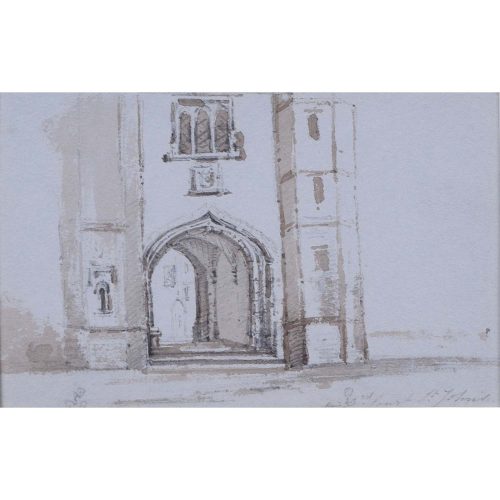
Marianne James
Entrance to Third Court St. John’s College Cambridge (c.1810-1860)
Watercolour & pencil Signed 10×17cm If you are interested email info@manningfineart.co.uk or call us on 07929 749056. Condition: Good. -
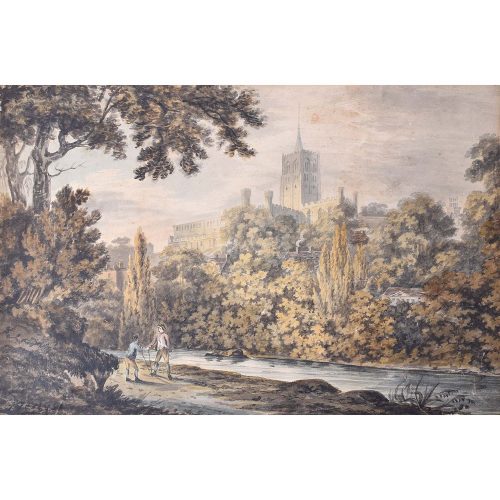
Anon. Prospect of Durham from the River Wear
Watercolour 19th Century 30.5x45.5cm Bears signature 'J Varley' If you are interested email info@manningfineart.co.uk or call us on 07929 749056. Condition: Generally good, backed to board and slight loss of colour. -
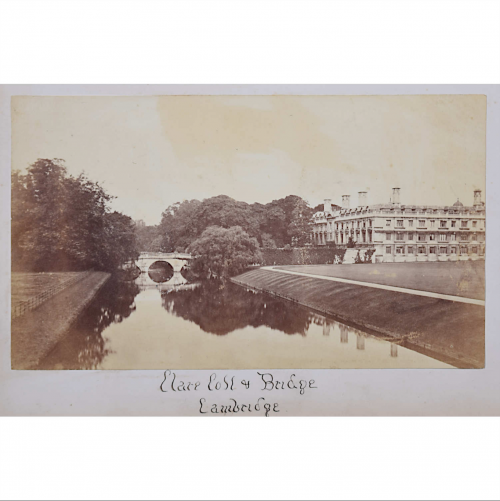
Clare College and Bridge, Cambridge
Albumen print of a photograph, circa 1850 Mounted to board and inscribed 'Clare Coll + Bridge Cambridge'. Clare College is a constituent college of the University of Cambridge in Cambridge. The college was founded in 1326 as University Hall, making it the second-oldest surviving college of the University after Peterhouse. It was refounded in 1338 as Clare Hall after an endowment from Elizabeth de Clare, and took on its current name in 1856. Clare is famous for its chapel choir and for its gardens on The Backs, overlooking the River Cam. Condition: generally very good, slight toning to sky. If you’d like to know more, please email info@manningfineart.co.uk or call us on 07929 749056. -
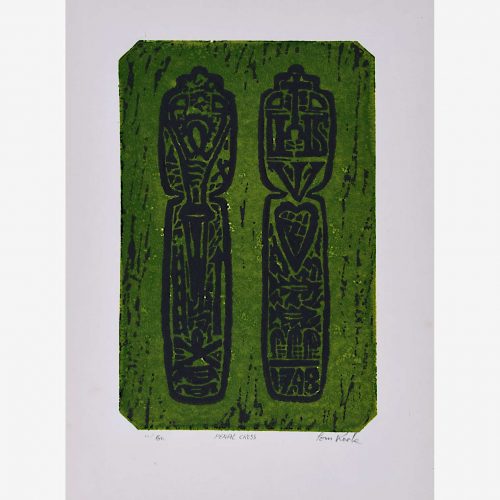
Tom Roche (b. 1940) Penal Cross
Screenprint 24x19cm Signed in pencil and numbered 11/40 Roche trained at the Irish National College of Art and Design, then studying etching and lithography at Chelsea College of Art. After working as a graphic designer in advertising, he became a full-time painter in 1972 based in Dingle in Co. Kerry. After operating from a gallery in Dingle he returned in the 1980s to Dublin, working as part0time lecturer at the Dun Laoghaire School of Art and Design and as creative director for Emerald City Productions Ltd. He is renowned for his soft, atmospheric paintings of Irisih landscape and interiors as well as for his prints such as this. If you are interested email info@manningfineart.co.uk or call us on 07929 749056. -
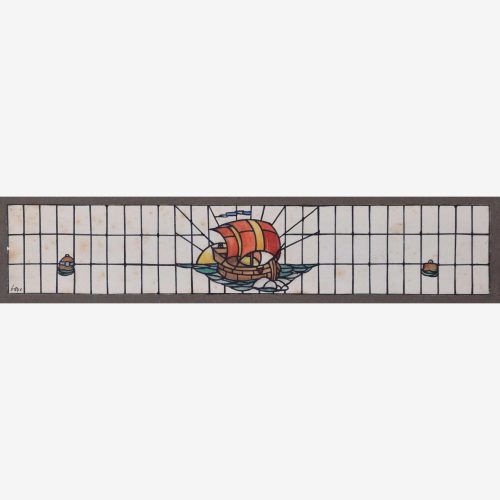
Florence Camm (1874-1960)
Stained Glass Window Design with Red Sailing Ship
Watercolour 6.5x34cm Condition: Some spotting to image; mounted to board - see image. Click for biographical details and other works by Camm. If you are interested email info@manningfineart.co.uk or call us on 07929 749056. -
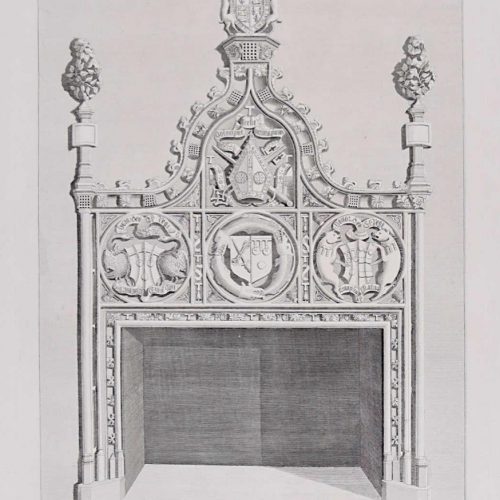
James Basire
James Basire engraving of Bishop's Palace Exeter
Engraving 50 x 33 cm (to plate mark) Published by the Society of Antiquaries 23rd April 1796. A member of the Society of Antiquaries, Basire specialised in architectural prints. He was appointed as engraver to the society, much of his finest works being found in their Vestuta Monumenta. Basire's father Isaac was a cartographer, and both his son and grandson were called James and also worked for the society. William Blake was apprenticed to Basire for seven years. If you are interested, email info@manningfineart.co.ukor call us on 07929 749056. -
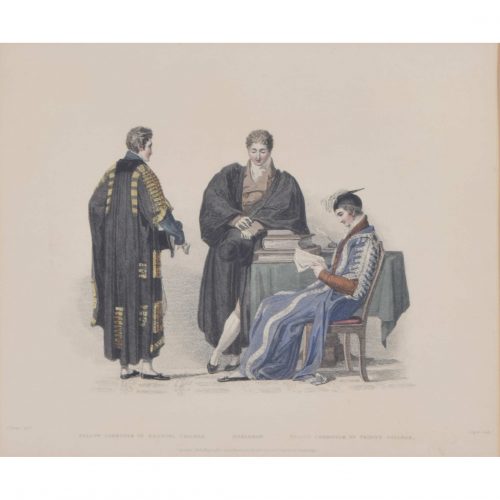
John Samuel Agar (1773 - 1858) after John Uwins (1782 - 1857)
Fellow Commoner of Emanuel College; a Nobleman; Fellow Commoner of Trinity College (1815)
Hand-coloured aquatint 25 x 29.5 cm Published by Rudolph Ackermann (1764 - 1834). An engraving of two students and a nobleman from Ackermann's ''A History of the University of Cambridge, Its Colleges, Halls and Public Buildings''. The three figures dwell over a pile of books and papers, clad in the appropriate academic dress. Thomas Uwins RA RWS was a British painter in watercolour and oil, and a book illustrator. He became a full member of the Old Watercolour Society and a Royal Academician, and held a number of high-profile art appointments including the librarian of the Royal Academy, Surveyor of Pictures to Queen Victoria and the Keeper of the National Gallery. In the late 1790s he began producing work for Ackermann''s collections. John Samuel Agar was an English portrait painter and engraver, who exhibited his works at the Royal Academy from 1796 to 1806 and at the British Institution until 1811. He was at one time president of the Society of Engravers. Rudolph Ackermann published many of his engravings. Rudolph Ackermann was an Anglo-German bookseller, inventor, lithographer, publisher and businessman. In 1795 he established a print-shop and drawing-school at 96 Strand. Here Ackermann set up a lithographic press and began a trade in prints. He later began to manufacture colours and thick carton paper for landscape and miniature painters. Within three years the premises had become too small and he moved to 101 Strand, in his own words "four doors nearer to Somerset House", the seat of the Royal Academy of Arts. Between 1797 and 1800 Ackermann rapidly developed his print and book publishing business, encompassing many different genres including topography, caricature, portraits, transparencies and decorative prints. Condition: good. Some age toning. If you’d like to know more, please email info@manningfineart.co.uk or call us on 07929 749056. -
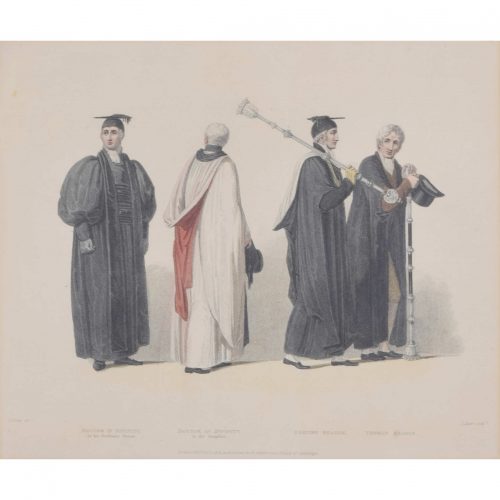
John Samuel Agar (1773 - 1858) after John Uwins (1782 - 1857)
Doctors in Divinity, Esquire Beadle, and Yeoman Beadle (1815)
Hand-coloured aquatint 25 x 30 cm Published by Rudolph Ackermann (1764 - 1834). An engraving of two Doctors in Divinity and two beadles (administrative assistants to the Chancellor and Proctors of the University) from Ackermann's ''A History of the University of Cambridge, Its Colleges, Halls and Public Buildings''. The four figures walk forward with ceremonial accoutrements, likely to a graduation ceremony. Thomas Uwins RA RWS was a British painter in watercolour and oil, and a book illustrator. He became a full member of the Old Watercolour Society and a Royal Academician, and held a number of high-profile art appointments including the librarian of the Royal Academy, Surveyor of Pictures to Queen Victoria and the Keeper of the National Gallery. In the late 1790s he began producing work for Ackermann''s collections. John Samuel Agar was an English portrait painter and engraver, who exhibited his works at the Royal Academy from 1796 to 1806 and at the British Institution until 1811. He was at one time president of the Society of Engravers. Rudolph Ackermann published many of his engravings. Rudolph Ackermann was an Anglo-German bookseller, inventor, lithographer, publisher and businessman. In 1795 he established a print-shop and drawing-school at 96 Strand. Here Ackermann set up a lithographic press and began a trade in prints. He later began to manufacture colours and thick carton paper for landscape and miniature painters. Within three years the premises had become too small and he moved to 101 Strand, in his own words "four doors nearer to Somerset House", the seat of the Royal Academy of Arts. Between 1797 and 1800 Ackermann rapidly developed his print and book publishing business, encompassing many different genres including topography, caricature, portraits, transparencies and decorative prints. Condition: good. Some age toning. If you’d like to know more, please email info@manningfineart.co.uk or call us on 07929 749056. -
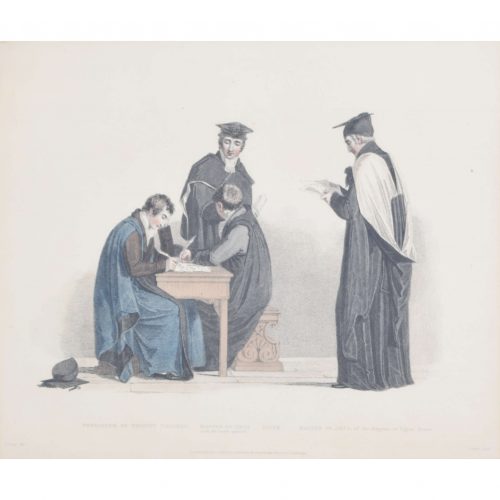
John Samuel Agar (1773 - 1858) after John Uwins (1782 - 1857)
Pensioner of Trinity College, Masters of Arts, and Sizer (1815)
Hand-coloured aquatint 25 x 30 cm Published by Rudolph Ackermann (1764 - 1834). An engraving of a pensioner of Trinity College, Masters of Arts, and a sizer (that is, an undergraduate who receives some form of assistance such as meals, lower fees or lodging during his or her period of study, in some cases in return for doing a defined job) from Ackermann's ''A History of the University of Cambridge, Its Colleges, Halls and Public Buildings''. The four figures walk forward with ceremonial accoutrements, likely to a graduation ceremony. At Cambridge, a sizar was originally an undergraduate student who financed his studies by undertaking more or less menial tasks within his college but, as time went on, was increasingly likely to receive small grants from the college. Certain colleges, including St John's and Trinity, distinguished between two categories of sizar: there were specific endowments for specific numbers of sizars who were called "proper sizars"; those who were not so endowed, but who were maintained by fellow-commoners and fellows were called subsizars. Isaac Newton matriculated as subsizar at Trinity College. Richard S. Westfall noted that sizars were considerably more successful in gaining degrees than the gentlemen who entered Cambridge in the seventeenth century. Thomas Uwins RA RWS was a British painter in watercolour and oil, and a book illustrator. He became a full member of the Old Watercolour Society and a Royal Academician, and held a number of high-profile art appointments including the librarian of the Royal Academy, Surveyor of Pictures to Queen Victoria and the Keeper of the National Gallery. In the late 1790s he began producing work for Ackermann''s collections. John Samuel Agar was an English portrait painter and engraver, who exhibited his works at the Royal Academy from 1796 to 1806 and at the British Institution until 1811. He was at one time president of the Society of Engravers. Rudolph Ackermann published many of his engravings. Rudolph Ackermann was an Anglo-German bookseller, inventor, lithographer, publisher and businessman. In 1795 he established a print-shop and drawing-school at 96 Strand. Here Ackermann set up a lithographic press and began a trade in prints. He later began to manufacture colours and thick carton paper for landscape and miniature painters. Within three years the premises had become too small and he moved to 101 Strand, in his own words "four doors nearer to Somerset House", the seat of the Royal Academy of Arts. Between 1797 and 1800 Ackermann rapidly developed his print and book publishing business, encompassing many different genres including topography, caricature, portraits, transparencies and decorative prints. Condition: good. Some age toning. If you’d like to know more, please email info@manningfineart.co.uk or call us on 07929 749056. -
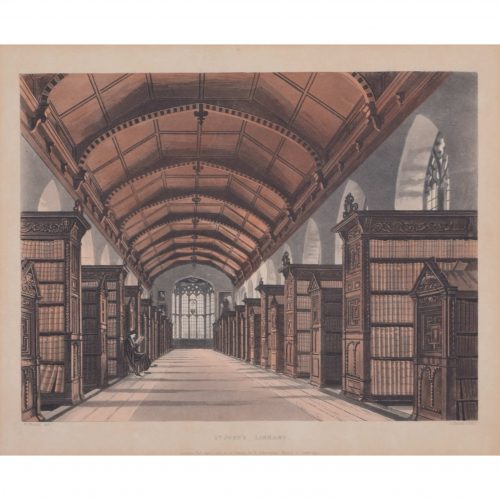
D Havell (1785 - 1822) after William Westall (1781 - 1850)
The Library of St John's College, Cambridge (1815)
Hand-coloured aquatint 24 x 29.5 cm Published by Rudolph Ackermann (1764 - 1834). An engraving of St John's College, Cambridge's marvellous library. It was built between 1623 and 1628, largely through the donations and efforts of two members of the college: Valentine Carey, Bishop of Exeter, and John Williams, Lord-Keeper and Bishop of Lincoln. The building's shell was completed in 1624, a date which appears on the south gable of the western oriel window. The building is constructed in the Jacobean Gothic style, and measures 110 feet by 30 feet wide. The tall two-light windows are a very early example of Gothic Revival, but the façade is Renaissance-inspired. The library contains 42 bookcases arranged at right angles to the north and south walls, and is the home of the College's double-manual harpsichord. William Westall was a British landscape artist. He was born in Hertford and enrolled at the Royal Academy schools in 1799. He later became the draughtsman for a voyage to Australia and the South Seas. After being shipwrecked, he travelled to Canton in China and to India, staying in Bombay for several months. He returned to England in 1805 but later set off for Madeira and Jamaica. He became a member of the Society of Painters in Water Colours (1811) and an associate of the Academy (1812). Following a mental breakdown, he regularly visited the Lake District and published ‘Views of the Valley and Vale of Keswick’ (1820). His series of aquatints of the Thames, the great universities, and England''s public schools for Ackermann are among his most popular works. The Havell family of Reading, Berkshire, England, included a number of notable engravers, etchers and painters, as well as writers, publishers, educators, and musicians. Daniel and Robert Havell set up in partnership as aquatint engravers. Soon Daniel began to work independently, engraving plates for Rudolph Ackermann''s History of Cambridge (1815) and hid history of various public schools including Eton, Winchester, and Rugby (1816), as well as a celebrated views of St Paul''s Cathedral (1818) and various other London landmarks for Ackermann''s Repository of Arts. Rudolph Ackermann was an Anglo-German bookseller, inventor, lithographer, publisher and businessman. In 1795 he established a print-shop and drawing-school at 96 Strand. Here Ackermann set up a lithographic press and began a trade in prints. He later began to manufacture colours and thick carton paper for landscape and miniature painters. Within three years the premises had become too small and he moved to 101 Strand, in his own words "four doors nearer to Somerset House", the seat of the Royal Academy of Arts. Between 1797 and 1800 Ackermann rapidly developed his print and book publishing business, encompassing many different genres including topography, caricature, portraits, transparencies and decorative prints. Condition: good. Some age toning. If you’d like to know more, please email info@manningfineart.co.uk or call us on 07929 749056. -
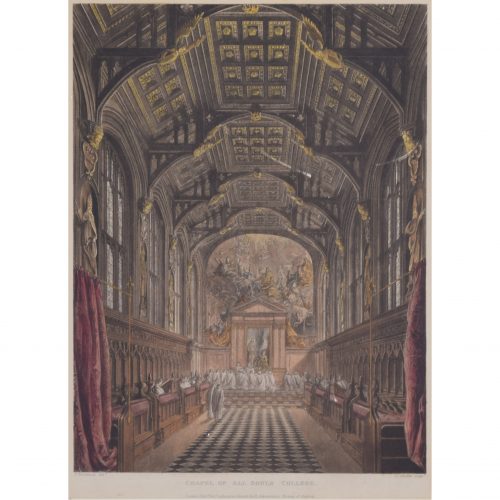
Joseph Constantine Stadler (1755 - 1828) after Frederick Mackenzie (1788 - 1854)
The Chapel of All Souls College, Oxford (1814)
Hand-coloured aquatint 29.5 x 21 cm Published by Rudolph Ackermann (1764 – 1834). An engraving of All Souls' chapel. All Souls College was founded in 1437 by Henry Chichele, Archbishop of Canterbury, to serve as a memorial to Henry V and the English dead in the Hundred Years War. The Front Quad appears virtually unchanged since it was first built in the years 1438-1343, thanks to a sympathetic Victorian restoration. The chapel was modelled after that of New College, where Chichele was a Member. It has a superb hammer-beam roof, excellent mediaeval stained glass, and a large number of original stalls. All services in the chapel are according to the Book of Common Prayer; the King James Bible is also used rather than more modern translations. Frederick Mackenzie (circa 1788 - 1854) was a British watercolourist and architectural draughtsman. He first exhibited at the Royal Academy in 1804, and contributed eleven drawings between that year and 1828. He contributed to the Society of Painters in Water Colours exhibitions from 1813, becoming an associate in 1822, and a full member the following year. From 30 November 1831 until, his death he was treasurer to the society. In later life Mackenzie was no longer commissioned to illustrate books. Joseph Constantine Stadler was a prolific German émigré engraver of images after his contemporaries - here, 18th-century English landscape painter and diarist Joseph Farington. Stadler''s engravings are wide-ranging in subject matter and include landscapes, seascapes and portraits, as well as military, sporting and decorative subjects. Stadler was employed by the leading print publisher of the time, John Boydell. Stadler lived in Knightsbridge when he died at the age of 73. Rudolph Ackermann was an Anglo-German bookseller, inventor, lithographer, publisher and businessman. In 1795 he established a print-shop and drawing-school at 96 Strand. Here Ackermann set up a lithographic press and began a trade in prints. He later began to manufacture colours and thick carton paper for landscape and miniature painters. Within three years the premises had become too small and he moved to 101 Strand, in his own words "four doors nearer to Somerset House", the seat of the Royal Academy of Arts. Between 1797 and 1800 Ackermann rapidly developed his print and book publishing business, encompassing many different genres including topography, caricature, portraits, transparencies and decorative prints. Condition: good. Some age toning. If you’d like to know more, please email info@manningfineart.co.uk or call us on 07929 749056. -
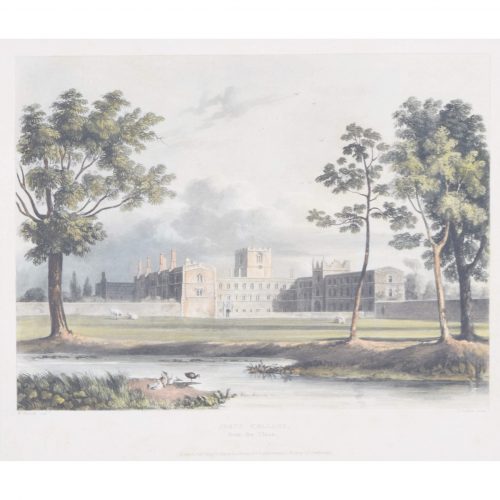
Joseph Constantine Stadler (1755 - 1828) after William Westall (1781 - 1850)
Jesus College, Cambridge, from the Close (1815)
Hand-coloured aquatint 24 x 29.5 cm Published by Rudolph Ackermann (1764 - 1834). An engraving of Jesus College, foregrounded by trees, the River Cam, and grazing cattle. Joseph Constantine Stadler was a prolific German émigré engraver of images after his contemporaries - here, 18th-century English landscape painter and diarist Joseph Farington. Stadler''s engravings are wide-ranging in subject matter and include landscapes, seascapes and portraits, as well as military, sporting and decorative subjects. Stadler was employed by the leading print publisher of the time, John Boydell. Stadler lived in Knightsbridge when he died at the age of 73. William Westall was a British landscape artist. He was born in Hertford and enrolled at the Royal Academy schools in 1799. He later became the draughtsman for a voyage to Australia and the South Seas. After being shipwrecked, he travelled to Canton in China and to India, staying in Bombay for several months. He returned to England in 1805 but later set off for Madeira and Jamaica. He became a member of the Society of Painters in Water Colours (1811) and an associate of the Academy (1812). Following a mental breakdown, he regularly visited the Lake District and published ‘Views of the Valley and Vale of Keswick’ (1820). His series of aquatints of the Thames, the great universities, and England's public schools for Ackermann are among his most popular works. Rudolph Ackermann was an Anglo-German bookseller, inventor, lithographer, publisher and businessman. In 1795 he established a print-shop and drawing-school at 96 Strand. Here Ackermann set up a lithographic press and began a trade in prints. He later began to manufacture colours and thick carton paper for landscape and miniature painters. Within three years the premises had become too small and he moved to 101 Strand, in his own words "four doors nearer to Somerset House", the seat of the Royal Academy of Arts. Between 1797 and 1800 Ackermann rapidly developed his print and book publishing business, encompassing many different genres including topography, caricature, portraits, transparencies and decorative prints. Condition: good. Some age toning. If you’d like to know more, please email info@manningfineart.co.uk or call us on 07929 749056. -
Out of stock
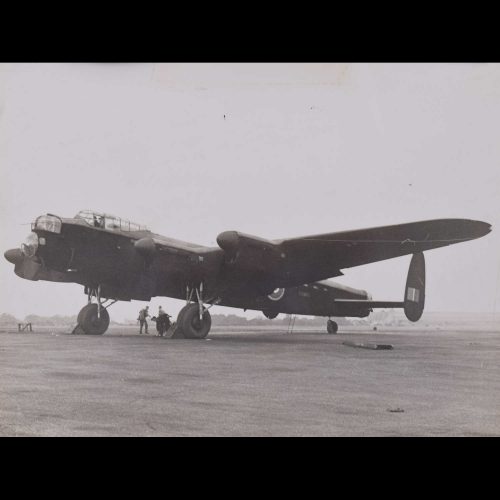
Lancaster Bomber at RAF Waddington
Original Silver Gelatin photograph 16 x 22 cm Stamped to reverse 'Passed by censor' and 'Copyright This photograph must not be reproduced without permission of 'The Aeroplane.' Unfortunately the serial number of the aeroplane is unclear. It may be RAF Waddington-based R5905 of 44 Sqn which crash landed near Madum in Denmark on 24 September 1942. The crew all survived the landing and were taken prisoner, spending the rest of the war in a PoW camp (where one died in March 1945) before returning home. Further details regarding their exploits are here. Alternatively it is R5903 also of 44 Sqn which crashed at Klosterholte on 7 October 1942 having left RAF Waddington; five of the crew survived the crash, with the two airgunners dying. -
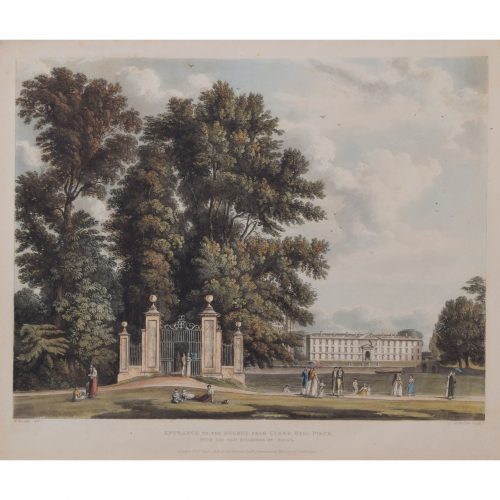
Joseph Constantine Stadler (1755 - 1828) after William Westall (1781 - 1850)
Entrance to the Avenue, from Clare Hall Piece (1815)
Hand-coloured aquatint 25 x 30 cm Published by Rudolph Ackermann (1764 - 1834). An engraving of the gates of Clare College, formerly known as Clare Hall. The River Cam winds its way through the scene; we can see the New Buildings of King's College, Cambridge on the far bank. Victorian figures, several with parasols, picnic or promenade in the foreground. Joseph Constantine Stadler was a prolific German émigré engraver of images after his contemporaries - here, 18th-century English landscape painter and diarist Joseph Farington. Stadler's engravings are wide-ranging in subject matter and include landscapes, seascapes and portraits, as well as military, sporting and decorative subjects. Stadler was employed by the leading print publisher of the time, John Boydell. Stadler lived in Knightsbridge when he died at the age of 73. William Westall was a British landscape artist. He was born in Hertford and enrolled at the Royal Academy schools in 1799. He later became the draughtsman for a voyage to Australia and the South Seas. After being shipwrecked, he travelled to Canton in China and to India, staying in Bombay for several months. He returned to England in 1805 but later set off for Madeira and Jamaica. He became a member of the Society of Painters in Water Colours (1811) and an associate of the Academy (1812). Following a mental breakdown, he regularly visited the Lake District and published ‘Views of the Valley and Vale of Keswick’ (1820). His series of aquatints of the Thames, the great universities, and England's public schools for Ackermann are among his most popular works. Rudolph Ackermann was an Anglo-German bookseller, inventor, lithographer, publisher and businessman. In 1795 he established a print-shop and drawing-school at 96 Strand. Here Ackermann set up a lithographic press and began a trade in prints. He later began to manufacture colours and thick carton paper for landscape and miniature painters. Within three years the premises had become too small and he moved to 101 Strand, in his own words "four doors nearer to Somerset House", the seat of the Royal Academy of Arts. Between 1797 and 1800 Ackermann rapidly developed his print and book publishing business, encompassing many different genres including topography, caricature, portraits, transparencies and decorative prints. Condition: good. Some gentle age toning. If you’d like to know more, please email info@manningfineart.co.uk or call us on 07929 749056. -
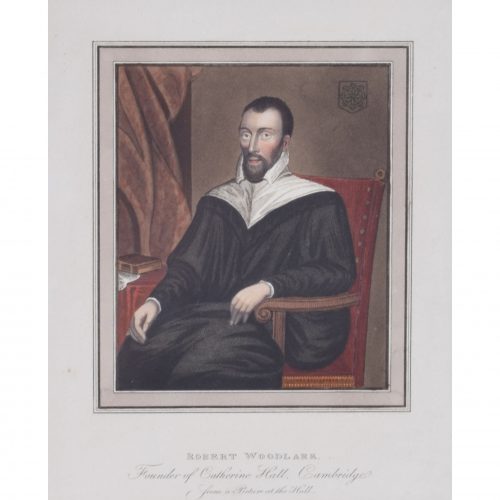
Robert Woodlark, Founder of Catherine Hall, Cambridge from a Picture at the Hall (1815)
Hand-coloured aquatint 24 x 20 cm Published by Rudolph Ackermann (1764 - 1834). A copy of this engraving is held by the National Portrait Gallery, reference NPG D4871. Robert Woodlark (also spelt Wodelarke) was an English academic and priest. He was the Provost of King's College, Cambridge, and the founder of St Catharine's College, Cambridge. He drew up the original statutes for the governance of the college and obtained a charter from Edward IV, 16 August 1475. Woodlark was a professor of sacred theology at the University and served as Chancellor of the University of Cambridge from 1459 to 1460, and again from 1462 to 1463. Rudolph Ackermann was an Anglo-German bookseller, inventor, lithographer, publisher and businessman. In 1795 he established a print-shop and drawing-school at 96 Strand. Here Ackermann set up a lithographic press and began a trade in prints. He later began to manufacture colours and thick carton paper for landscape and miniature painters. Within three years the premises had become too small and he moved to 101 Strand, in his own words "four doors nearer to Somerset House", the seat of the Royal Academy of Arts. Between 1797 and 1800 Ackermann rapidly developed his print and book publishing business, encompassing many different genres including topography, caricature, portraits, transparencies and decorative prints. Condition: good. Some gentle age toning. Handsome gilded frame with elaborate wash line mount. If you’d like to know more, please email info@manningfineart.co.uk or call us on 07929 749056. -
Out of stock
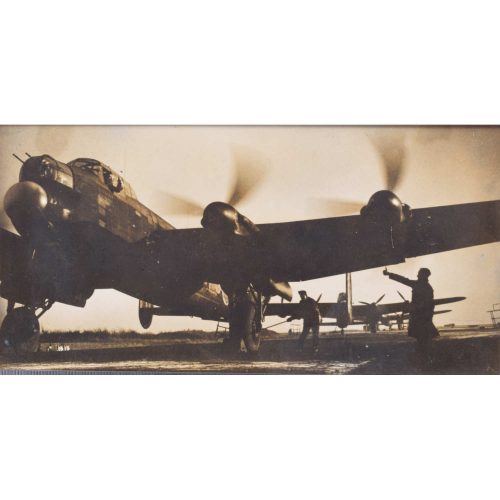
Lancaster bombers preparing for take-off
Original Silver Gelatin photograph, c. 1944 9 x 18 cm Ground crew remove the chocks from the wheel of a Lancaster bomber, prior to take-off. A series of Lancaster bombers are visible in the background, all preparing for a bombing raid, deep into occupied enemy territory. The lead aircraft is the veteran of twenty-six previous raids, as indicated by the bombs painted under the pilot's cockpit window. Condition: Generally very good. Provenance: from the collection of Philip J R Moyes, author of many books on the RAF, most notably The Pictorial History which ran to several volumes. -
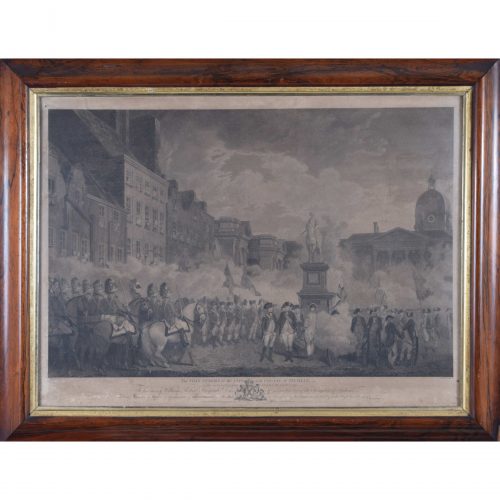
Joseph Collyer (1748 - 1827) after Francis Wheatley (1747 - 1801)
The Volunteers of the City and County of Dublin
Monochrome print 28 x 31 cm A monochrome print depicting Dublin regiments of the Irish Volunteers meeting on College Green. Francis Wheatley depicted the scene in oils in 1779, and Joseph Collyer engraved it in 1781. Wheatley went to Dublin in 1779 and established himself there as a portrait-painter; this view of the Dublin Volunteers became the basis for a best-selling print bought by numerous Irish Patriots. Volunteers were local Irish militias raised by community initiative in Ireland in 1778. Their original purpose was to guard against invasion and to preserve law and order at a time when British soldiers were withdrawn from Ireland to fight abroad during the American Revolutionary War and the government failed to organise its own militia. Taking advantage of Britain's preoccupation with its rebelling American colonies, the Volunteers were able to pressure Westminster into conceding legislative independence to the Dublin parliament. Francis Wheatley was an English portrait and landscape painter who studied at the Royal Academy, and won several prizes from the Society of Arts. He was elected an associate of the Royal Academy in 1790, and an academician in the following year. Joseph Collyer was a British engraver. In 1770 where he exhibited at the Royal Academy for the first time; he was elected an associate engraver of the Royal Academy, and appointed portrait engraver to Queen Charlotte in 1786. Condition: fair. Some browning and staining. In handsome rosewood frame. If you are interested, please email info@manningfineart.co.uk or call us on 07929 749056. -
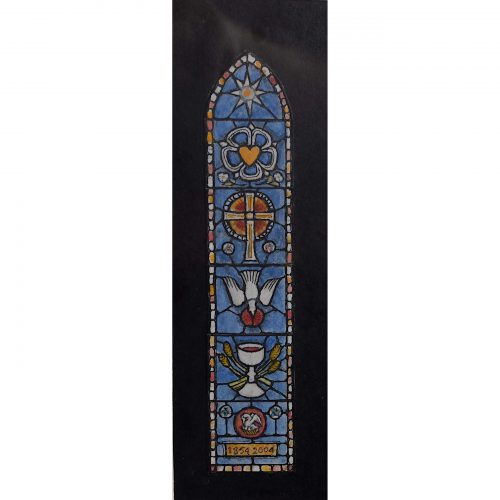
Jane Gray (b.1931)
Christ Church, Bicton, Shropshire, Design for Stained Glass Window (2005)
Watercolour 16 x 5 cmSigned, dated and studio stamp verso.
Christ Church in Bicton Heath, Shrewsbury is a fine example of an early Victorian church, built in 1854 by Edward Haycock Snr in the Early English style with many lancet features. This stained glass window above the chancel arch was commissioned to celebrate the new millennium.
Provenance: the artist’s studio sale. Condition: very good. If you are interested, please email info@manningfineart.co.uk or call us on 07929 749056. For other works by Jane Gray and more information about her, please click here. -
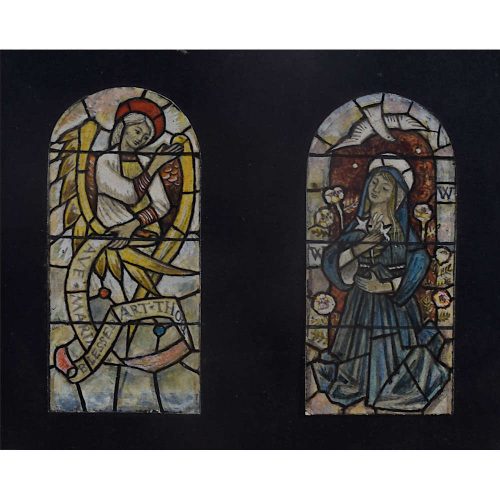
Jane Gray (b.1931)
Early Design for 'Ave Maria' Stained Glass Window (1960)
Watercolour 8 x 7cm Signed and dated verso.A rare example of Gray’s early work, this design shows a more traditional approach to stained glass window design, something that Gray came to eschew in favour of a more modern style in much of her later work. Its intended location is unknown.
Provenance: the artist’s studio sale. Condition: very good. If you are interested, please email info@manningfineart.co.uk or call us on 07929 749056. For other works by Jane Gray and more information about her, please click here. -
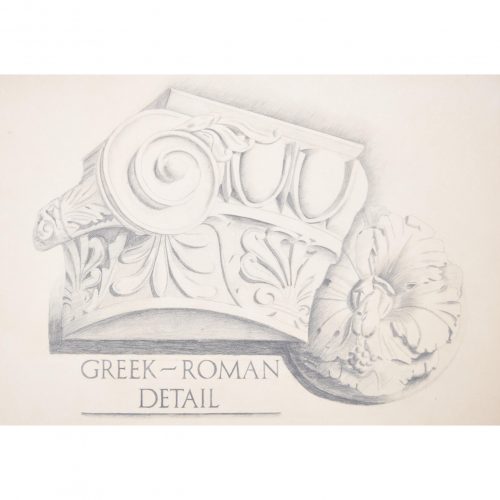
S Clapham (active 1940 - 1960)
Greek Roman Detail
Pencil 51 x 72 cm A mid-century design for a column in the neoclassical style. Clapham was an architect based in Stockwell in London. Condition: very good; mounted to board. Slight even age toning to paper. If you are interested, please email info@manningfineart.co.uk or call us on 07929 749056. Click here for other works by the artist. -
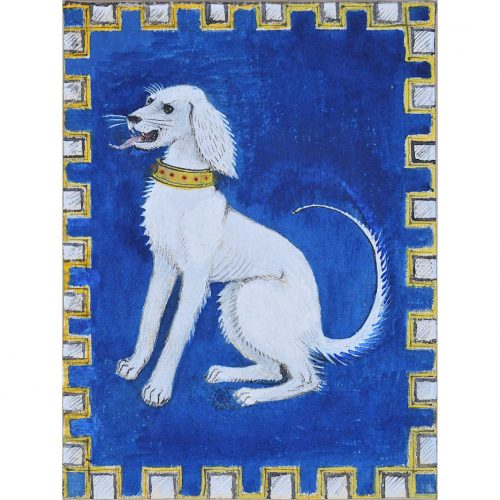
Jane Gray (b.1931)
White Dog
Gouache15.5 x 11.5 cm
This gorgeous little painting of a white dog highlights Gray’s distinctive outlook at the world; the image is at once highly traditional—as if something out of a medieval bestiary—yet also decidedly modern, bold and colourful with a striking, geometric border.
Provenance: the artist’s studio sale. Condition: very good. If you are interested, please email info@manningfineart.co.uk or call us on 07929 749056. For other works by Jane Gray and more information about her, please click here. -
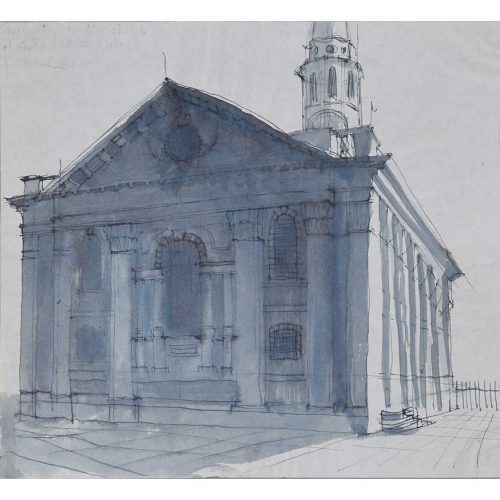
Jane Gray (b.1931)
St Martin in the Fields
Ink and watercolour18 x 19.5 cm
Detailed in the artist's handThis early architectural sketch, depicts, as Gray notes below the drawing, St Martin in the Fields, London, in blue and grey tones, and shows Gray to be an observant and sensitive draughtsman. St Martin-in-the-Fields is a Church of England parish church at the north-east corner of Trafalgar Square in the City of Westminster and is dedicated to Saint Martin of Tours.
Provenance: the artist’s studio sale. Condition: very good. If you are interested, please email info@manningfineart.co.uk or call us on 07929 749056. For other works by Jane Gray and more information about her, please click here. -
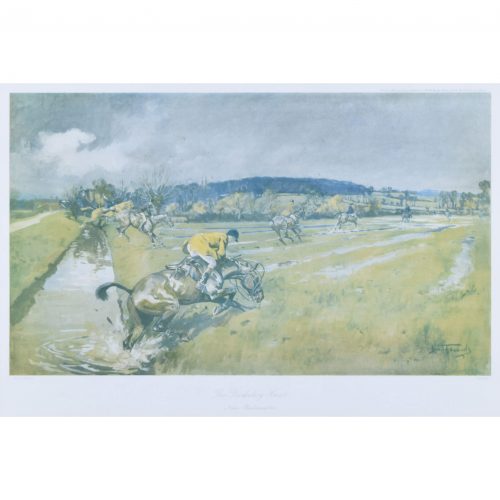
Lionel Edwards (1878 - 1966)
The Berkeley Hunt - Near Rockhampton (1925)
Lithograph 34 x 51 cm Signed in plate lower right. In original 3/4" black frame. A Lionel Edwards lithograph depicting the Berkeley - part of the artist's 1925 'Hunting Countries' series. The yellow coats with green collars and the running fox on the lapel are worn by the Masters and Hunt Staff and are unique in hunting circles, representing the outdoor livery of the Berkeley family; the ladies' colours of navy and maroon represent the indoor livery. The Berkeley is the oldest pack in the country and is one of the very few that are still family owned. The Fifth Earl of Berkeley could hunt his hounds from Berkeley Castle to Berkeley Square in London and had six kennels along the route. The season would start in Berkeley and progress to each of his kennels to London and then in stages back again to Gloucestershire. The present kennels date from the early 18th century and are home to around 90 hounds. Lionel Edwards was a British artist who specialised in pictures of country life, particularly horses, and provided illustrations for Country Life. He is best known for his hunting scenes but also painted pictures of horse racing, shooting and fishing. Condition: print generally good; the odd tiny spot in top left area. In original 3/4" black frame - some scratches to frame. If you are interested, please email info@manningfineart.co.uk or call us on 07929 749056. Click here for other hunting pictures. -

Lionel Edwards (1878 - 1966)
Foxhounds [unidentified pack] (1962)
Lithograph 31 x 43 cm Signed and dated in plate lower right. A Lionel Edwards lithograph - part of the artist's 'Hunting Countries' series. If you know which pack is depicted here, please let us know! Lionel Edwards was a British artist who specialised in pictures of country life, particularly horses, and provided illustrations for Country Life. He is best known for his hunting scenes but also painted pictures of horse racing, shooting and fishing. Condition: print generally good; some time staining to periphery. If you are interested, please email info@manningfineart.co.uk or call us on 07929 749056. Click here for other hunting pictures. -
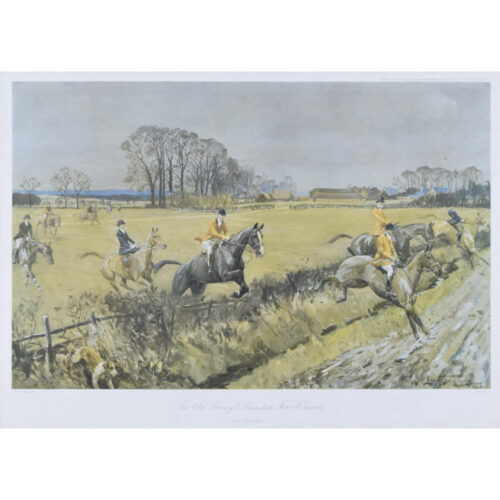
Lionel Edwards (1878 - 1966)
The Old Surrey and Burstow Fox Hounds - at Burstow (1926)
Lithograph 36 x 51 cm Signed and dated in plate lower right. In original 3/4" black frame. A Lionel Edwards lithograph depicting the Old Surrey and Burstow - part of the artist's 'Hunting Countries' series. The Old Surrey and Burstow (now the Old Surrey, Burstow and West Kent Hunt) has been hunting from Felbridge since 1909. The Burstow dates as a foxhound pack from 1866, having previously existed as a harrier pack. Lionel Edwards was a British artist who specialised in pictures of country life, particularly horses, and provided illustrations for Country Life. He is best known for his hunting scenes but also painted pictures of horse racing, shooting and fishing. Condition: print generally good; the odd tiny spot in top right corner. In original 3/4" black frame; some scratches to frame. If you are interested, please email info@manningfineart.co.uk or call us on 07929 749056. Click here for other hunting pictures. -

Lionel Edwards (1878 - 1966)
The Hertfordshire Hunt (1927)
Lithograph 36 x 50 cm Signed and dated in plate lower left. A Lionel Edwards lithograph depicting the Hertfordshire - part of the artist's 'Hunting Countries' series. The Hertfordshire Hunt was founded circa 1775 by the Countess of Salisbury, of Hatfield House. Lionel Edwards was a British artist who specialised in pictures of country life, particularly horses, and provided illustrations for Country Life. He is best known for his hunting scenes but also painted pictures of horse racing, shooting and fishing. Condition: print generally good; a couple of tiny scuffs to surface. Modern frame. If you are interested, please email info@manningfineart.co.uk or call us on 07929 749056. Click here for other hunting pictures. -
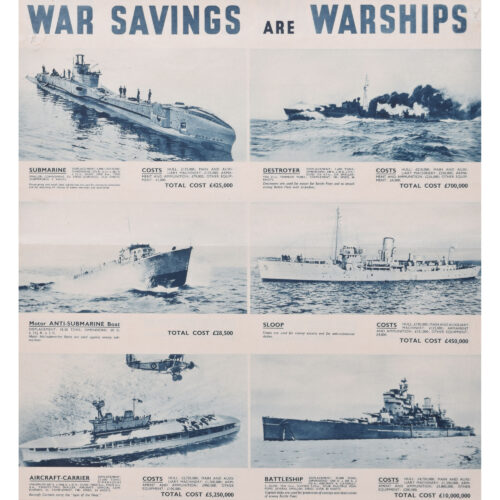
War Savings are Warships / The Signal is Save
Original vintage poster 41 x 37 cm Issued by the National Savings Committee, London, the Scottish Savings Committee, Edinburgh, and the Ulster Savings Committee, Belfast. An original vintage WW2 poster encouraging Britons to save via the National Savings scheme, which would use the money to fund warships. Condition: generally very good; central fold as issued, two pin holes to top corners only. Double sided. If you are interested, please email info@manningfineart.co.uk or call us on 07929 749056. Click here for other original vintage National Savings posters. -

D. L. Hadden
Design for tapestry
Watercolour 25x50cm If you are interested email info@manningfineart.co.uk or call us on 07929 749056.


